The Patagonian Icefields
Friday, March 15, 2024
- Patagonia
I actually wanted to continue driving again after 5 days in Puerto Aysen. However, I really liked it here and the weather forecast for the next few days didn't look very rosy.

In the end I waited 10 days until an ideal time window presented itself for my onward journey. There is a saying: If you hurry in Patagonia, you are wasting your time (El que se apura en Patagonia, pierde su tiempo).

Saying goodbye to Marcelo and this beautiful town was not easy for me. First I drove a little way up the Rio Aysen to the mouth of the Rio Blanco. A few kilometers further up the river I took the ferry across to the other side.

My first destination was Lago Portales. This is one of several lakes here in the Aysen region.
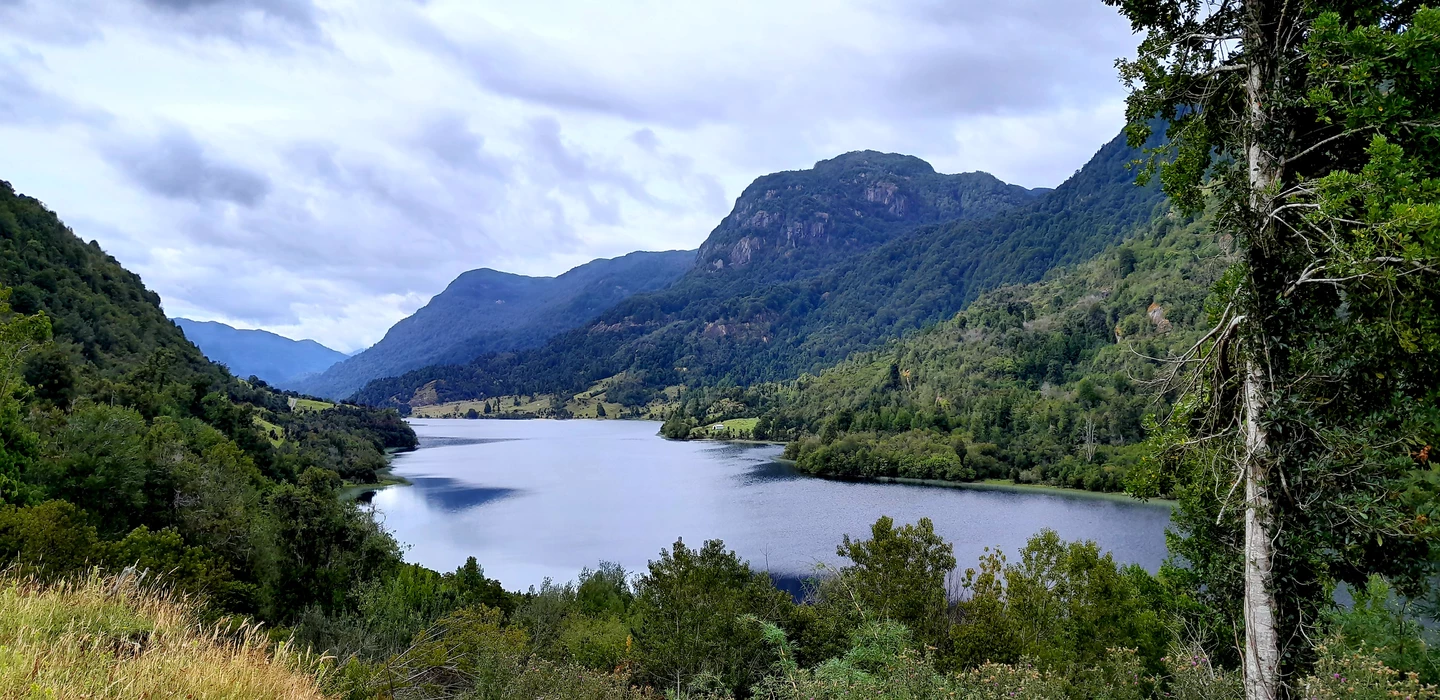
At the official embarkation point I met a family who lives on the other side of the lake. The weather was cloudy at this time of day, but relatively calm.
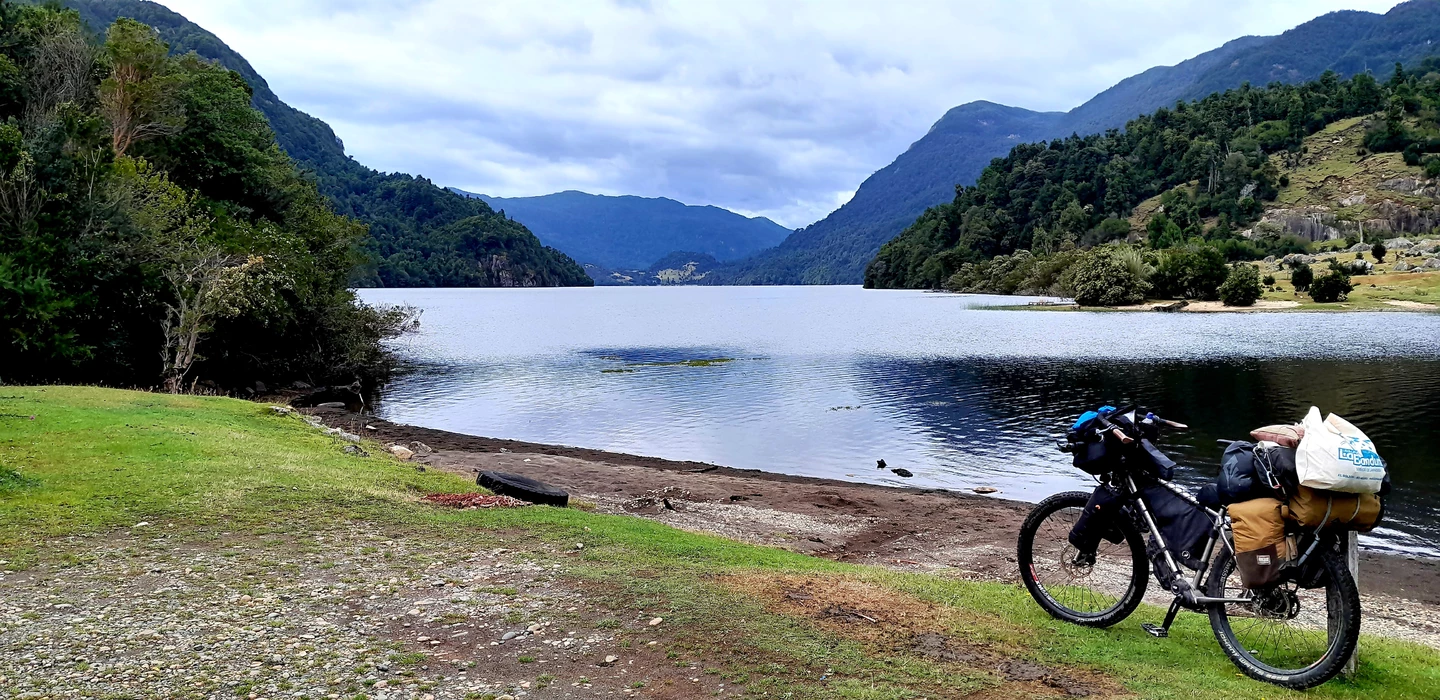
However, the wind slowly increased and when I was ready after about an hour, the first waves were already forming.
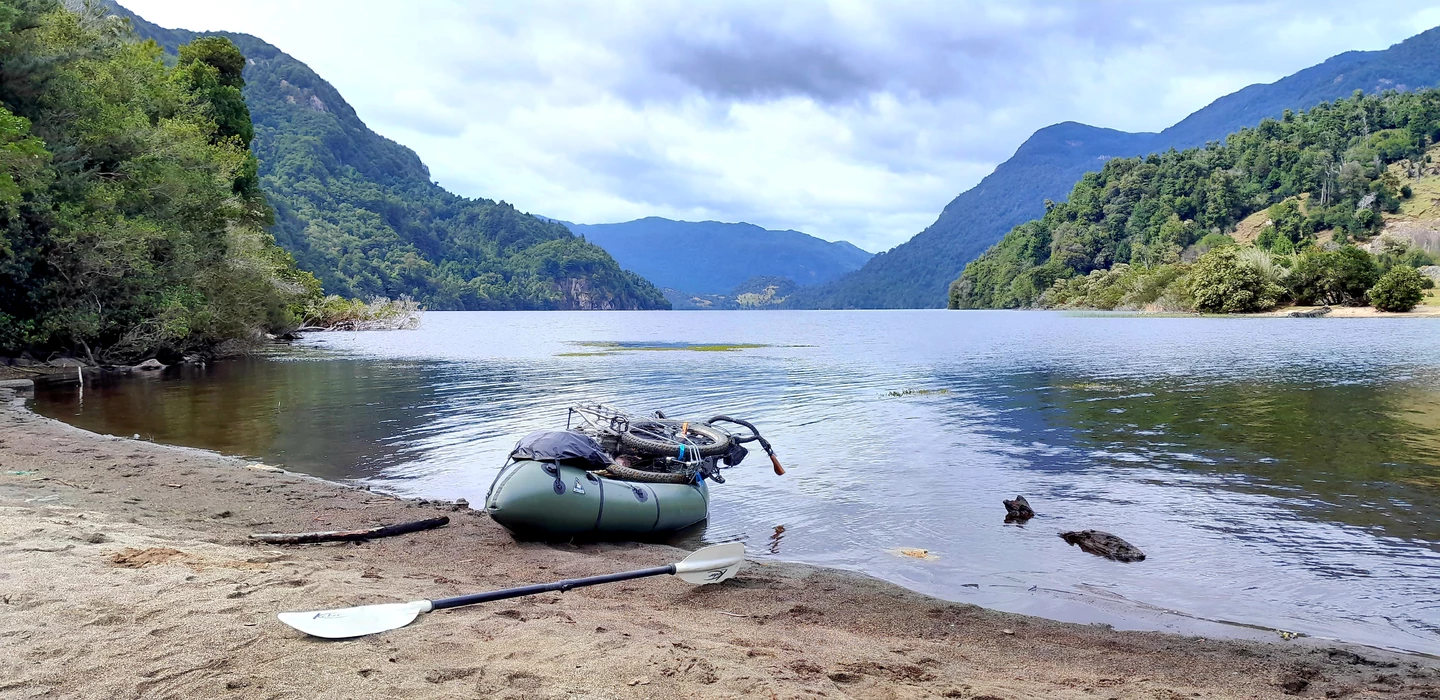
Luckily the wind was blowing from behind. I paddled up the lake along the shore and after an hour reached the place where you normally walk across to Lake Zenteno.

However, I didn't feel comfortable continuing the journey alone in this weather. That's why I decided to switch back to the bike on the southeast side of Lago Portales.
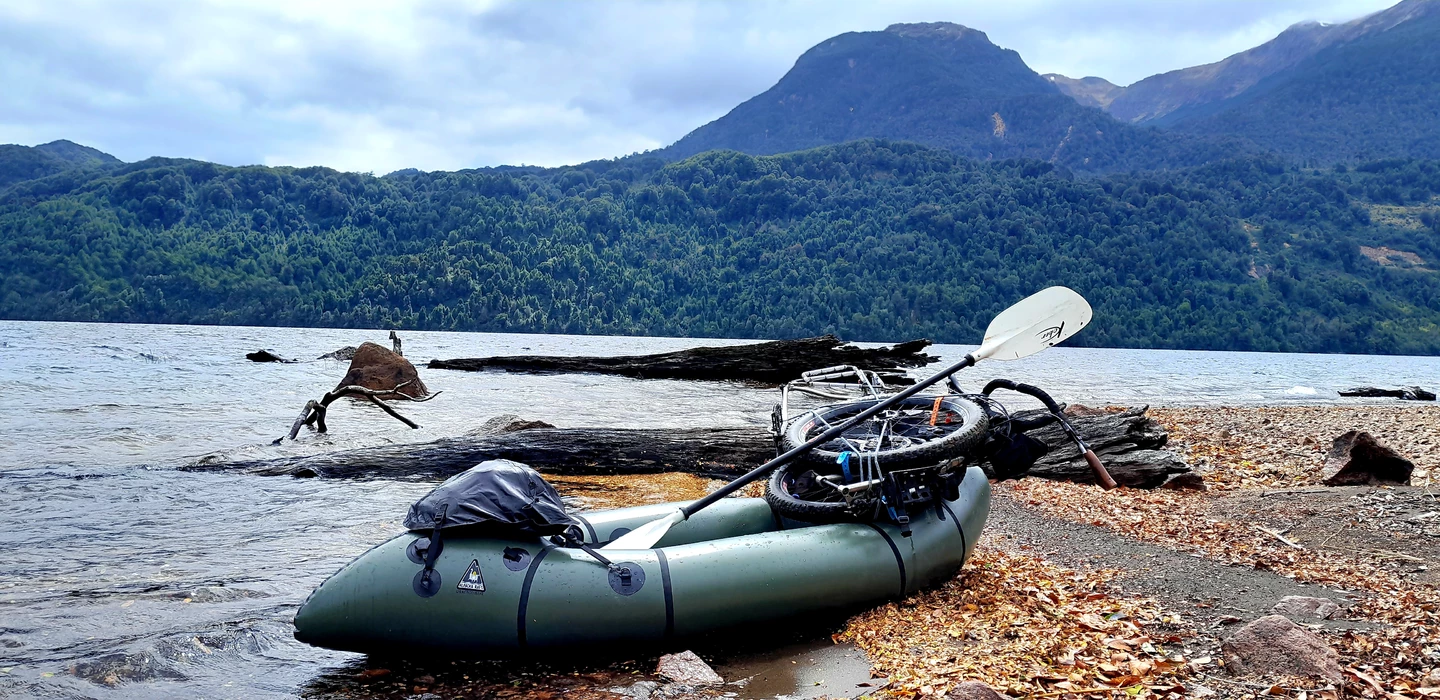
After I got out of the boat and put everything back on the bike, I continued cycling on Ruta 608 for another hour until I found a nice campsite right on a river bank.
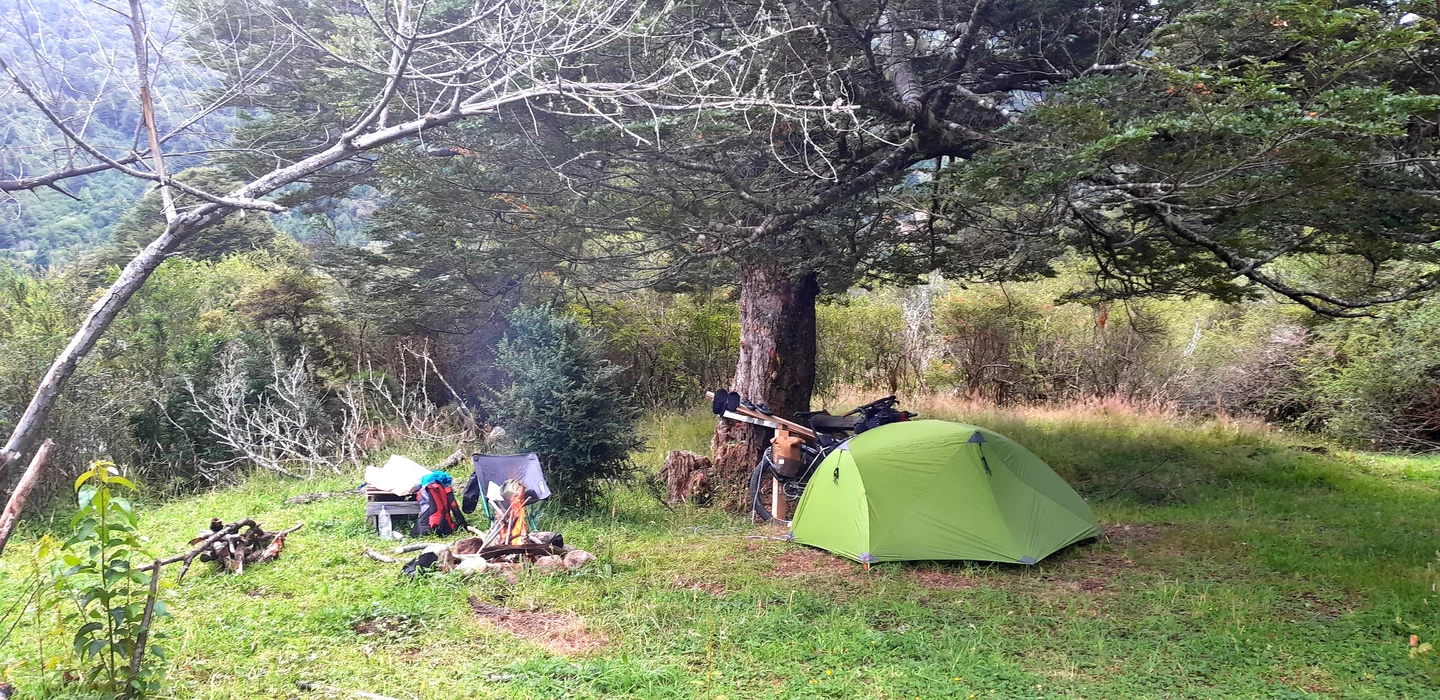
The mood the next morning was almost like autumn. A light mist hung over the landscape and the temperatures were cool.
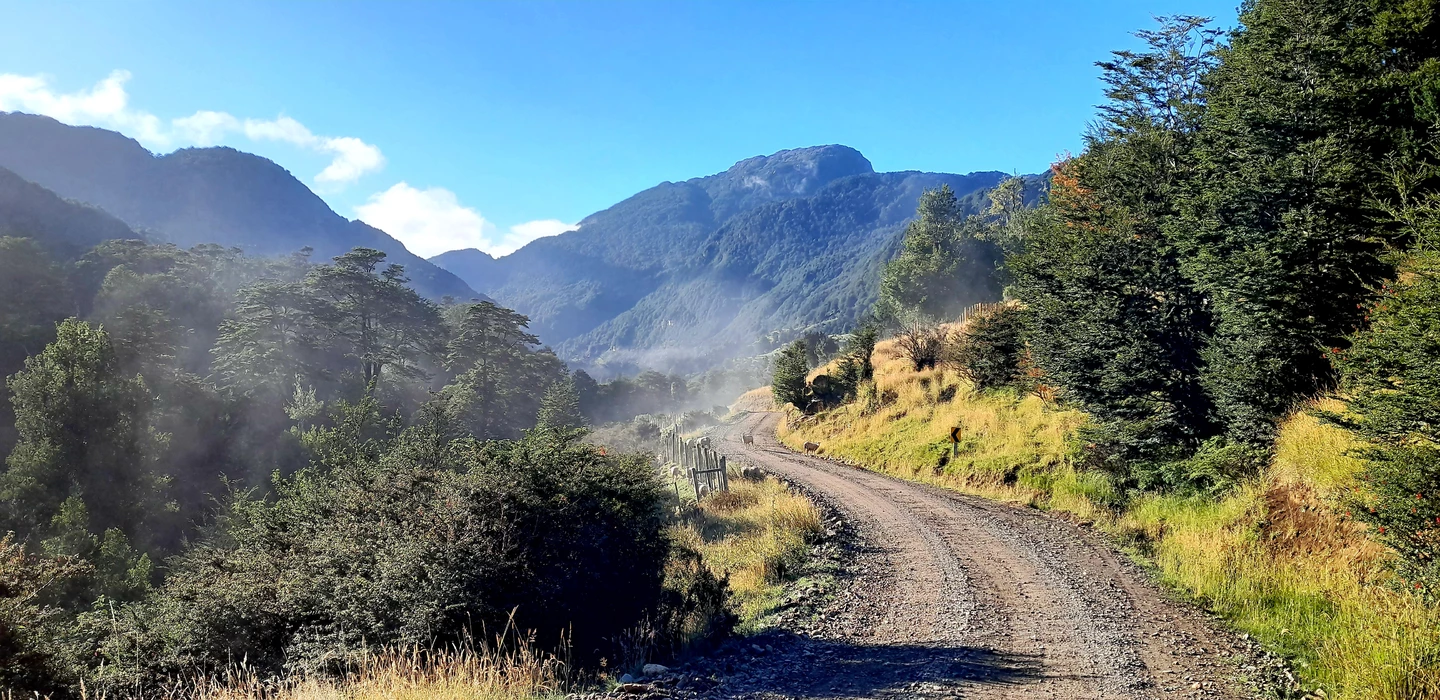
My stomach was bothering me in the morning and I had mild diarrhea. After just a few kilometers I reached the waterfall on the Rio Colorado.
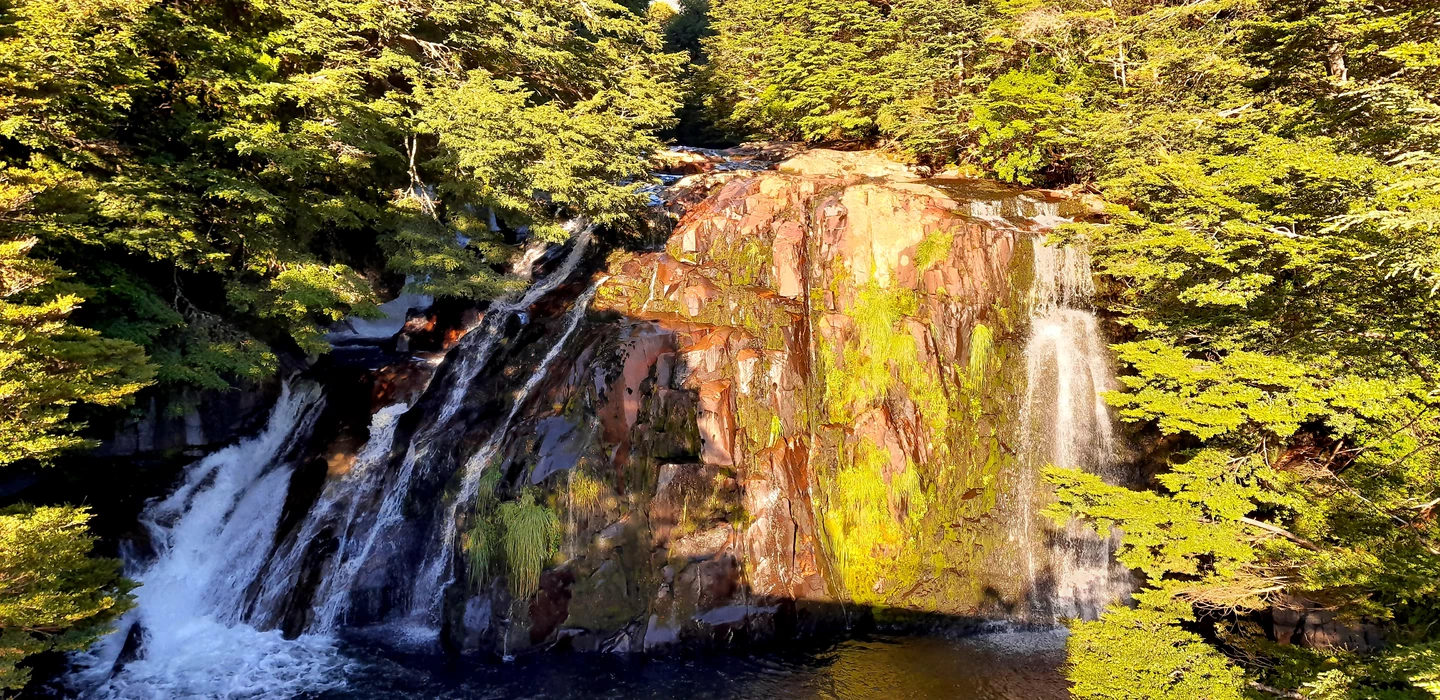
I really liked this part of the route in terms of scenery and there was almost no traffic on the gravel road here.
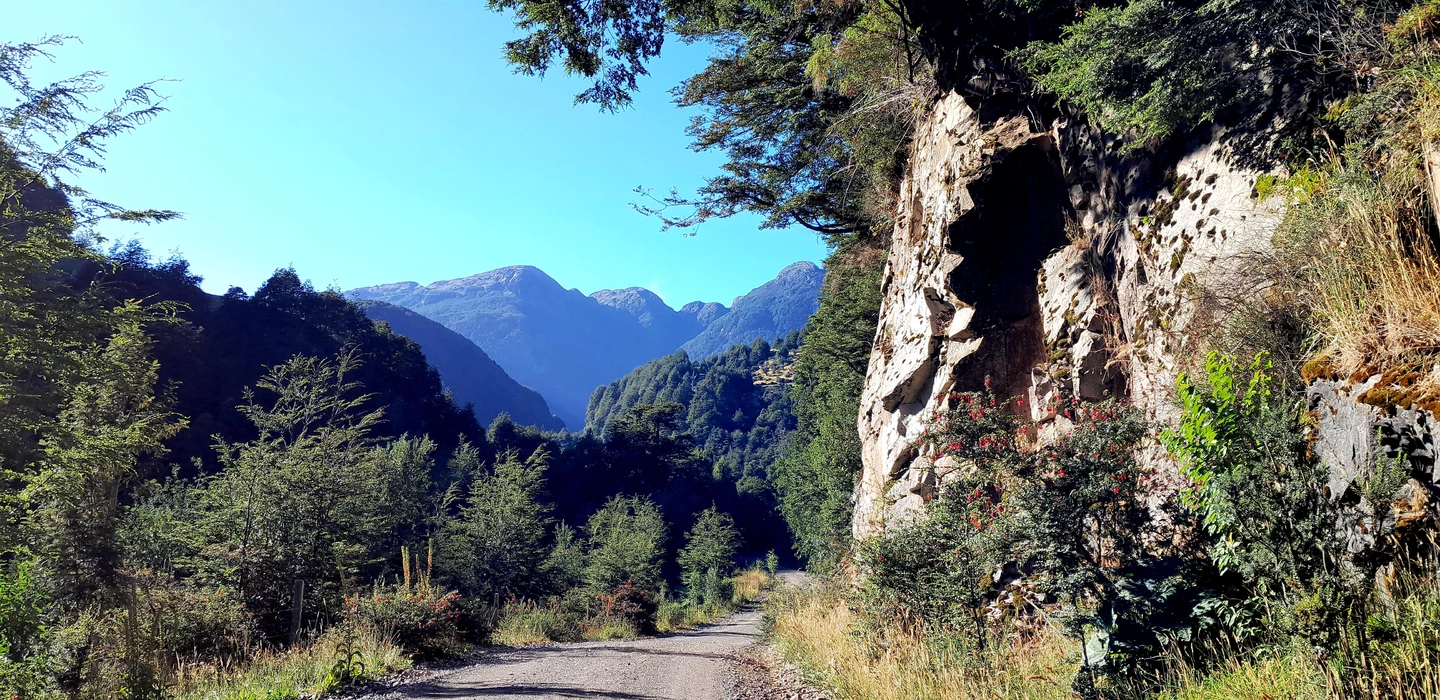
I reached Lake Atravesado around midday. This is where I planned the next sea crossing. However, the weather forecast for the next few days didn't look good and I wanted to cover as much distance as possible by bike.
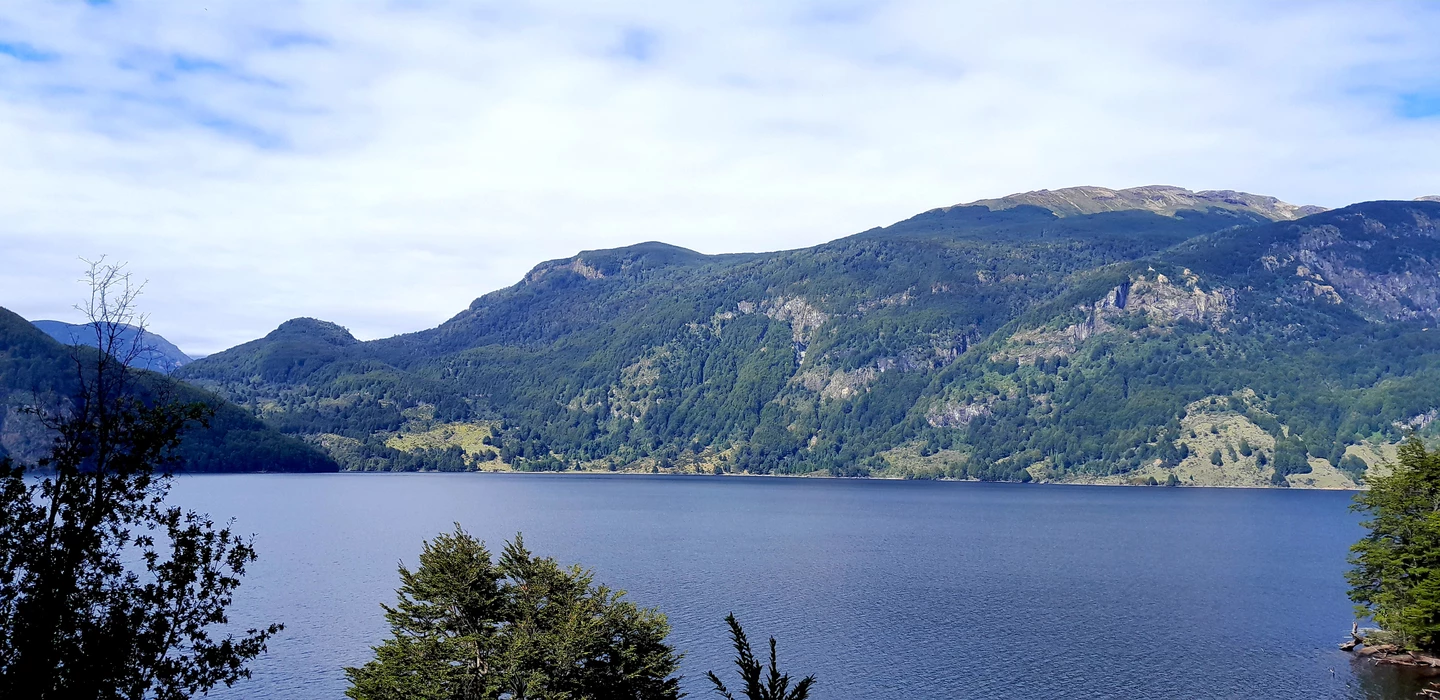
A few kilometers later came the town of Villa Lago Atravesado, where I was able to shop in a minimercado. Unfortunately from here the traffic increased significantly and the temperatures also rose.
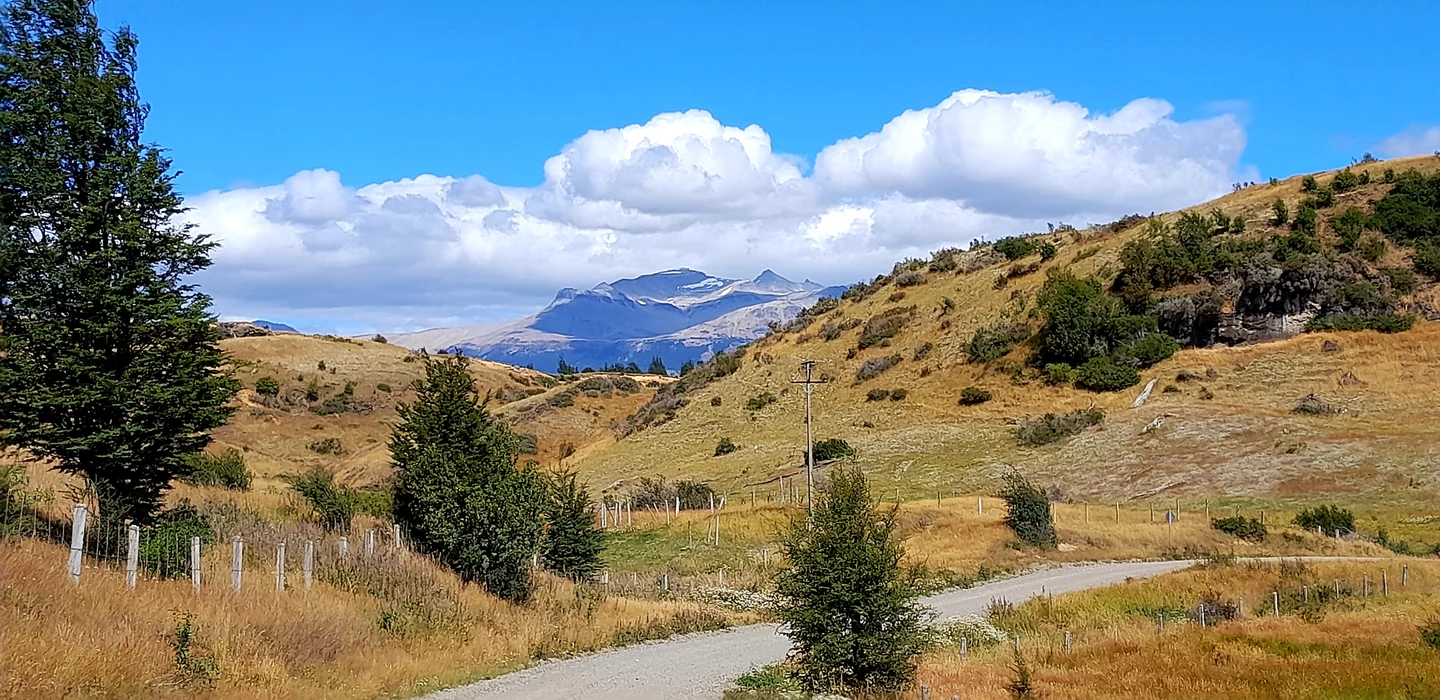
The landscape here is much less green and everything is fenced off on both sides of the road. On weekends, many locals from the city come here to relax.
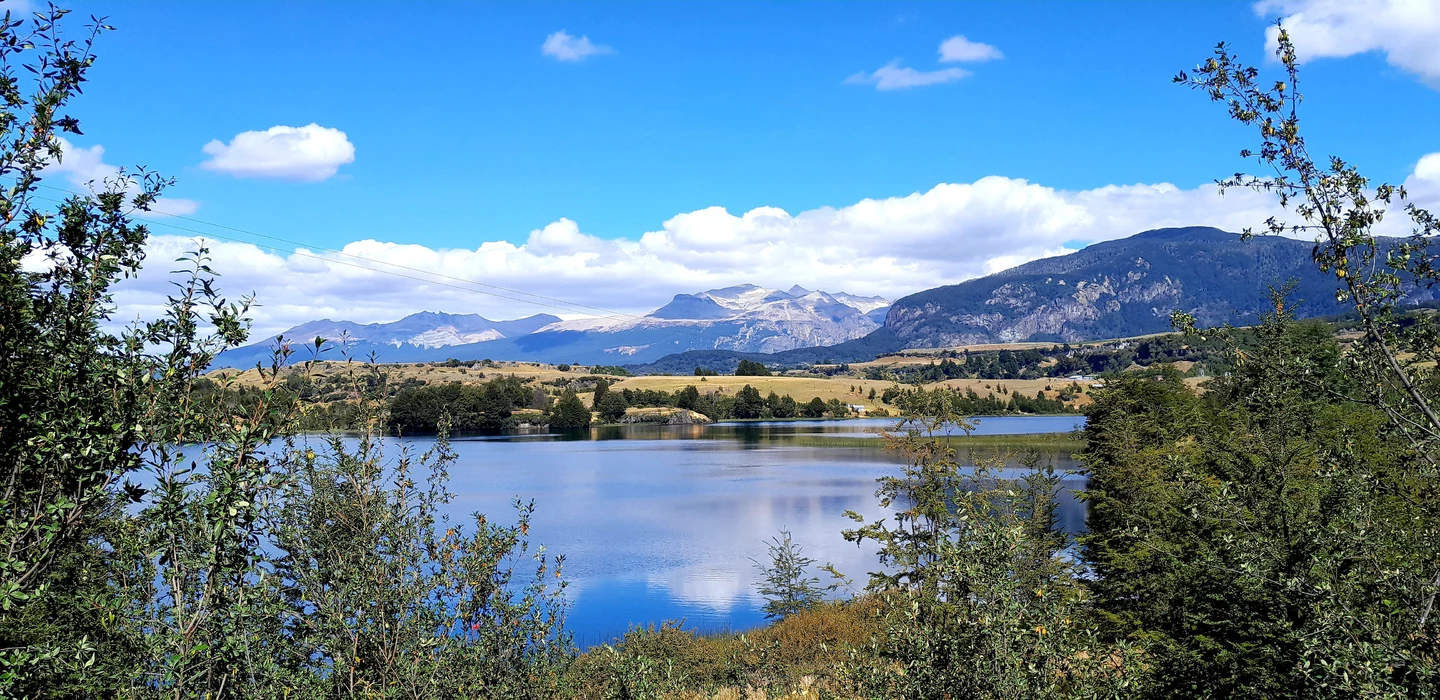
On the Ruta Seis Lagunas to the town of Villa Frei the traffic was still fairly light. Afterwards there was so much traffic on the gravel road that I was literally covered in dust. In moments like this, here in Chile, I feel like a prisoner in a cage full of dust and I'm the vacuum cleaner in it.
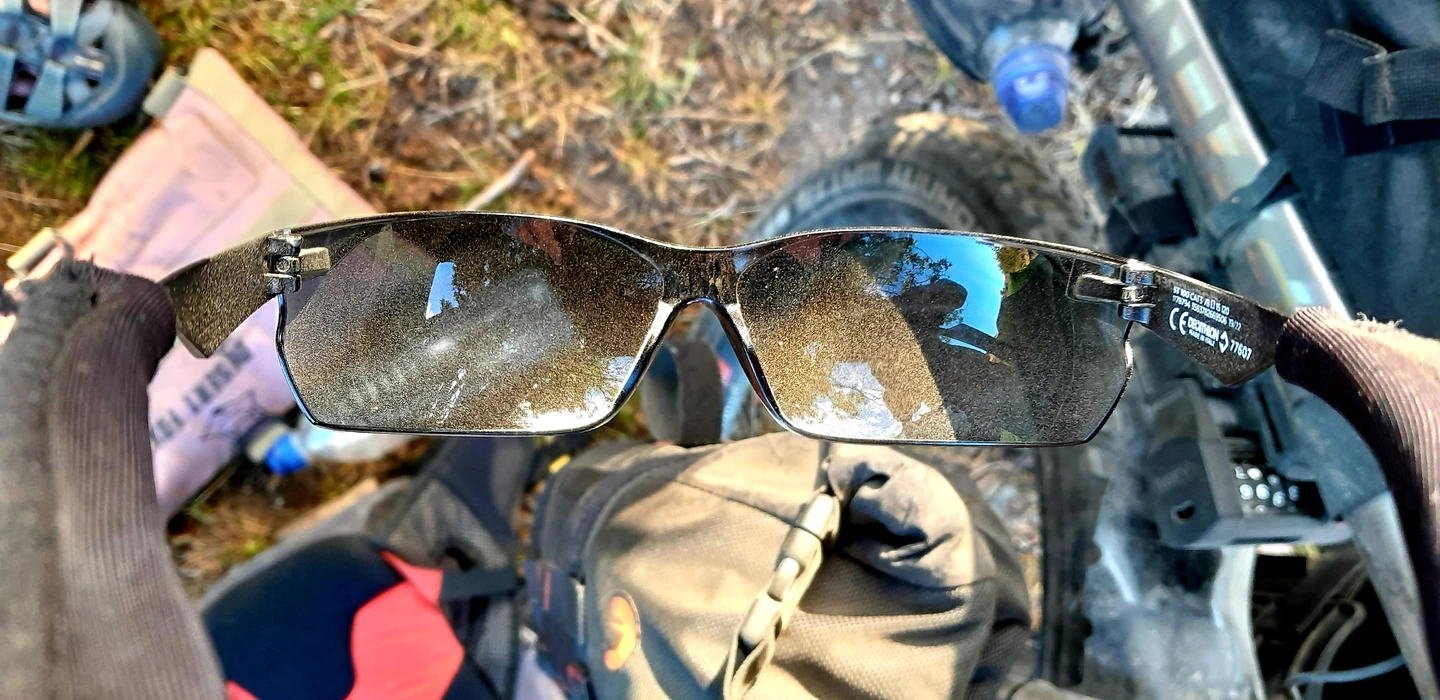
It wasn't until nightfall that I finally found a gate that I could open and set up my tent behind. Even my sunglasses were completely dusty from all the traffic.

That day I fell into my sleeping bag, dead tired and once again annoyed by the inconsiderate Chilean drivers. My middle finger was in constant use today.
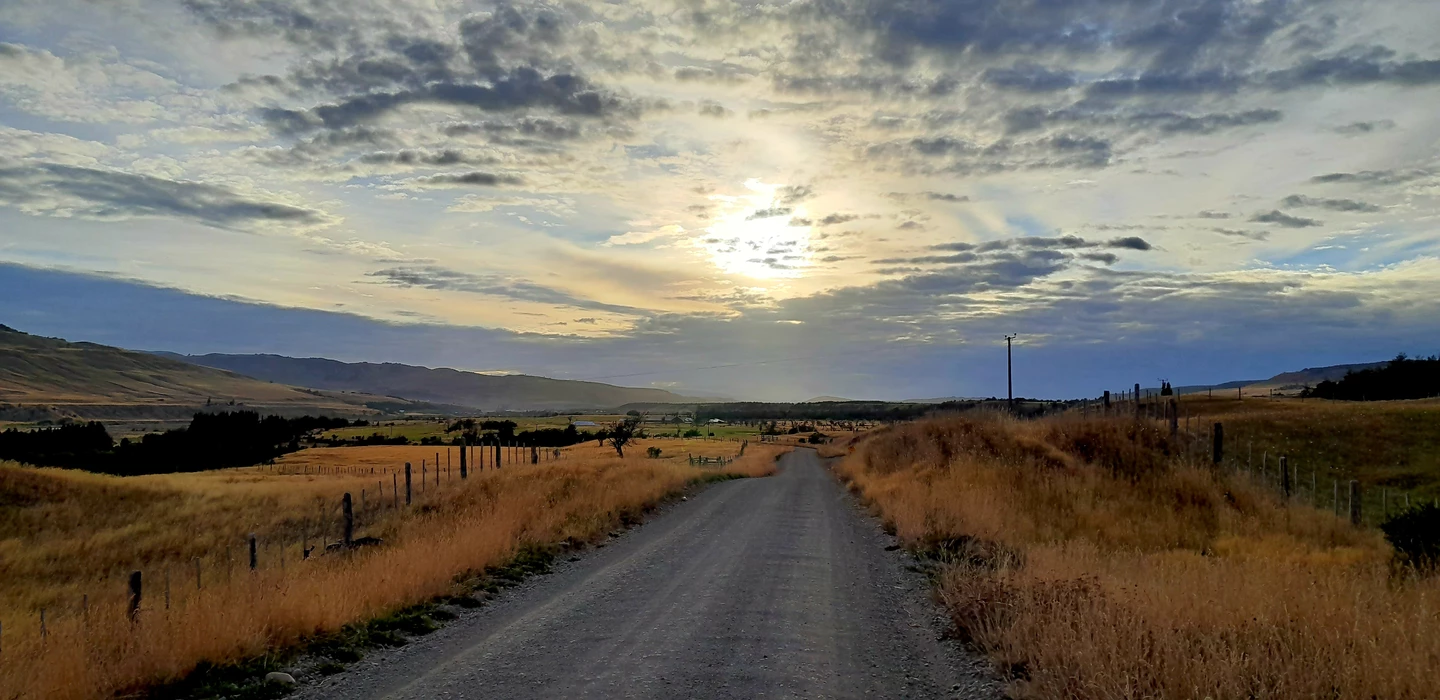
The next day started with a beautiful sunrise. After a few kilometers I reached the town of El Blanco. This is where I encountered the Carretera Austral for the first time.
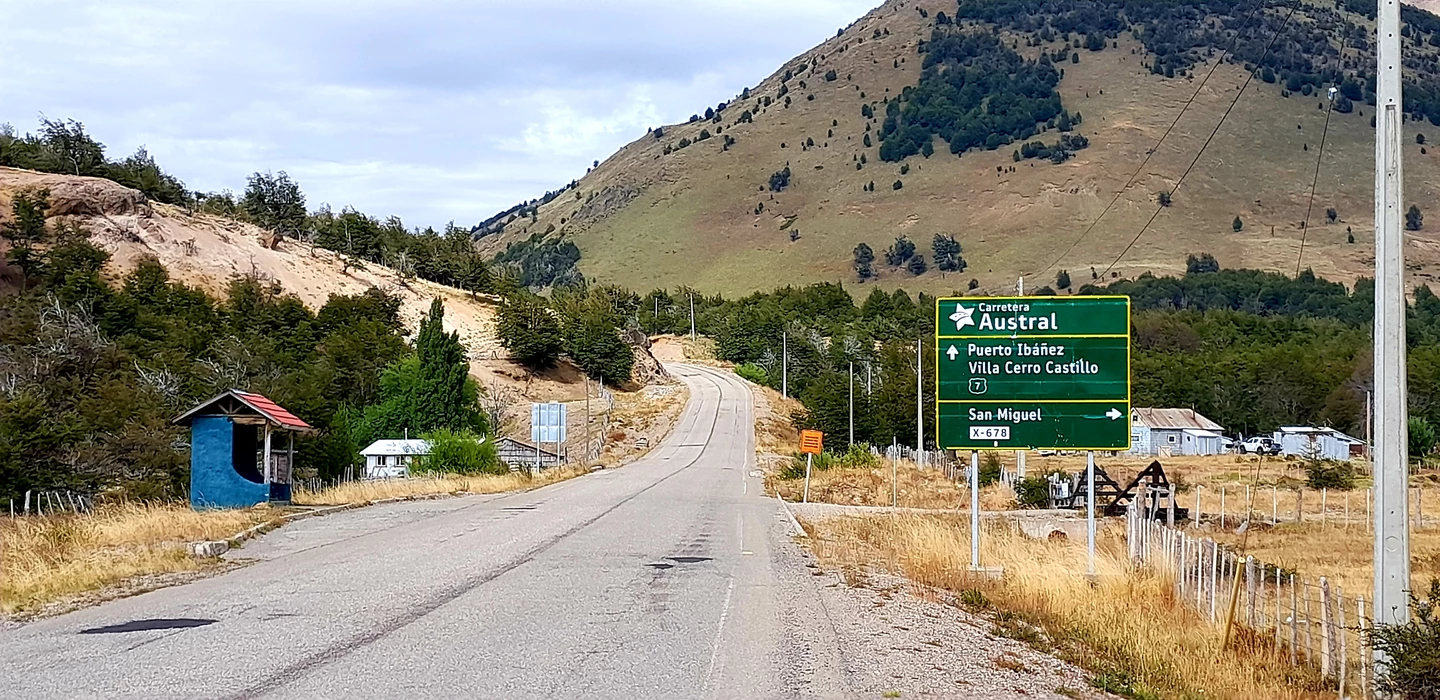
In 1976, under the military dictatorship of Augusto Pinochet, construction work began on the Carretera Austral (translated: southern highway). The starting point were military considerations to secure Chile's southern border against Argentine claims. More than 10,000 soldiers and 200 million US dollars were used for the construction.
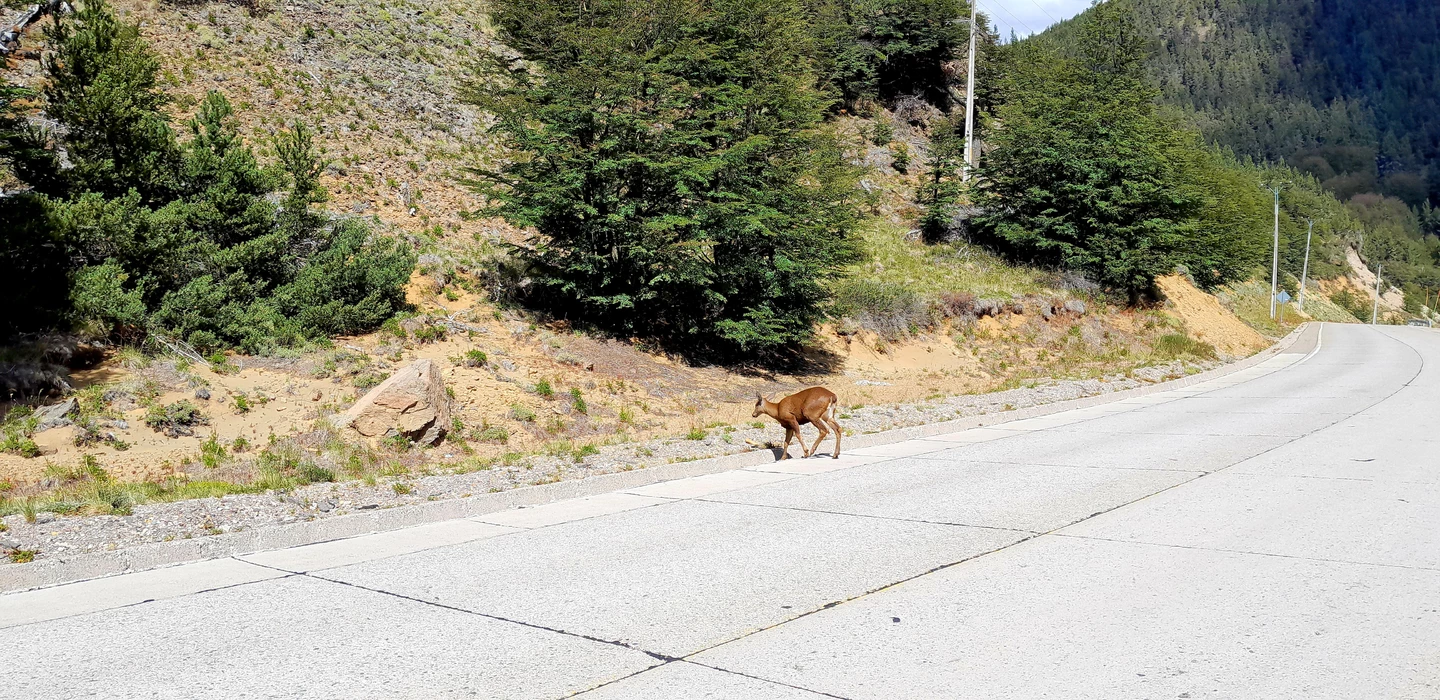
Although there is significantly more traffic here, the road is asphalted. Right at the entrance to Cerro Castilo National Park, a huemul (South Andean deer) ran across the road in front of me.
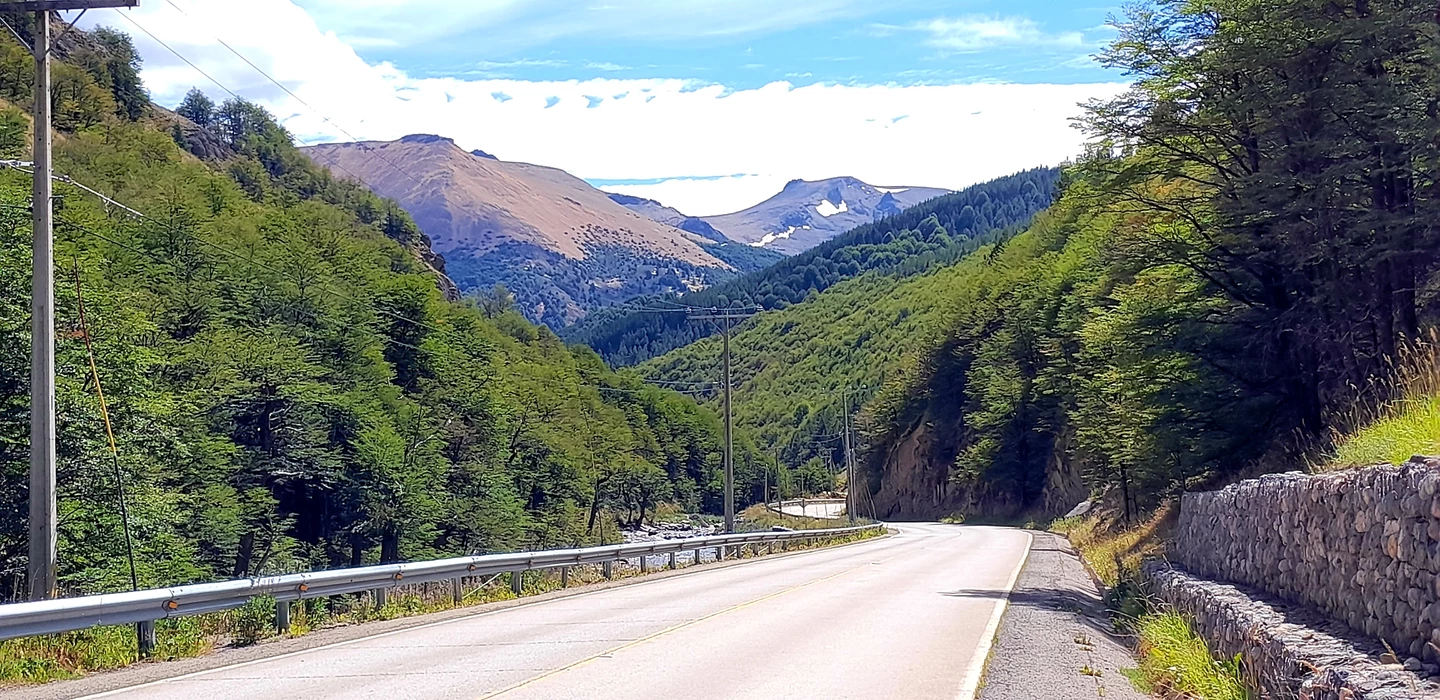
The landscape here is very beautiful. However, my stomach was giving me quite a problem. It was almost constant going up the mountain. Diarrhea is not ideal at a time like this.

At around 4 p.m. I ran out of energy and pitched my tent in a wooded area next to the road. Towards the evening the weather slowly changed.
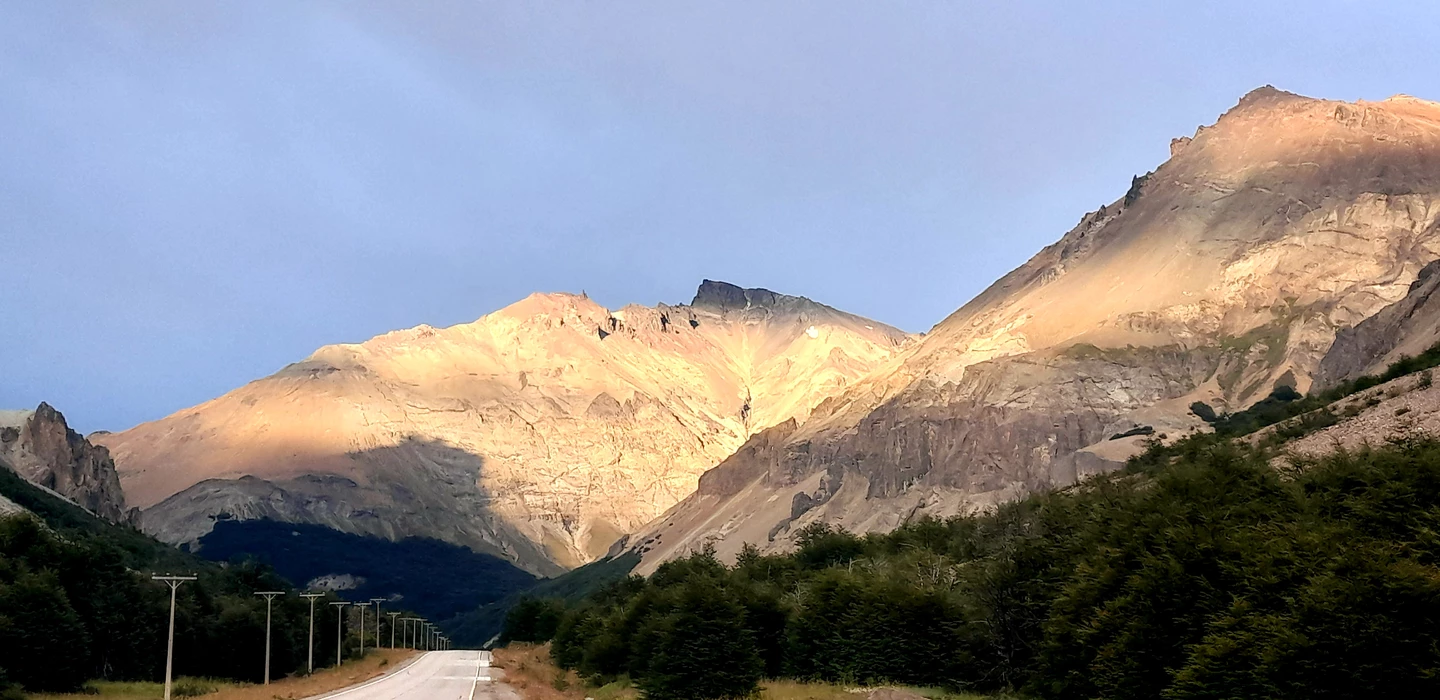
A good portion of sleep helped me to overcome the last few meters of altitude the next morning. As I drove down it started to rain lightly.
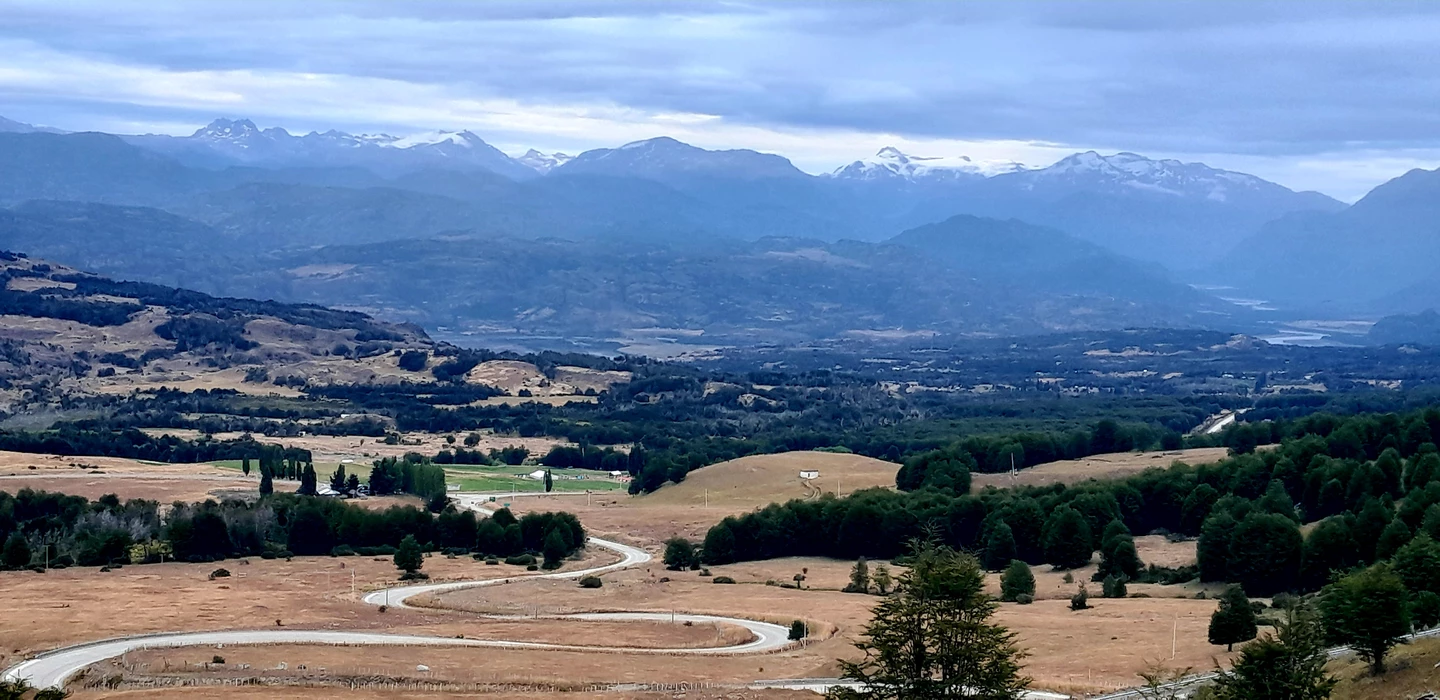
Despite the bad weather, you could see Cerro Castillo (2,675 m above sea level) clearly. Castillo means castle in Spanish and the steep basalt walls actually look a bit like it.

A short time later I turned off the Carretera Austral and continued cycling towards Puerto Ingeniero Ibanez. I passed several lagoons. Among other things, at Laguna Morales.
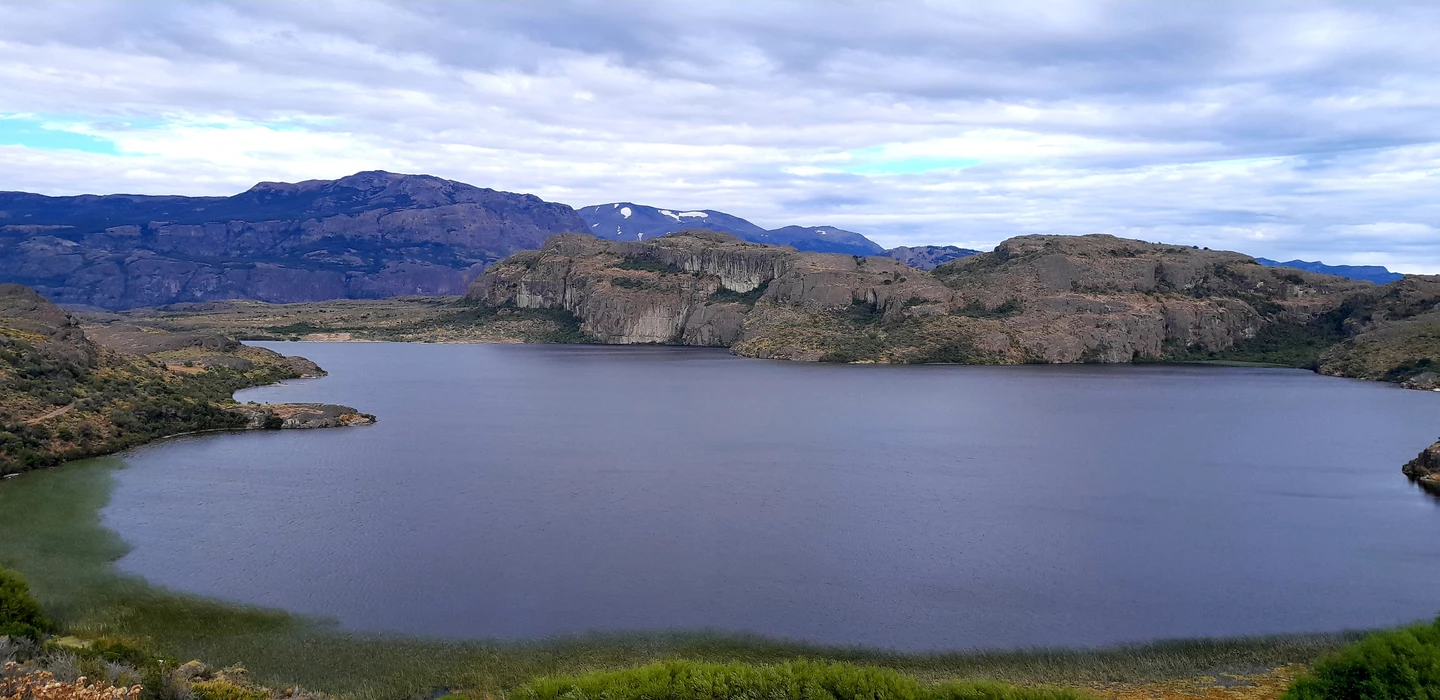
A few kilometers from the town, a cyclist from Lausanne came towards me. We agreed to meet for the Festivelo at the end of November (https://www.festivelo.ch) this year and said goodbye to each other afterwards.

When I arrived in Puerto Ingeniero Ibanez, I first hit the first supermarket I came across and treated myself to a second breakfast.
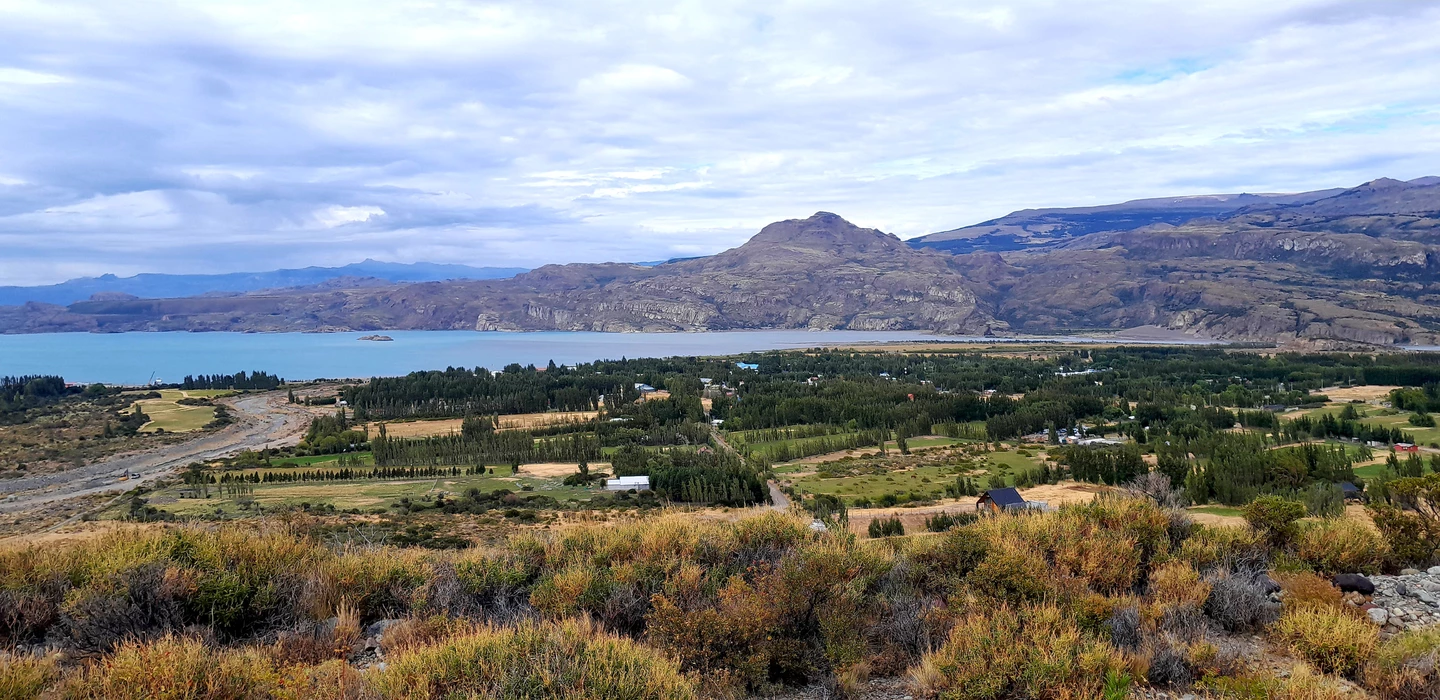
From here a ferry takes you across Lake Buenos Aires / General Carrera. Actually, I just wanted to briefly check at the port when the next ferry to Chile Chico was leaving. However, there was a boat in the harbor and I was able to get on just in time.
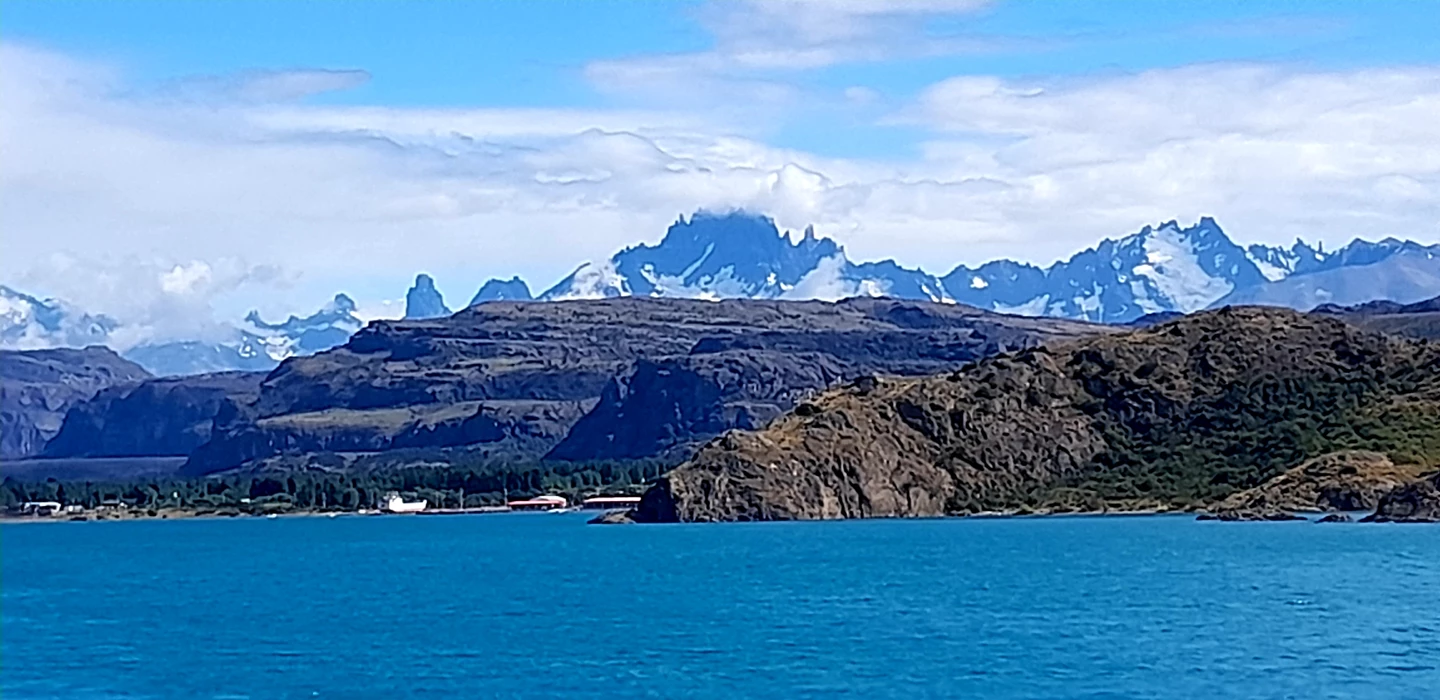
Lago Buenos Aires / General Carrera is the second largest lake in South America (after Lake Titicaca), has a total area of 1,850 km², is more than 200 km long and almost 590 m deep. Its water flows first into Lago Bertrand and then into the Rio Baker.
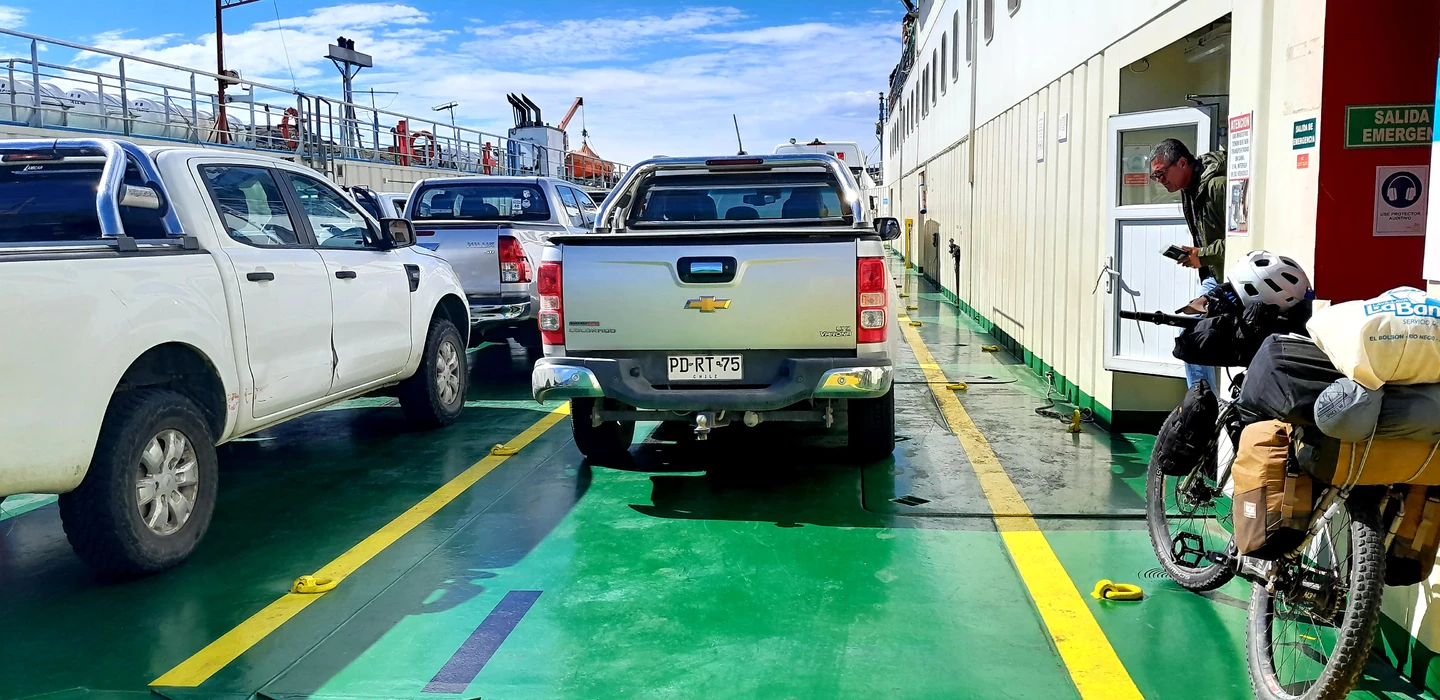
On the ferry I chatted with a few photographers from Rome during the 2 hour crossing. One of them said that the dimensions of the landscape here in Patagonia are difficult to capture with a camera. I can only agree.

In Chile Chico I found the camping No Me Olvides an ideal place for a day of rest. Maria, the owner, offers accommodation in her orchard for a maximum of 5 tents.

Chile Chico is known for its microclimate. Fruits such as apricots and cherries ripen particularly well here. In 1971 and 1991 the city was covered by large ash showers from the Cerro Hudson volcano.
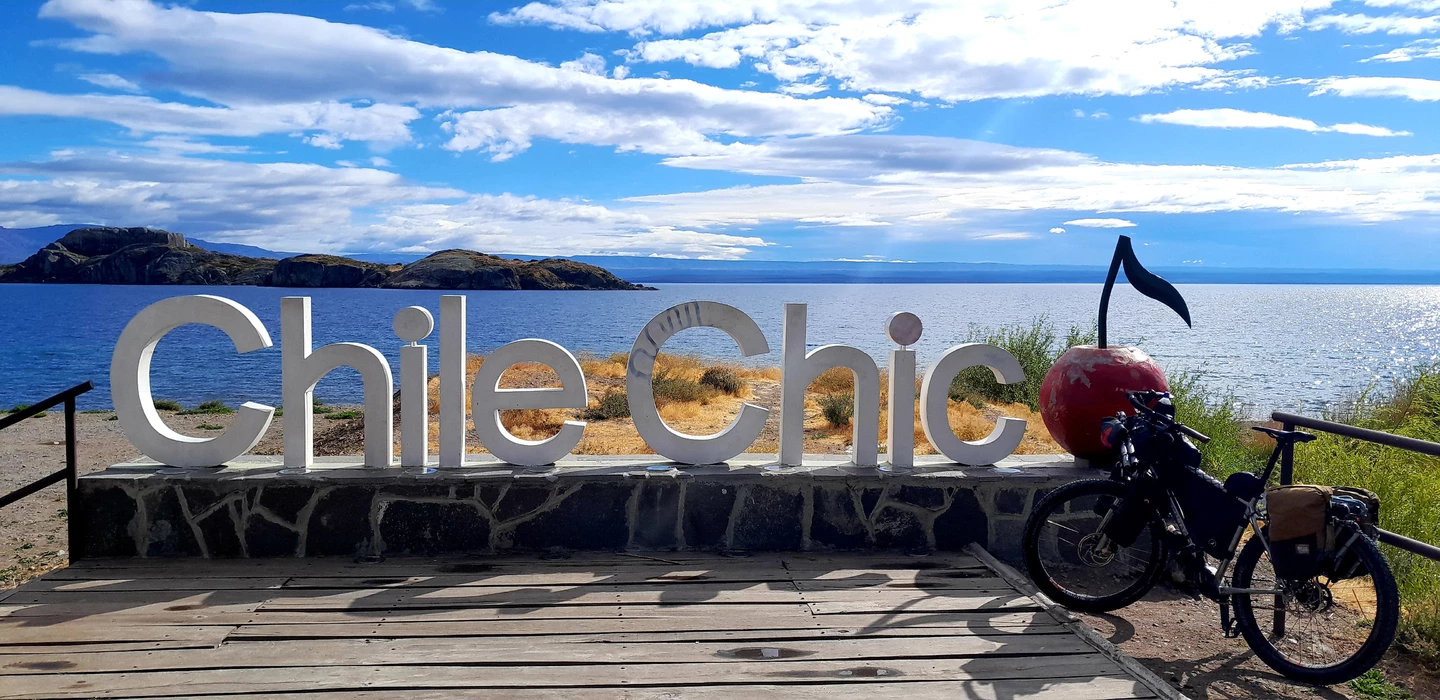
The viewpoint is located a little above the town, where you can enjoy a beautiful view of the lake and the surrounding area. However, it is also very windy here.
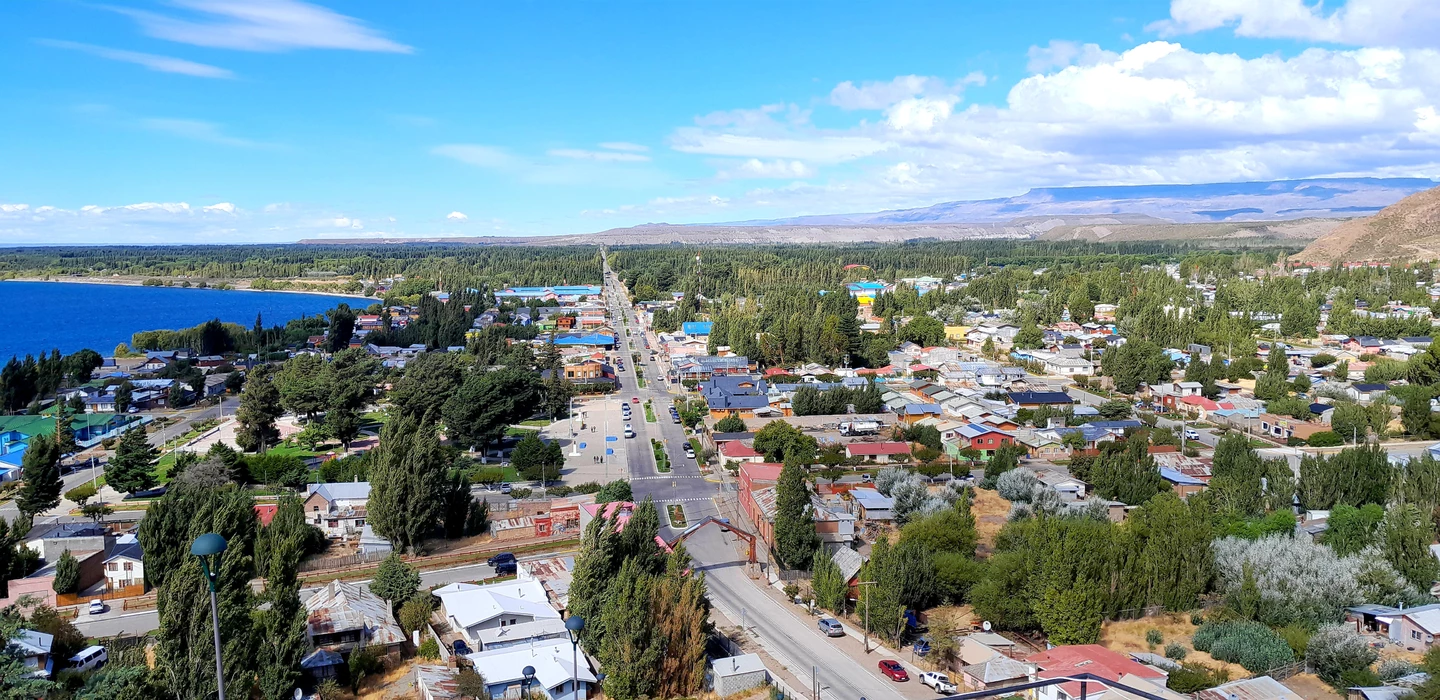
Maria invited me to dinner. The weather for the next 3 days seemed to be somewhat ideal. Only the forecast for the wind didn't seem quite optimal.

First I crossed the border into Argentina the following day. The customs officials on both sides were friendly and prompt. I skipped a visit to Los Antiguos because I still had a few kilometers to cover that day.
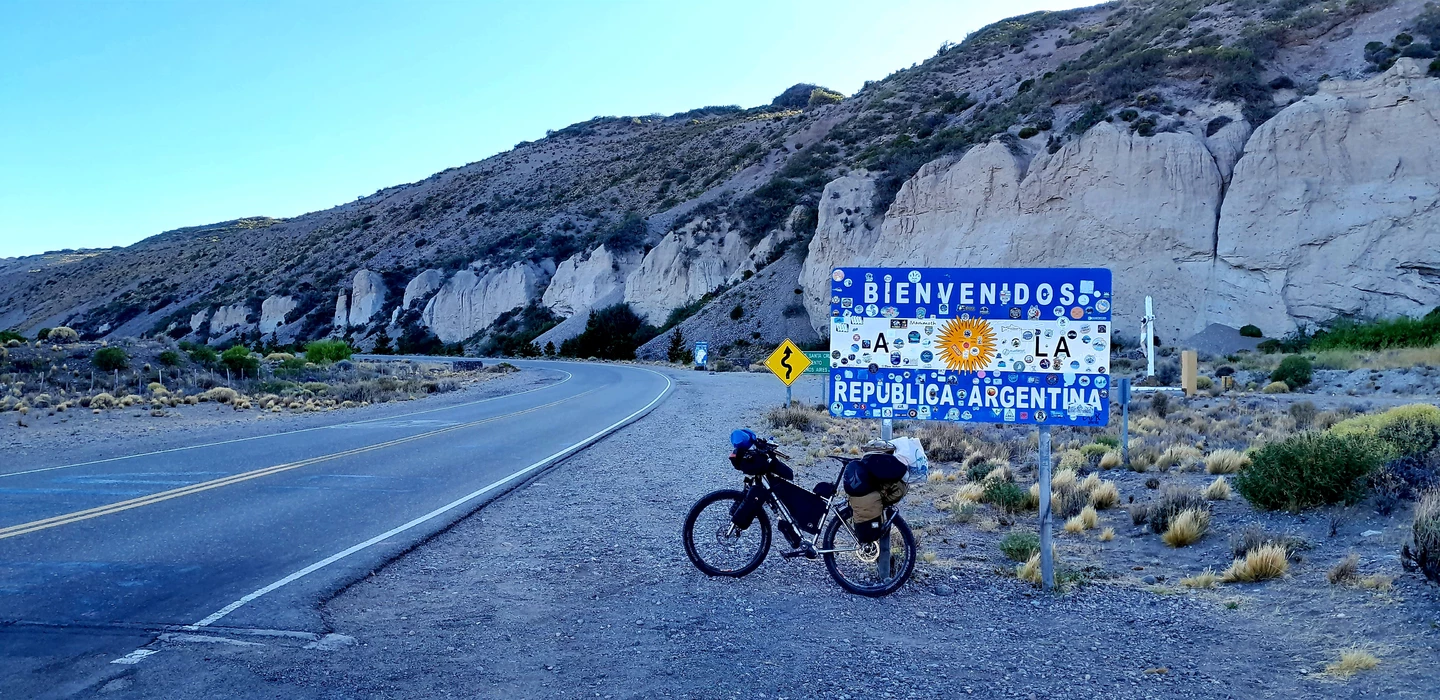
Immediately after the border crossing I went on Ruta Provincal 41. This leads along the Rio Jeinimeni. Here on the Argentine side the gradients are not as extreme as in Chile and are therefore much easier to overcome by bike.
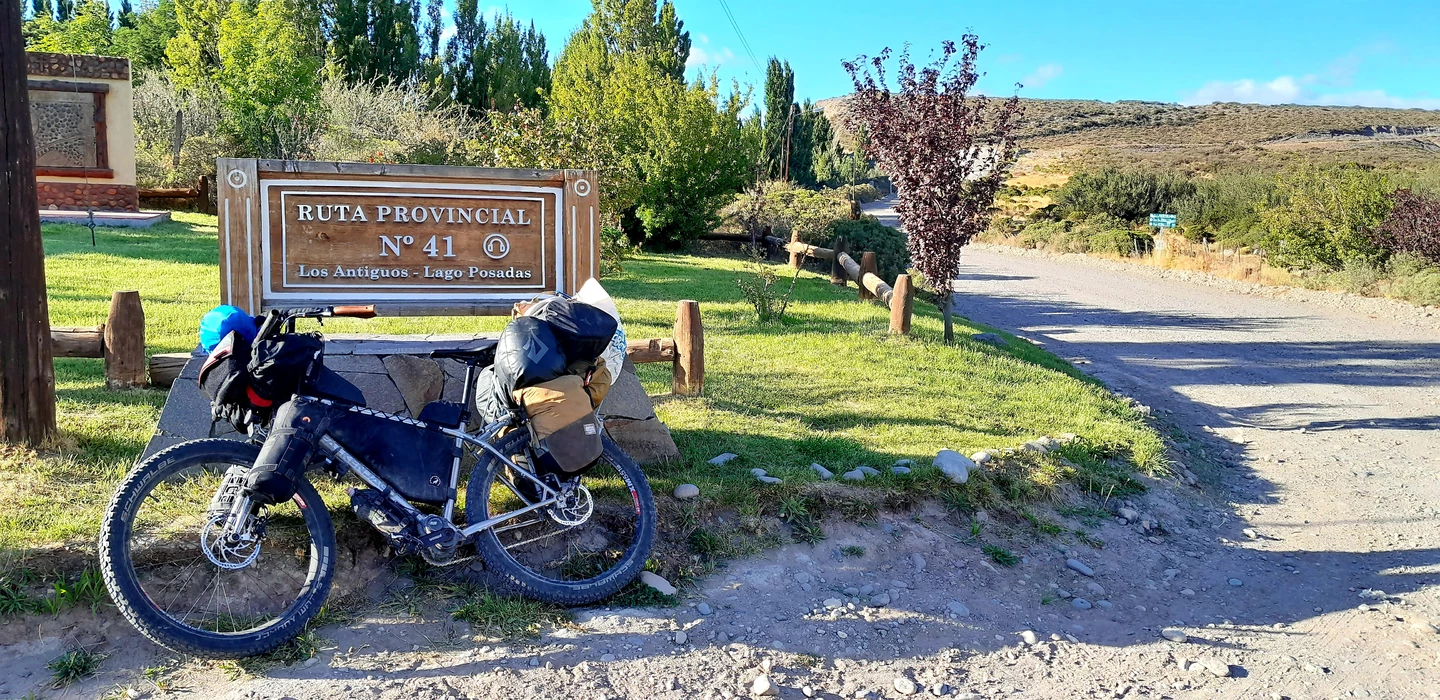
I found it particularly impressive how quickly the landscape changes here. As soon as you are a few kilometers from the river and lake there are no trees left. Just a few isolated small bushes.

There are also very few fences here and practically no traffic, which I liked right from the start. This was exactly why I chose the route.
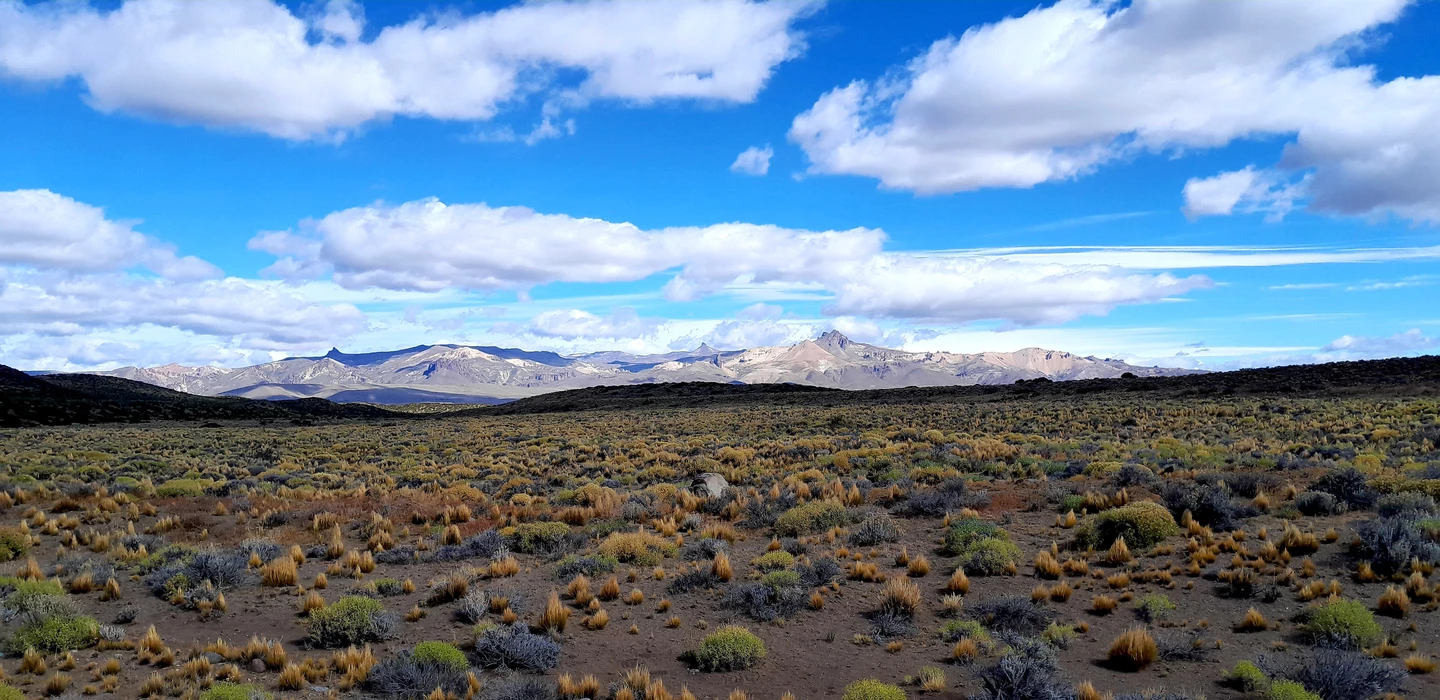
However, the gravel roads here in Argentina are not in particularly good condition. You drive practically constantly on endless corrugated roads. Just like in Chile.

The play of colors was incredible and I hardly heard any other noises apart from the wind. In total I saw less than 10 vehicles today. A stark contrast to the traffic on the Carretera Austral.

Unfortunately, my digestion still hadn't fully recovered and I occasionally had to take refuge behind a bush again. Here, too, you can often see monuments commemorating traffic victims. Given the driving style of the locals here, that doesn't surprise me at all.
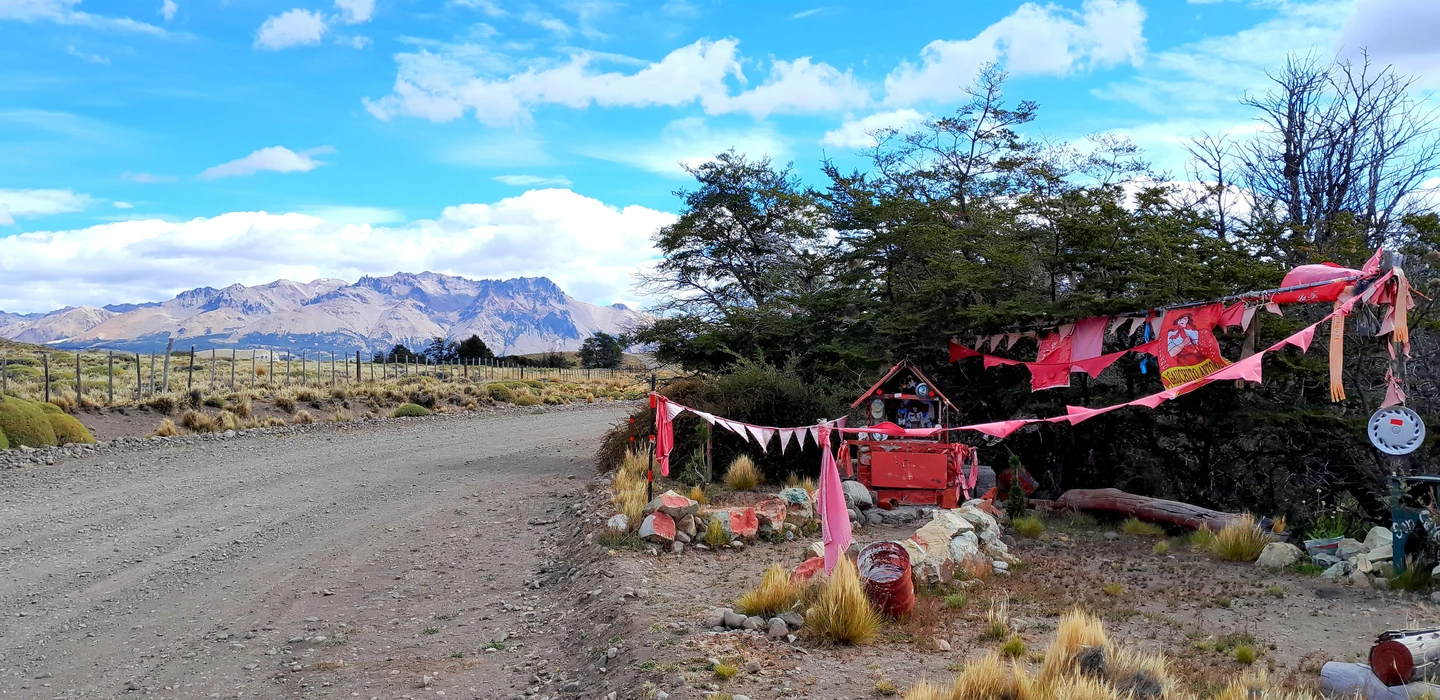
The wind increased more and more in the afternoon. At times I had the feeling that it was blowing from all directions. Once I wasn't paying attention for a moment when a gust of wind came from the side. My front wheel immediately got stuck in the sand and I ended up on the road.

Luckily nothing happened to me and Siemis (my bike) and a short time later I reached the bridge over the Rio Zeballos.
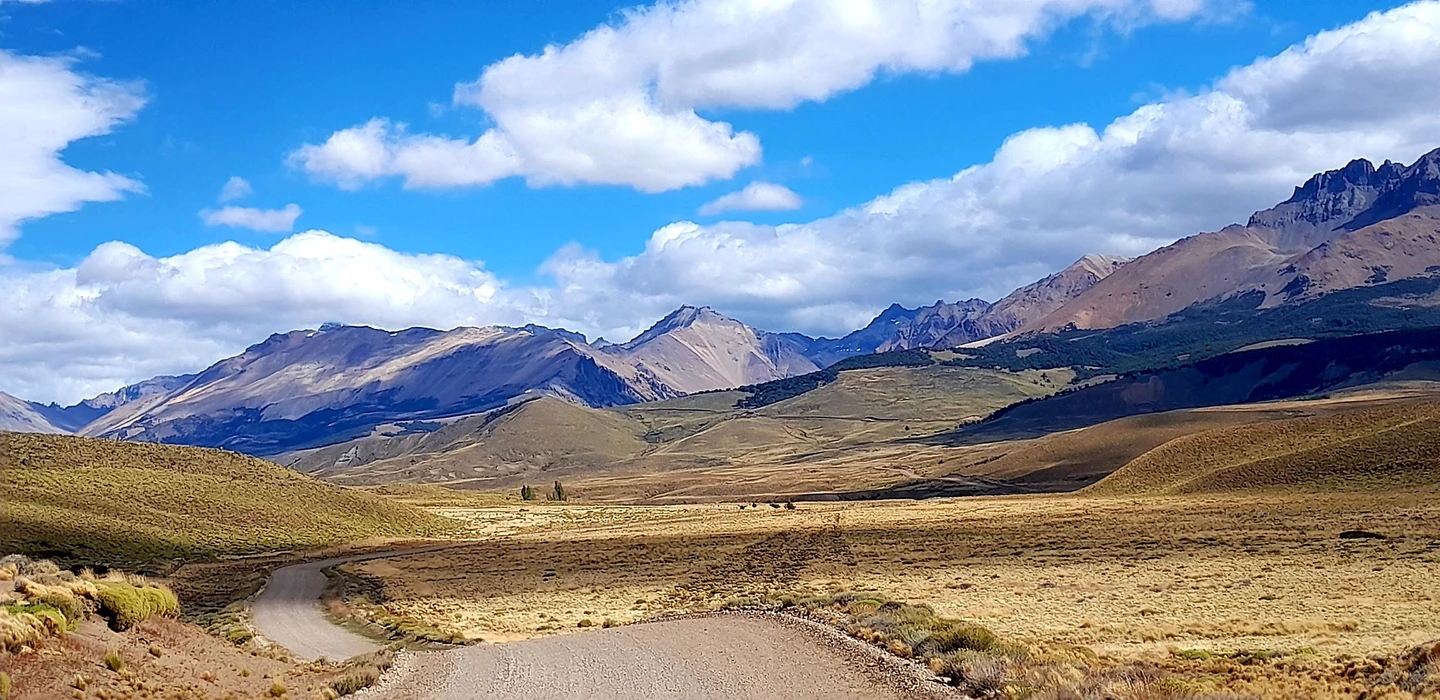
The route led more and more into the mountains. The wind slowly died down and the first trees and small streams appeared.
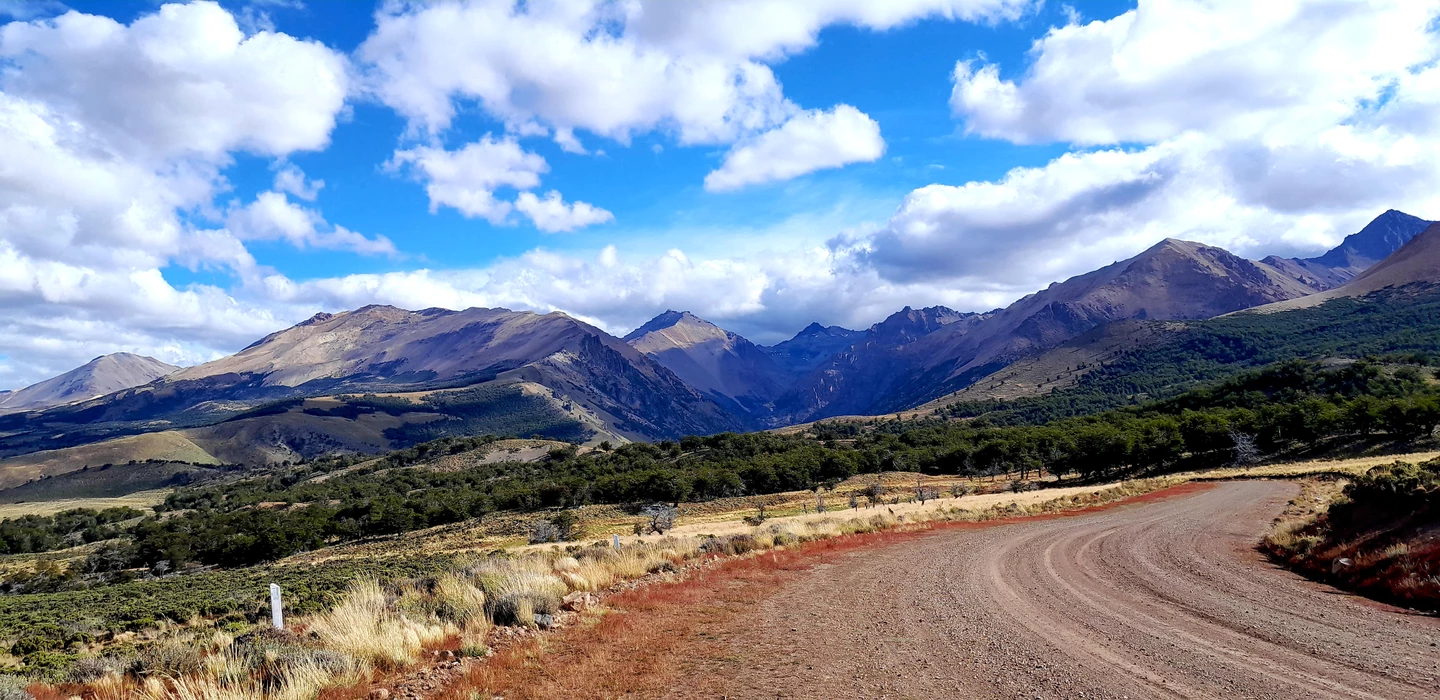
This immediately boosted my morale and I actually made it to Arroyo Lincoln that evening. There is a small river here and you are officially allowed to camp wild here.
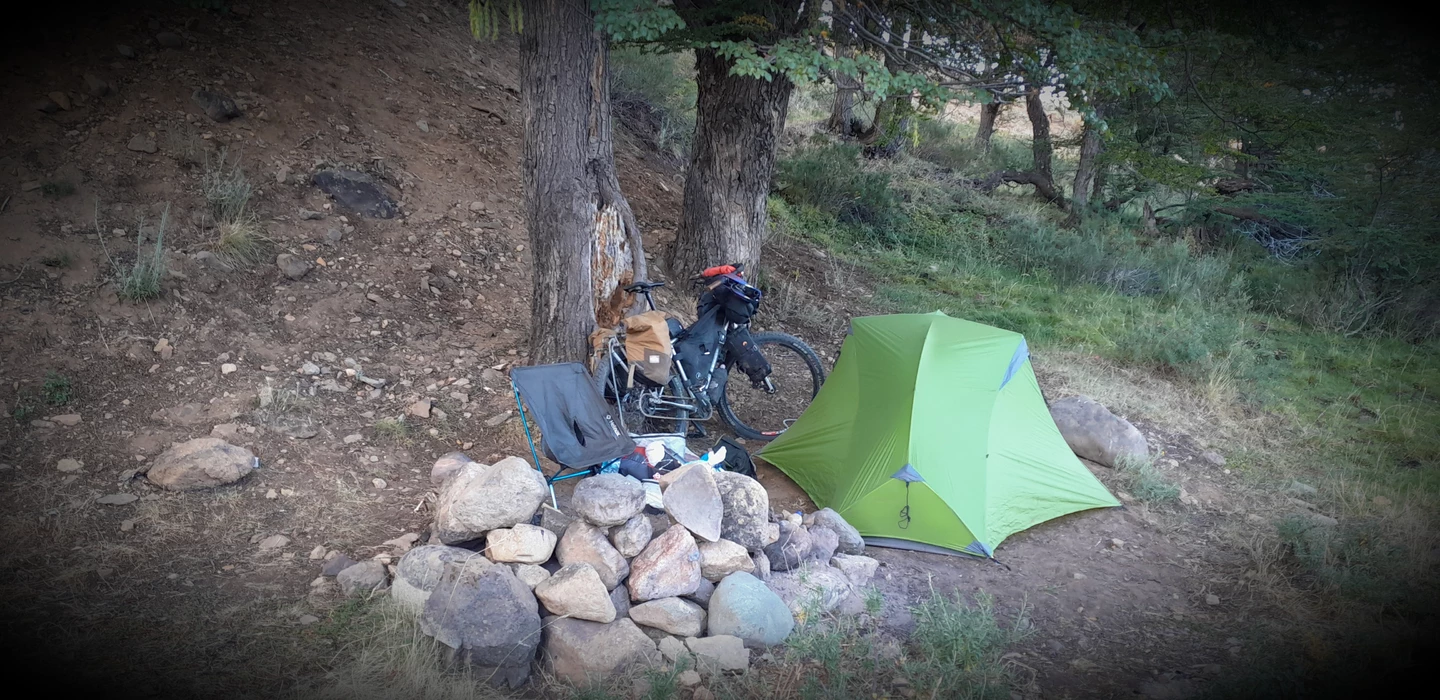
When I got up in the morning I was greeted by a beautiful sunrise and there was almost no wind.
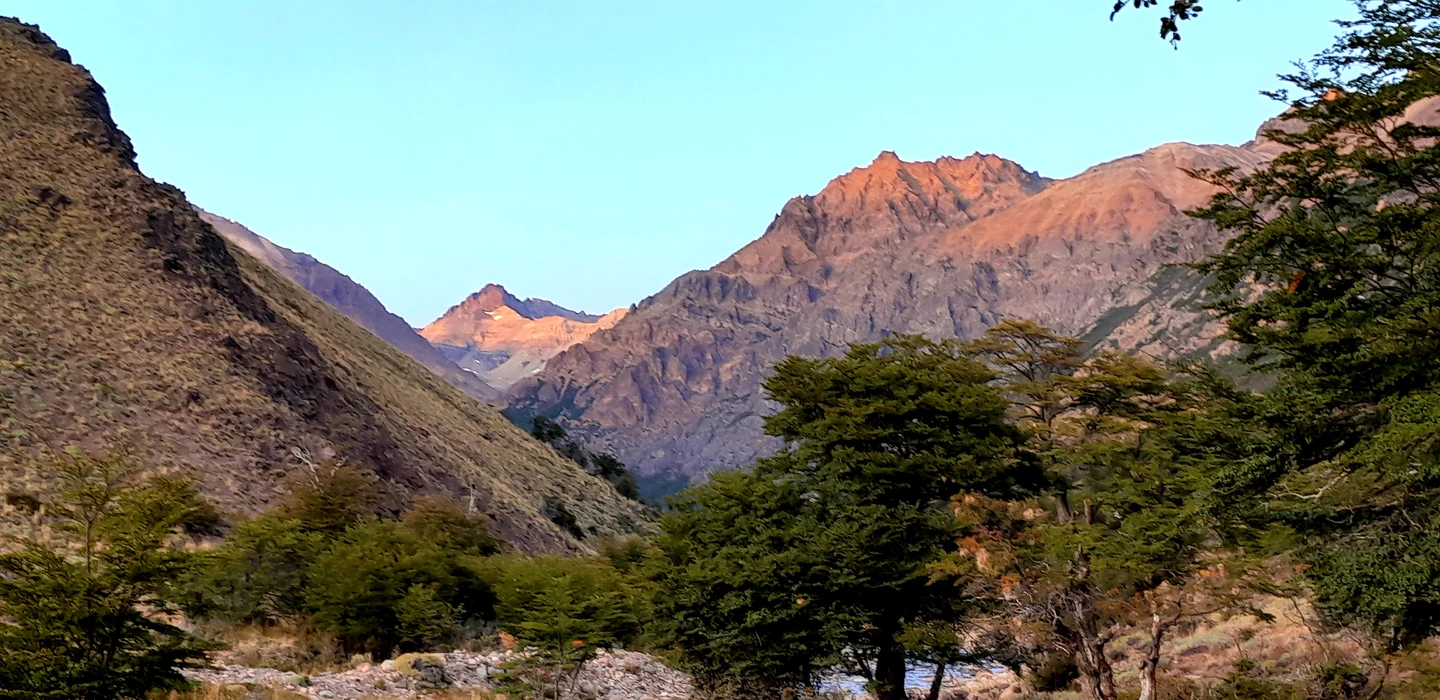
Climbing was the order of the day right from the start. A few parts of the climb were quite steep, but I was able to ride everything.
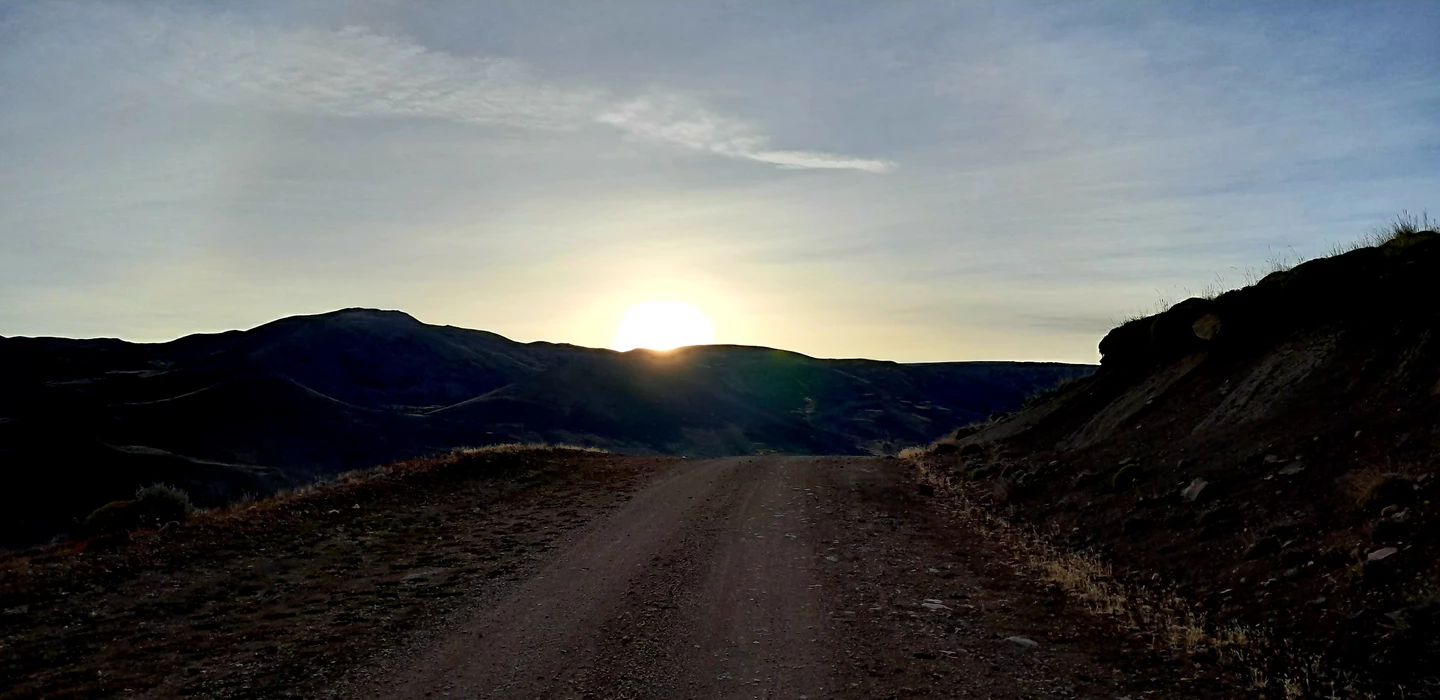
I was actually happy about the climbs because the temperatures were still pretty cool in the morning. Today I saw exactly 4 cars and 2 motorcyclists throughout the day.

After I crossed the Arroyo Canalele the landscape changed again. At around 11:00 a.m. I finally reached El Portezuelo, the highest point at 1,490 m above sea level.

A few kilometers later I stopped for lunch on the side of the road and saw Andean condors for the first time. They are the heaviest birds of prey, weighing up to 15 kilograms, and are one of the few birds whose wingspan can be over 300 cm. An impressive sight.
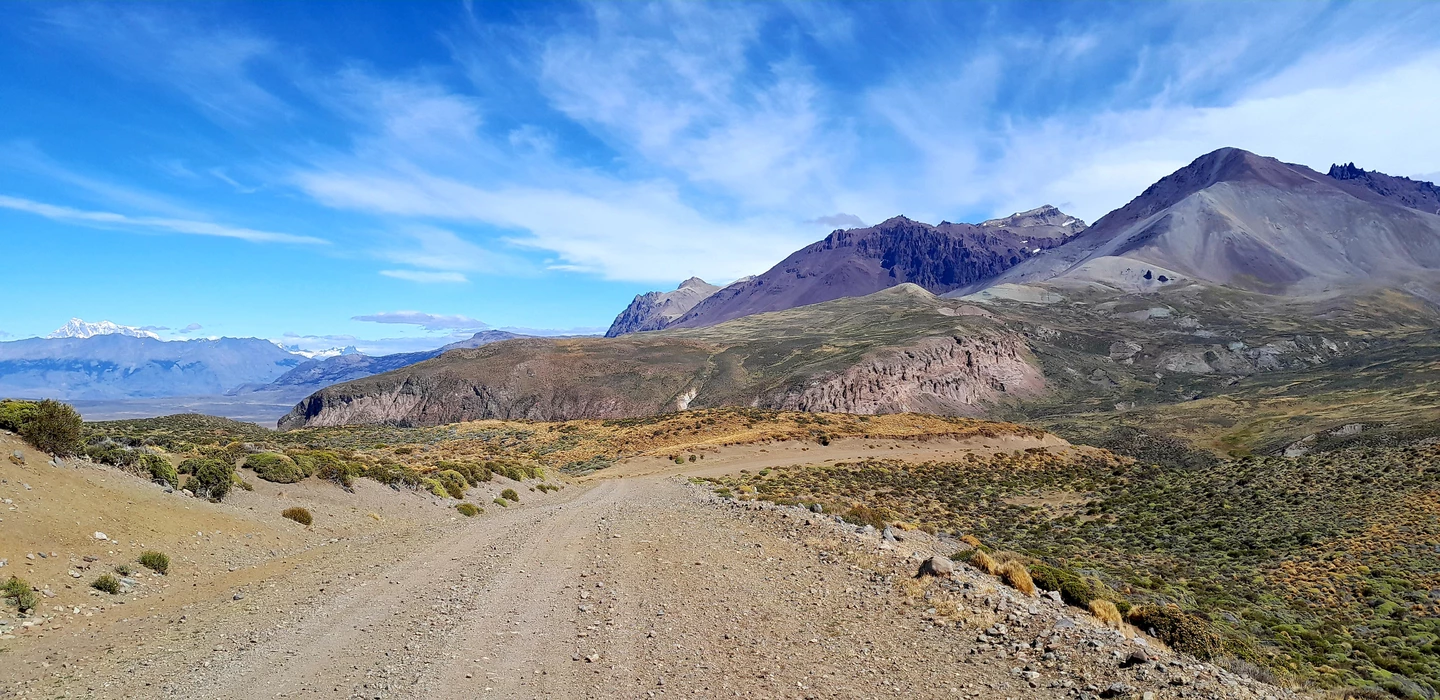
As I continued my journey I slowly descended to a plateau and the wind became increasingly stronger again. I really liked the rock formations here.
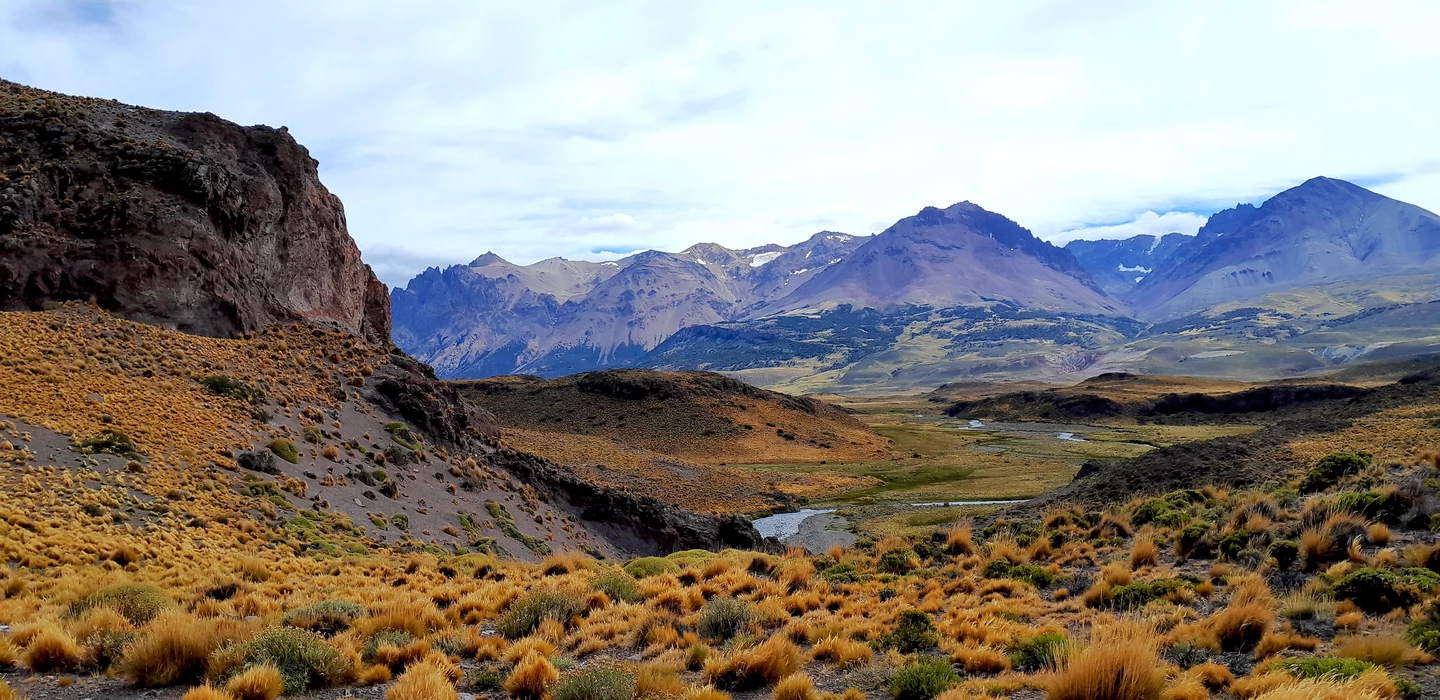
A little later I arrived at Paso Roballos. The border post on the Argentine side was just a small hut in the middle of nowhere. The officer was very friendly. There is no computer here. Everything was entered into a book by hand and I got my first exit stamp in my passport.

On the 10 kilometer journey to the Chilean border post the wind was blowing at me with full force. The Patagonia National Park begins here.
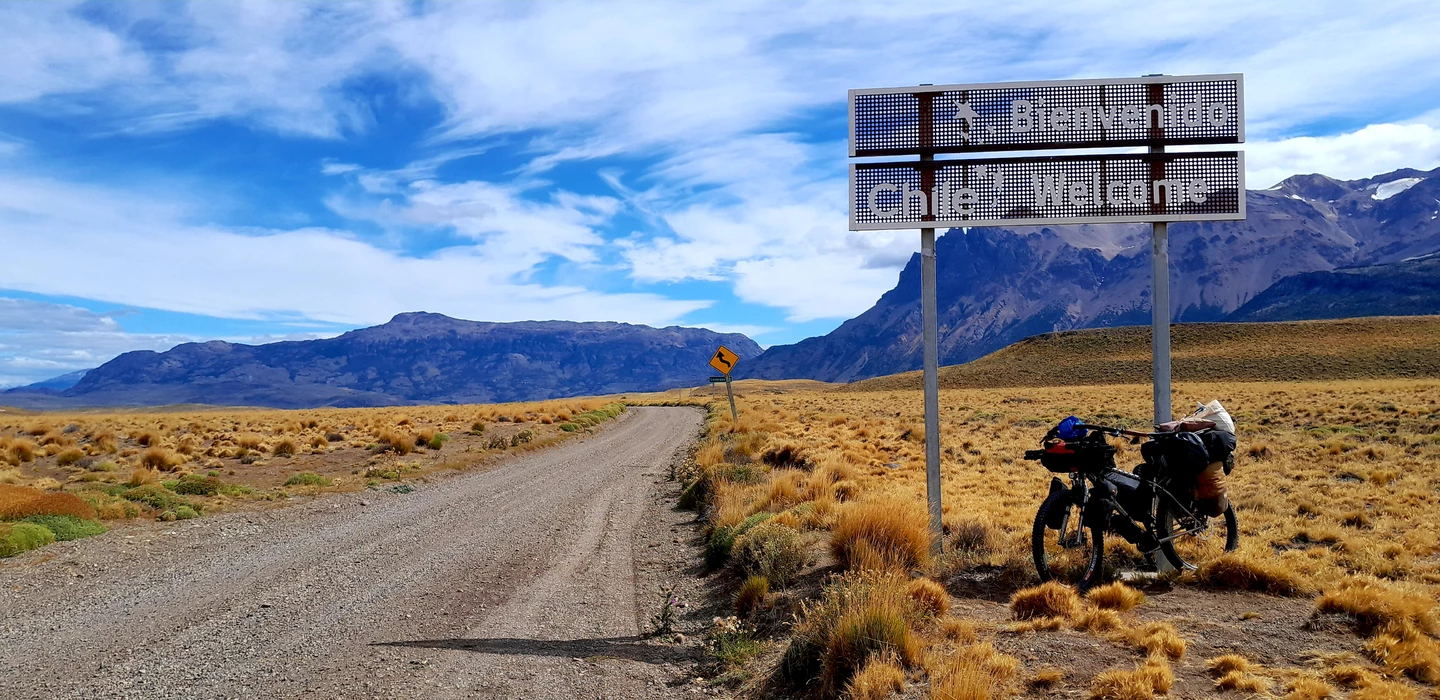
Once a private nature reserve that operated as a publicly accessible park, it was donated to the Chilean government in 2018 by Tompkins Conservation (founder and former head of textile brand The North Face). Shortly before the border post I saw two guanacos for the first time.

When I re-entered Chile, the officer in charge was also extremely friendly and efficient. As I continued my journey I passed Cerro Baker (2,230 m above sea level).

I drove into the national park on a flat road and with a lot of headwind. I didn't really make any progress quickly.

Towards the evening I reached the Alto Valle campsite. This one is officially closed, but I didn't care at that moment. I simply pushed my bike under the barrier.
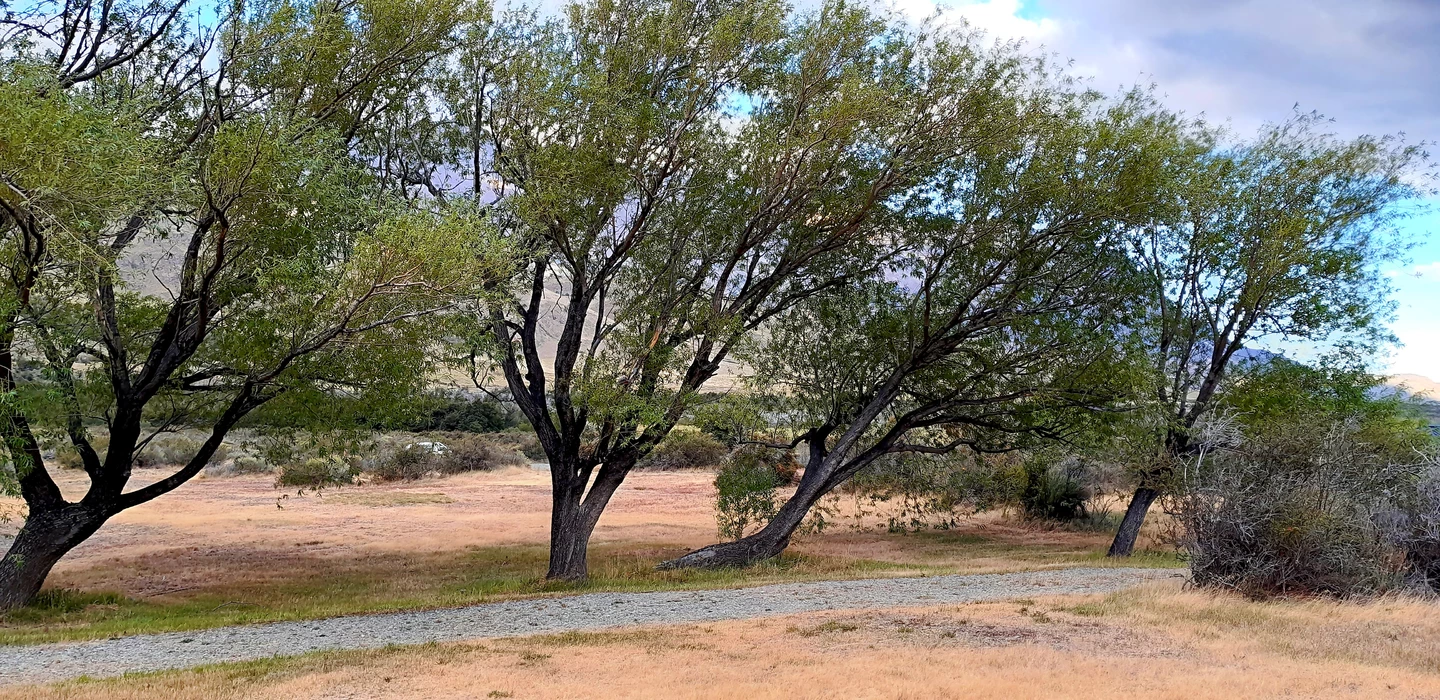
I pitched my tent in one of the sheltered buildings on the property. I couldn't have asked for a better place to spend the night.
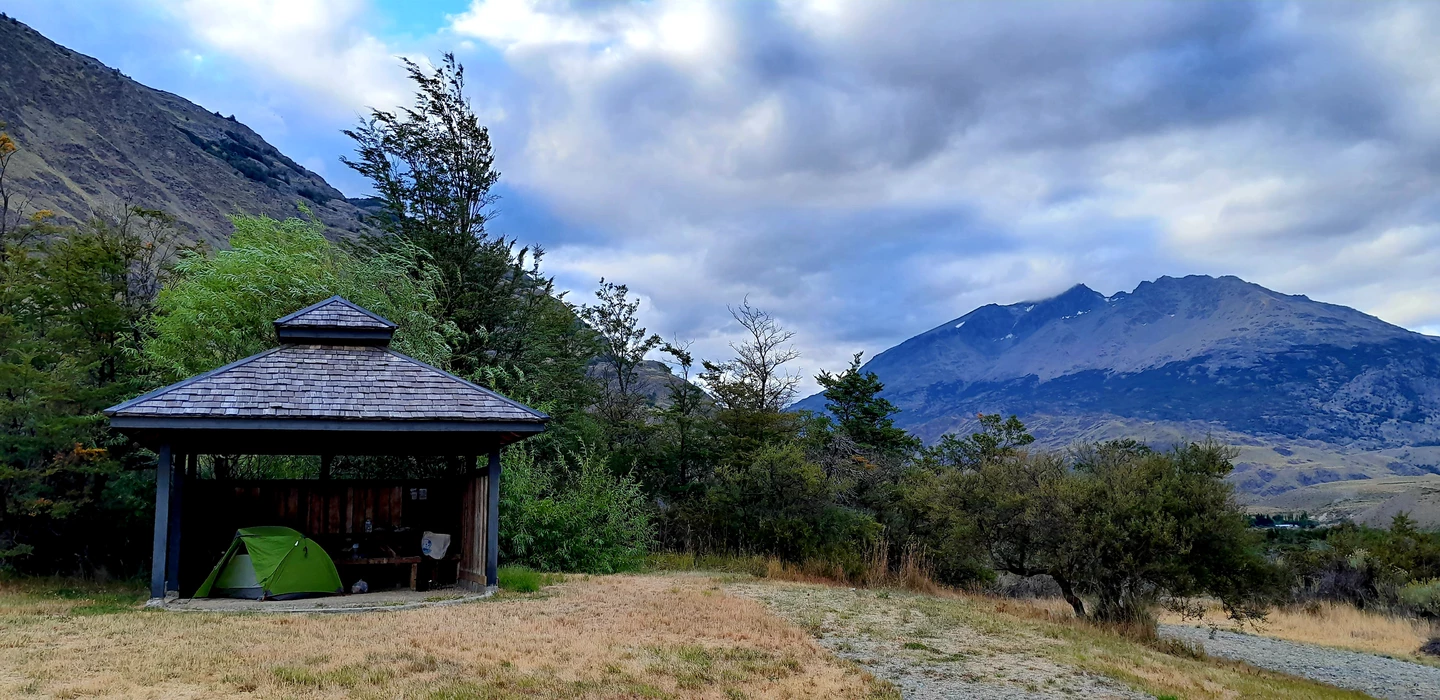
To celebrate the day, I cooked an extra large portion of pasta with pesto sauce on my wood stove. When darkness fell, I quickly crawled into the warm sleeping bag and fell asleep immediately.
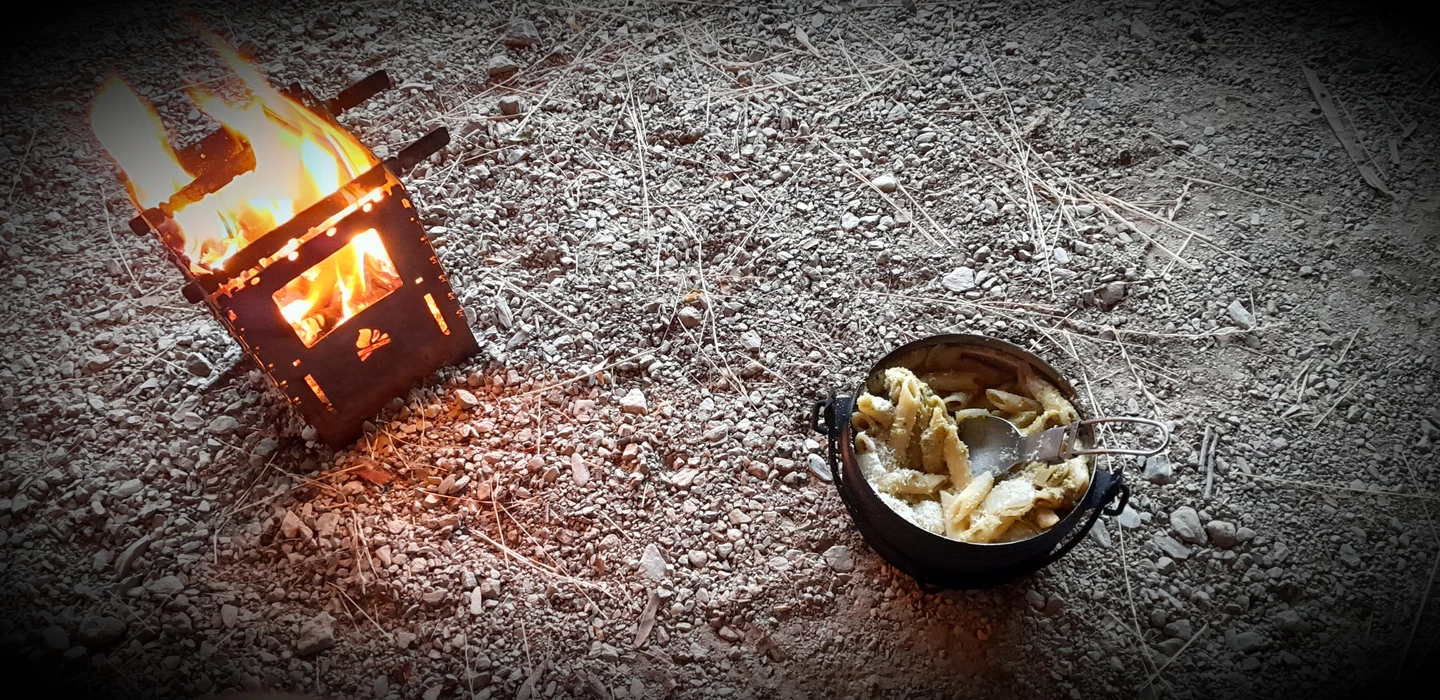
At breakfast the next morning I was able to enjoy another beautiful sunrise. However, I hurried to get back in the saddle as quickly as possible because the temperatures were very cool.
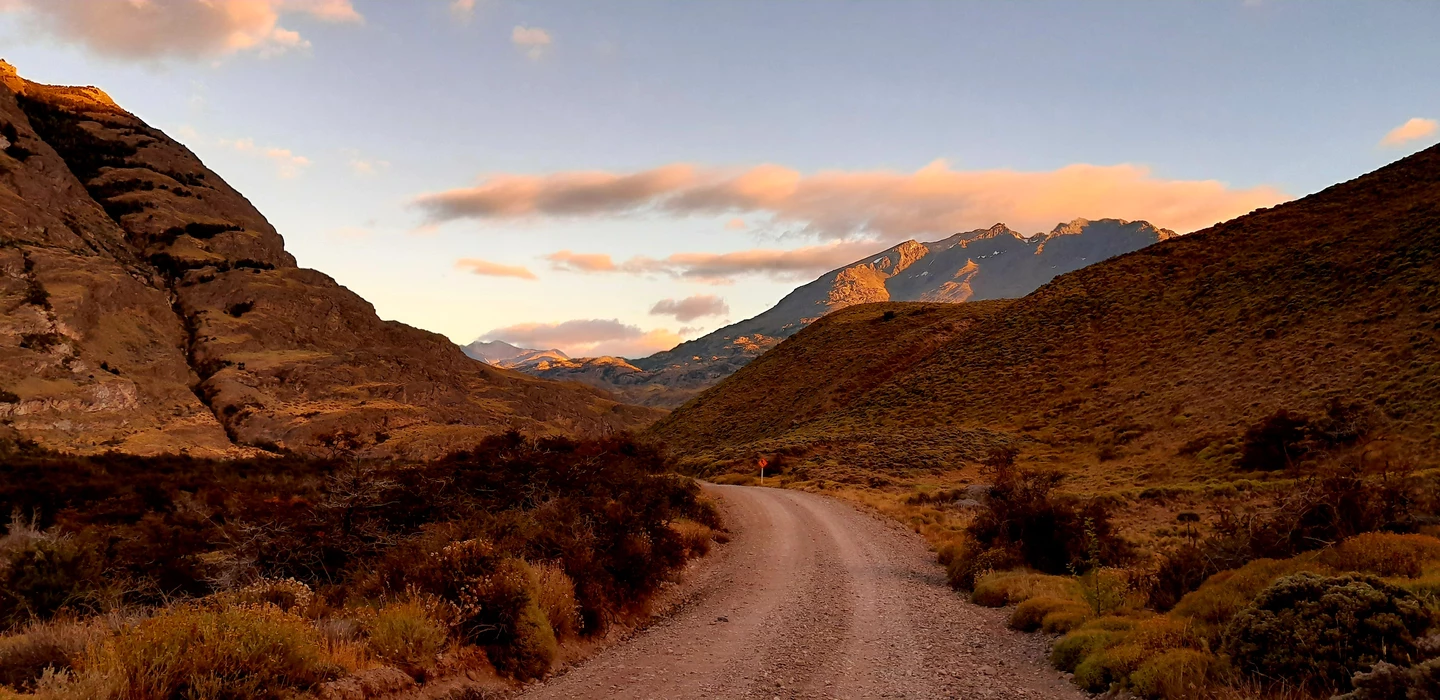
The journey went along the Rio Chacabuco. Unfortunately the road here was really bad to drive. The beautiful landscape compensated for the torture a little.

One of the biggest problems here on the Chilean roads are the extremely steep gradients. Most of the time it is almost impossible to ride up these on a bike.
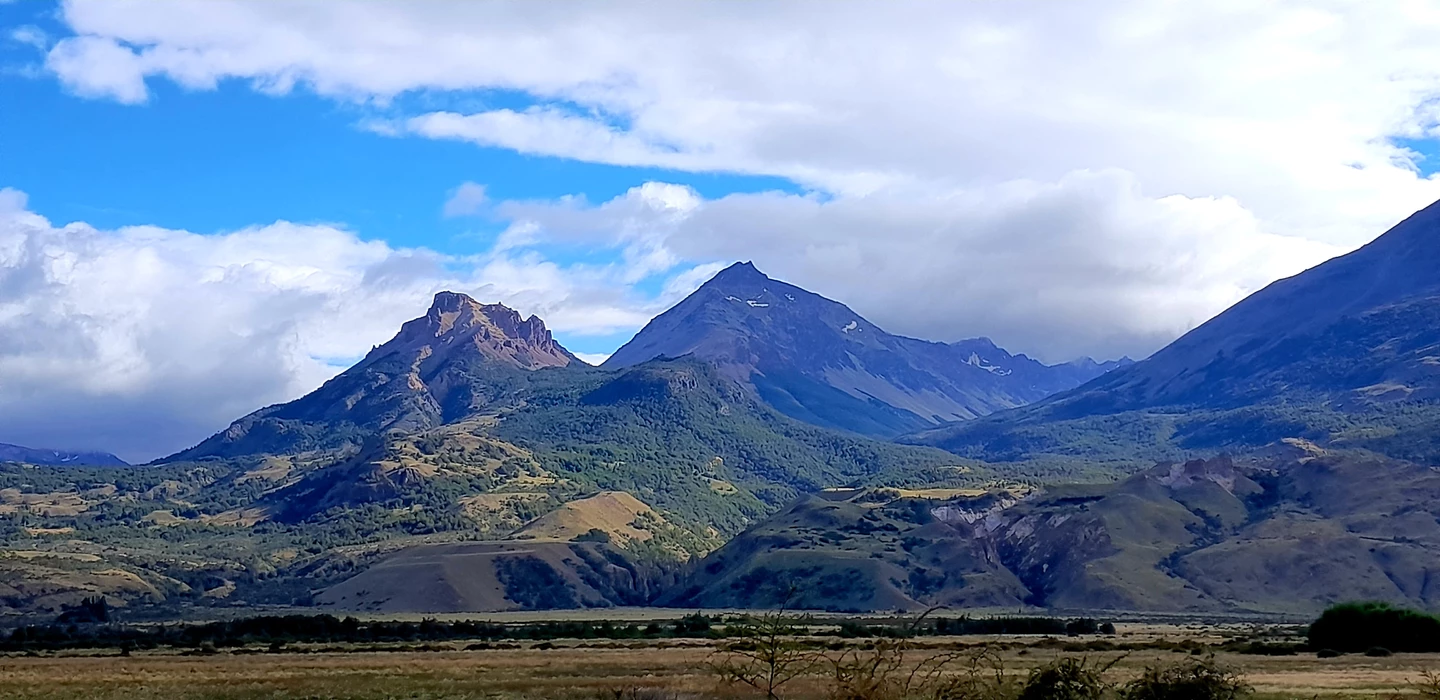
Just as I was pushing my bike up the mountain upon arriving in Valle Guanaco, there was suddenly a herd of guanacos on the side of the road. The animals are not shy at all and just stare at me as I walk past them.
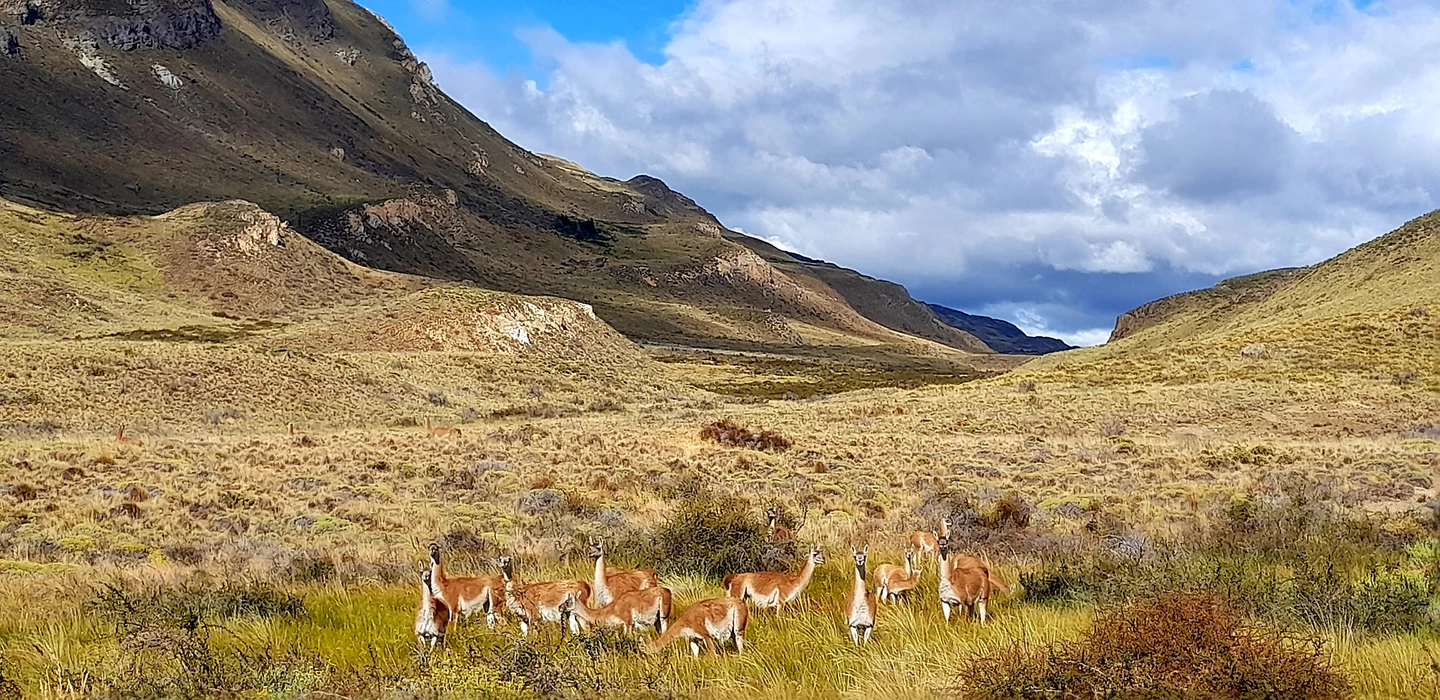
On the climb to Laguna Gutierrez the wind increased. At the other end of the lagoon I took a quick lunch break at the picnic area. A herd of guanacos watched me eat from a distance.
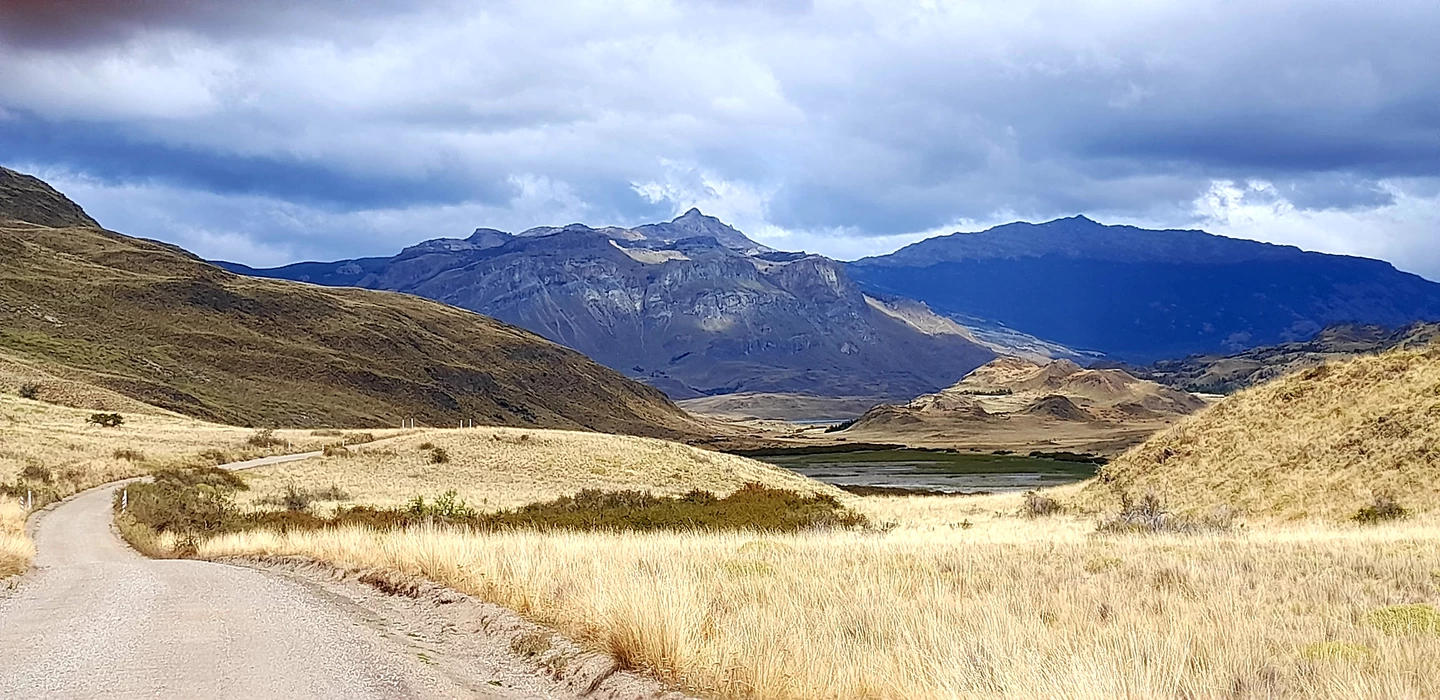
The guanaco is the ancestral form of the domesticated llama. They can be found at altitudes of up to 4,000 m. They belong to the camel family and are herbivores. Unfortunately, due to mass shooting, the population numbers have become smaller and smaller and today there are only a little more than one percent of the original number (approx. 600,000 animals).

On the drive out of the national park I was surprised by the rain several times. But the individual showers quickly passed.
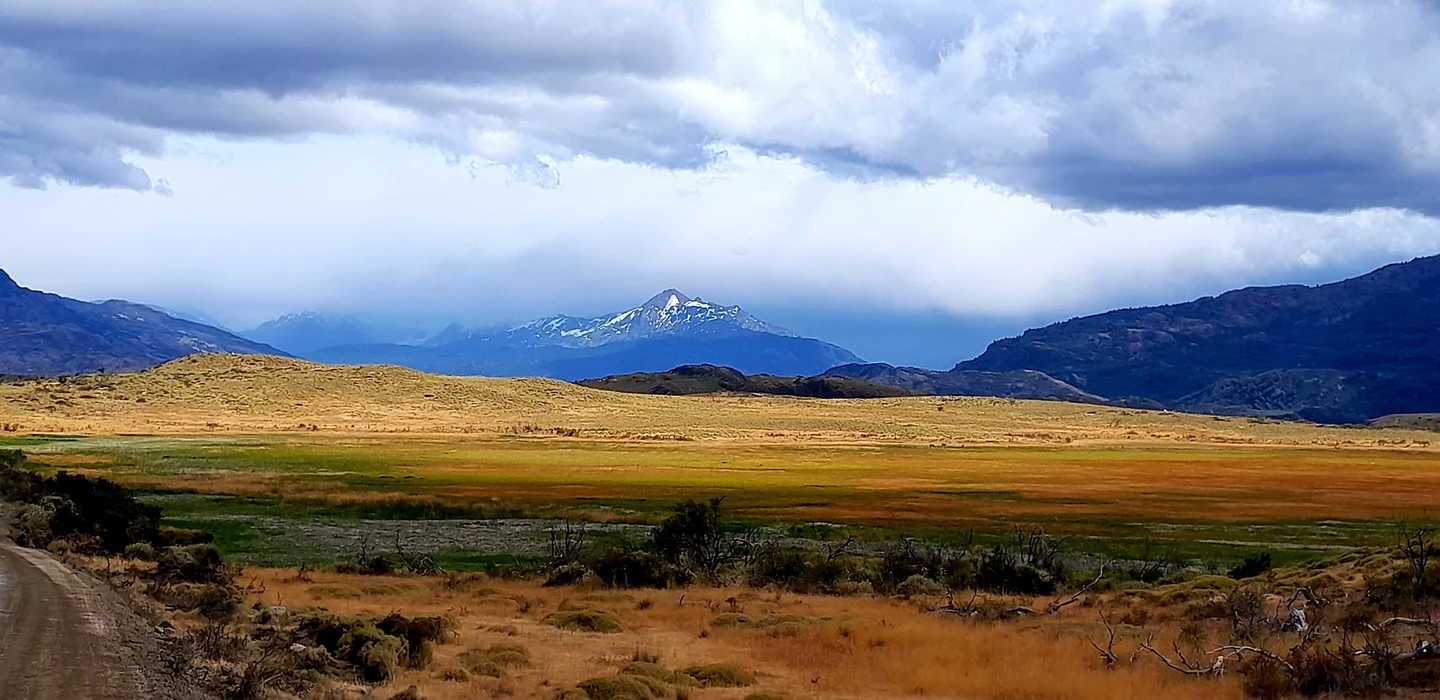
Shortly before I reached the Carretera Austral I saw the Rio Baker for the first time. The color of the river reminded me a little of the Soca in Slovenia.
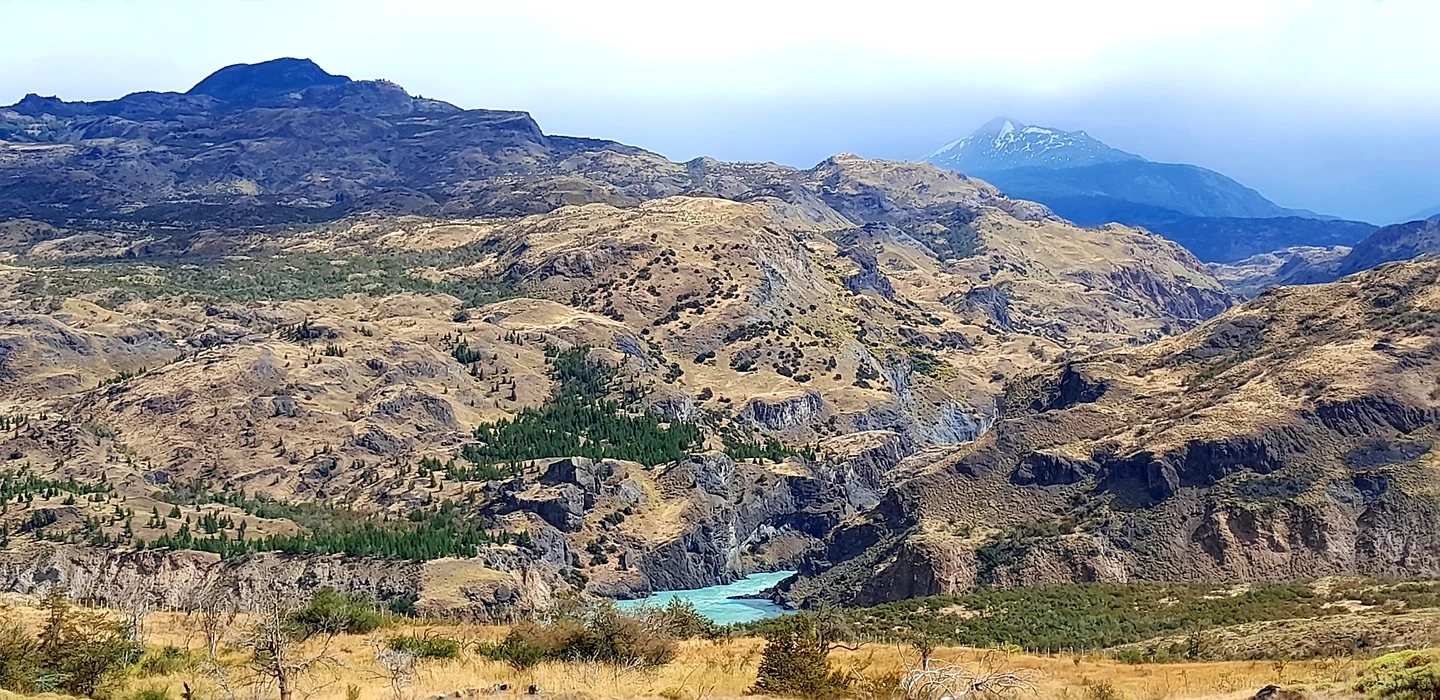
Immediately there was more traffic again as I continued on the Carretera Austral and the road went up and down almost constantly. I finally reached Cochrane just after 5pm.
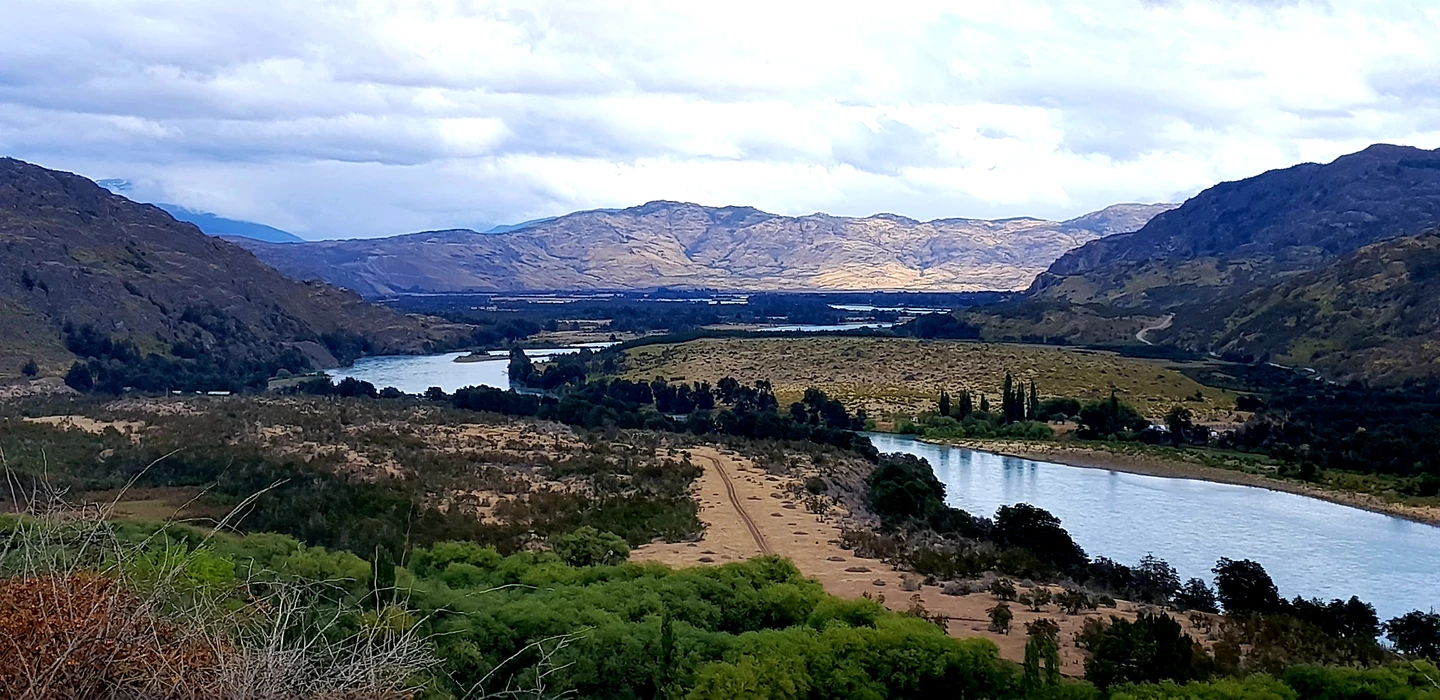
I spent two days in the city. The temperatures dropped quite low and it snowed quite a bit on the first night.

For my next packraft adventure on the Rio Baker I had to organize enough provisions here in Cochrane. Because until I reach my destination in Caleta Tortel there are no more options for food on the river.

After a relaxing weekend, I went back into the saddle early on Monday morning in cold temperatures. I had to cycle back about 10 kilometers on the Carretera Austral to get to the embarkation point on the Rio Baker.
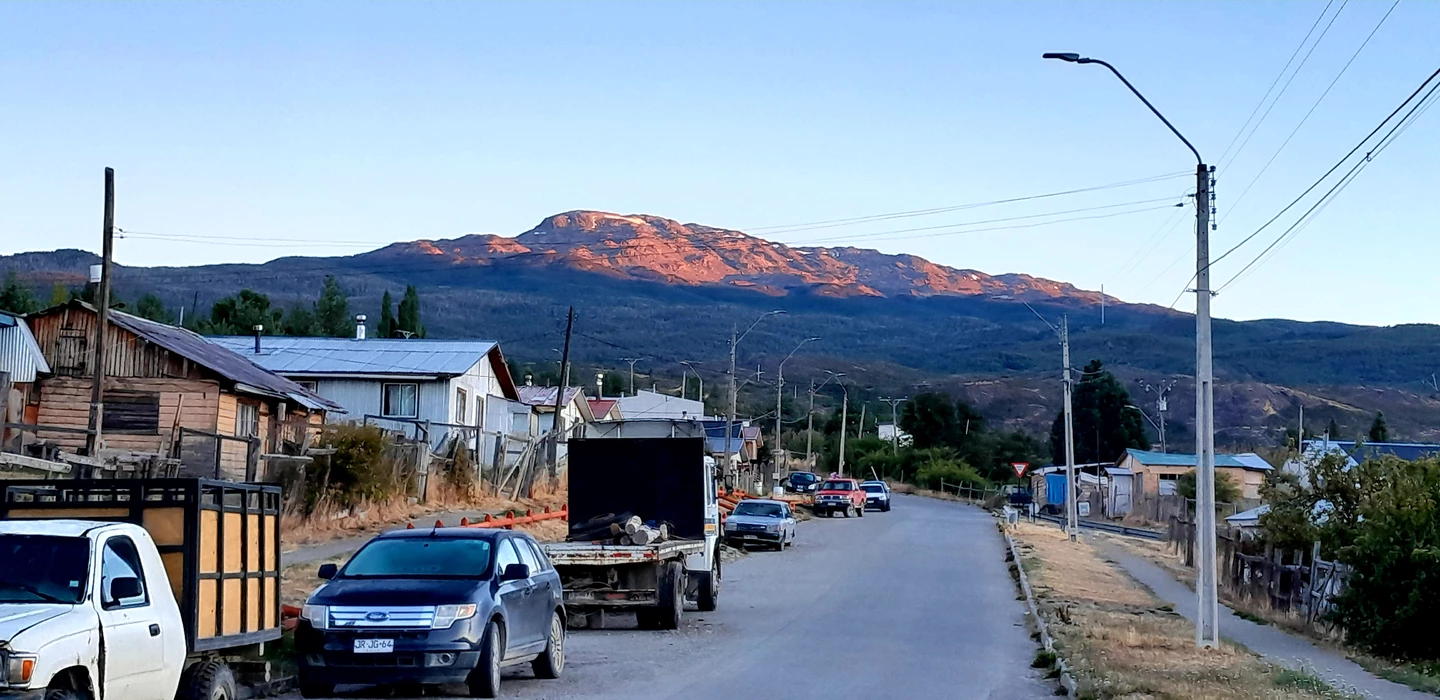
The weather was really fantastic that day and the view of the Rio Baker was really impressive. I couldn't have asked for a better start.

Right next to the Balsa Baker ferry I started loading all my stuff onto the packraft. After an hour and a half I was ready to go and started paddling.

The feeling of being on the water cannot be compared to the dusty streets here. No traffic or fences, great scenery and quite a few waterfowl on both sides of the river. Simply fantastic!
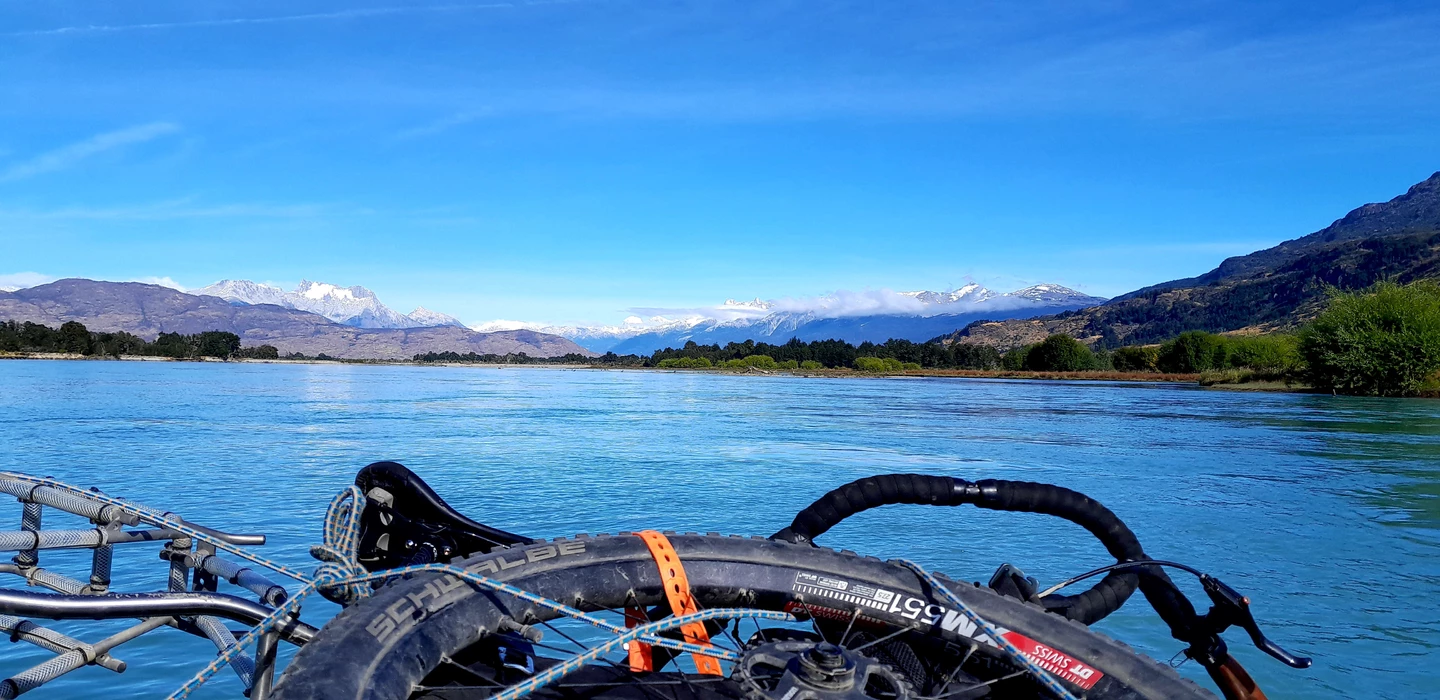
The Rio Baker is Chile's river with the highest water flow. I felt that immediately. Compared to the Rio Palena, there is a lot more current here.
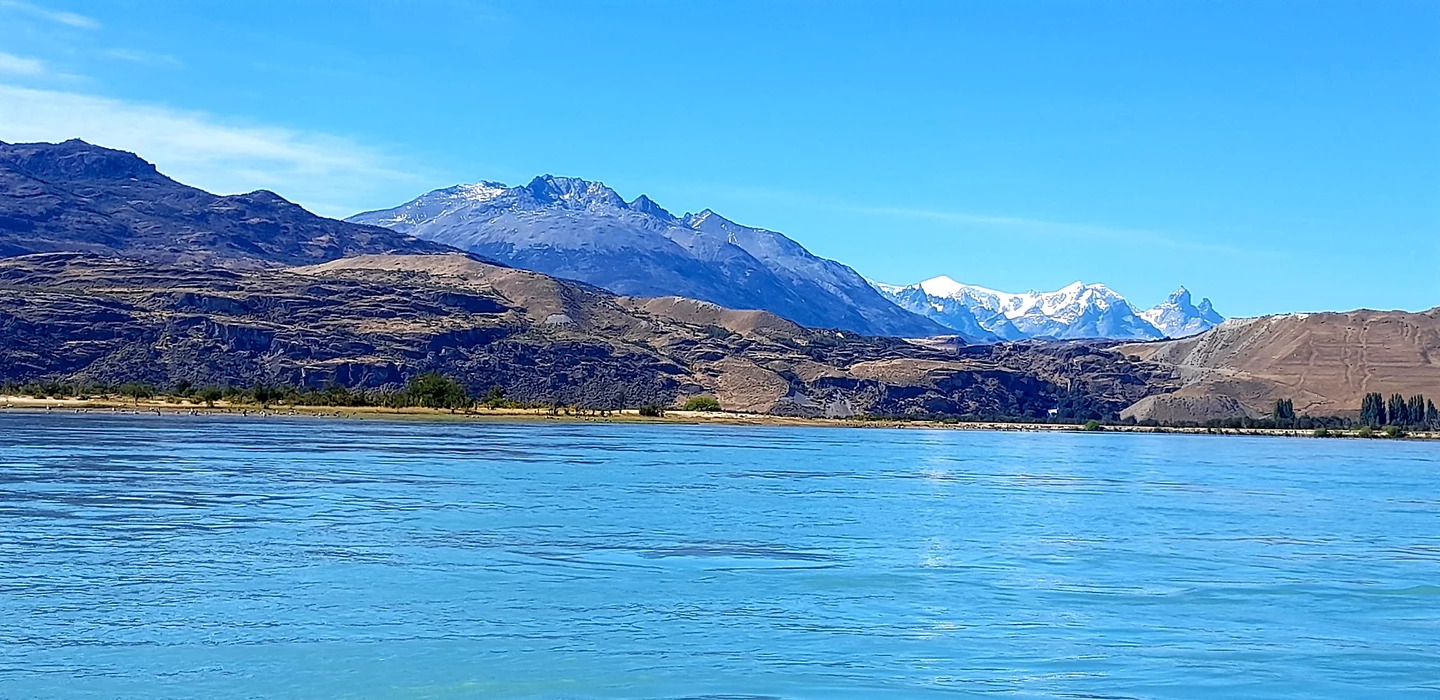
Thanks to the nice weather, the views of the surrounding countryside were fantastic. The dimensions of the mountains and glaciers here are really impressive.

I took a short lunch break right on the river bank. Despite the sunshine, temperatures did not rise above 12° Celsius today.
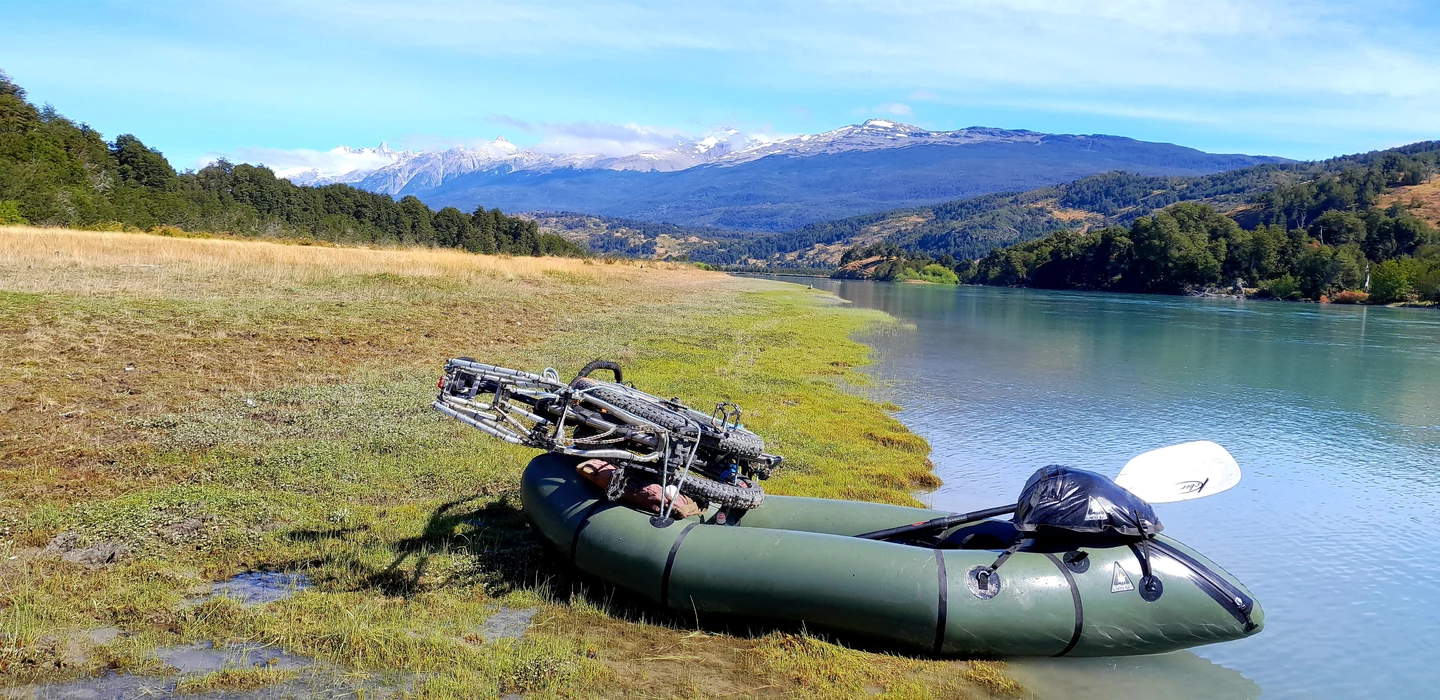
As I continued my journey I suddenly came to a place with quite high waves and then a large eddy. On the route description I saw that this was the first Class 2 rapid. Lucky again!

In some places you can always see forests that look dead or burned. At the beginning of the 20th century, there was a state-supported program in this region to create pastures for cows and sheep. Entire areas of land were burned down. Unfortunately, most of nature has not yet recovered from this intervention.
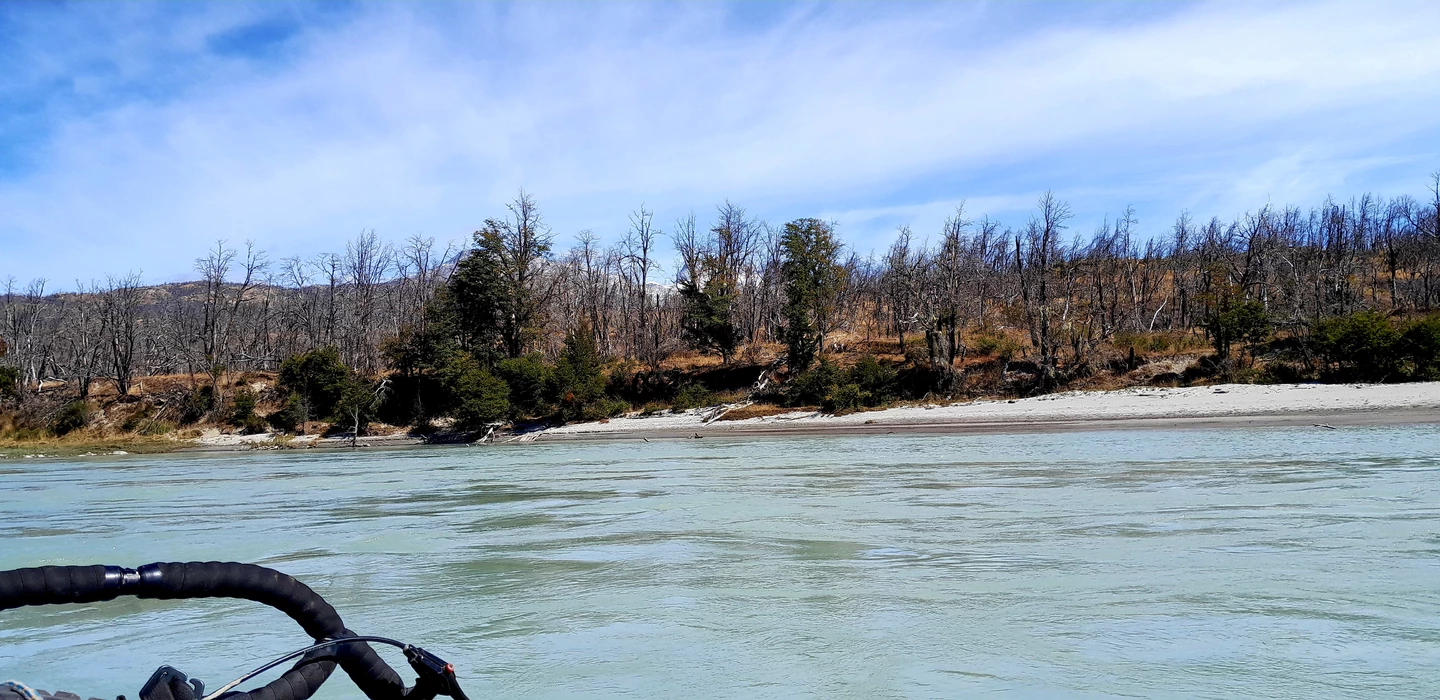
A little later the river became louder and louder. My map showed this to be a class 3 rapid. I boated out on the right bank and after inspecting the area decided not to paddle.

There should actually be a path leading along the right bank. However, I couldn't find it and so I had no choice but to carry all the material over the large boulders. It was only after 3 hours that I had carried all my equipment around the rapid.

Completely sweaty and dead tired, I paddled a little longer in the dusk until I found a suitable place to camp on the bank. On the way I noticed that my packraft had a very small hole. This must have happened during the portage.
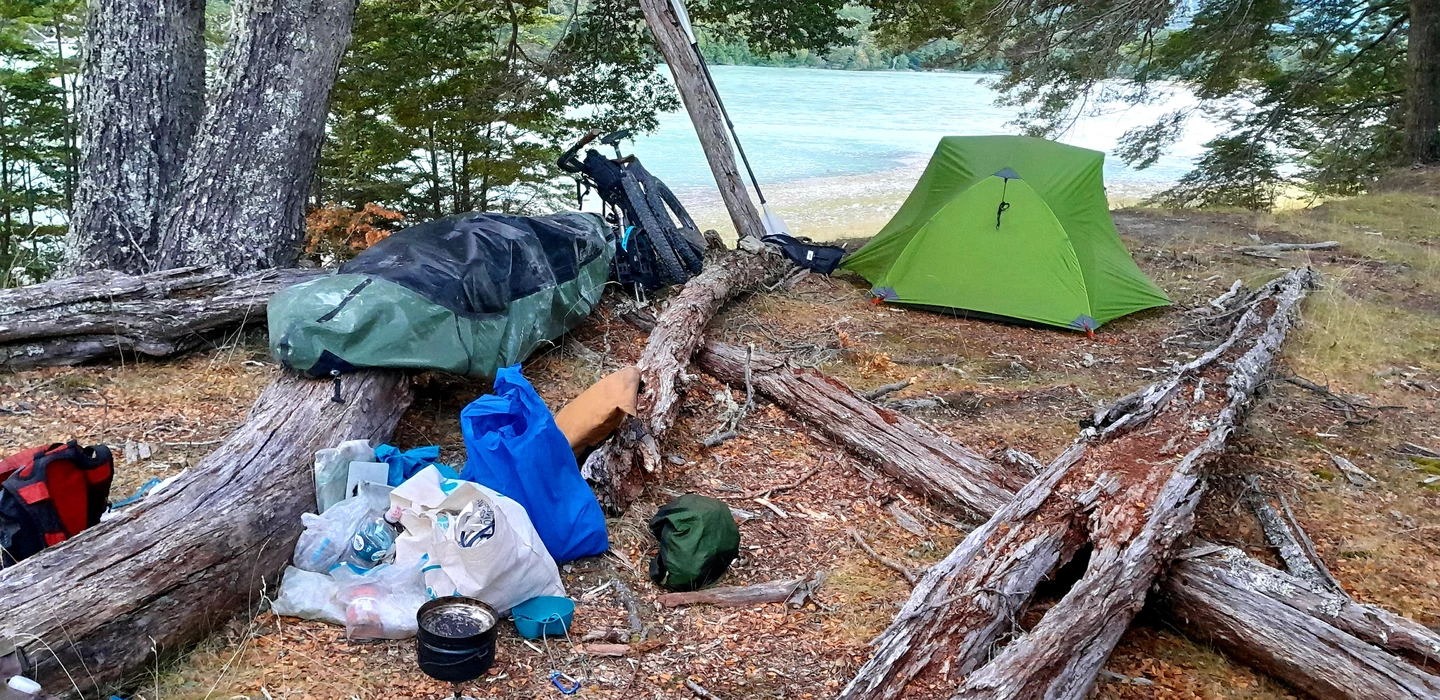
I just set up my tent, briefly cooked some noodle soup and then fell into my sleeping bag. It wasn't until the next morning that I repaired the small hole with duck tape.
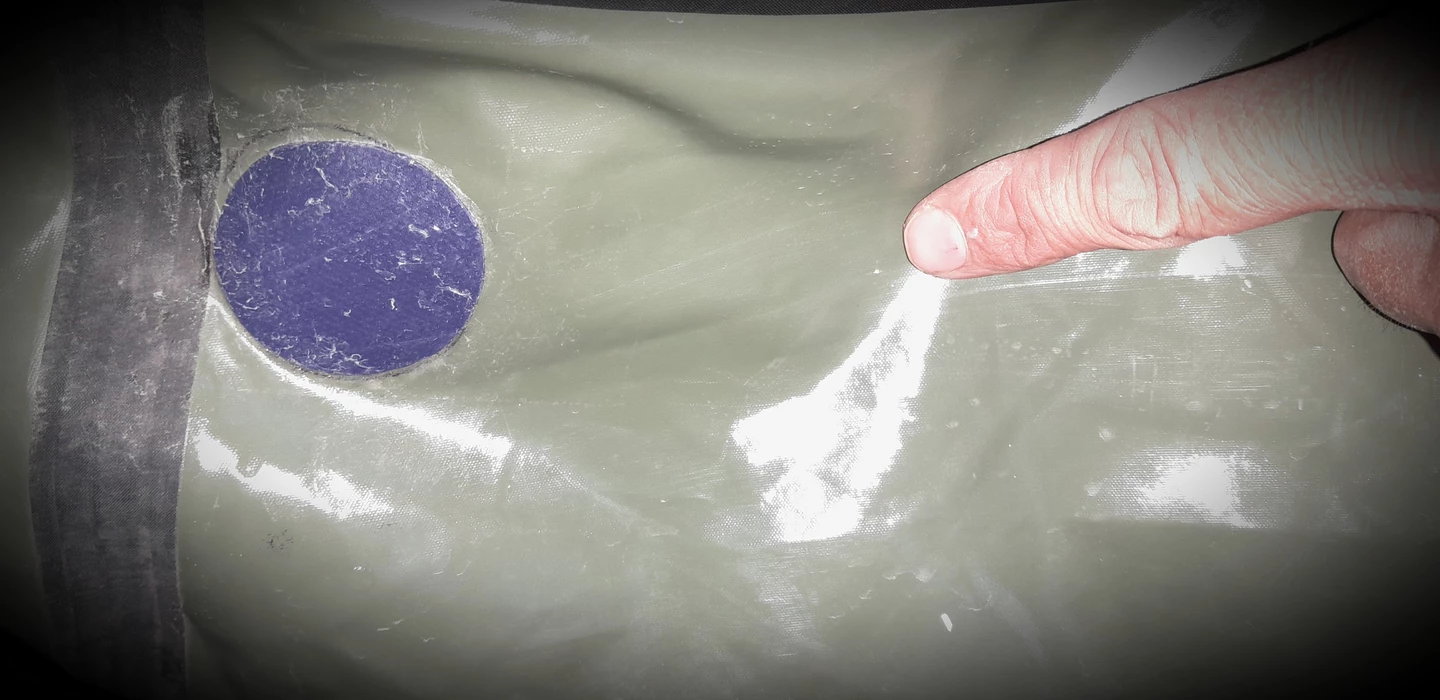
The day started with a beautiful dawn. However, dark clouds soon gathered. The El Niño weather phenomenon is currently causing increased rainfall and strong winds here in South America.
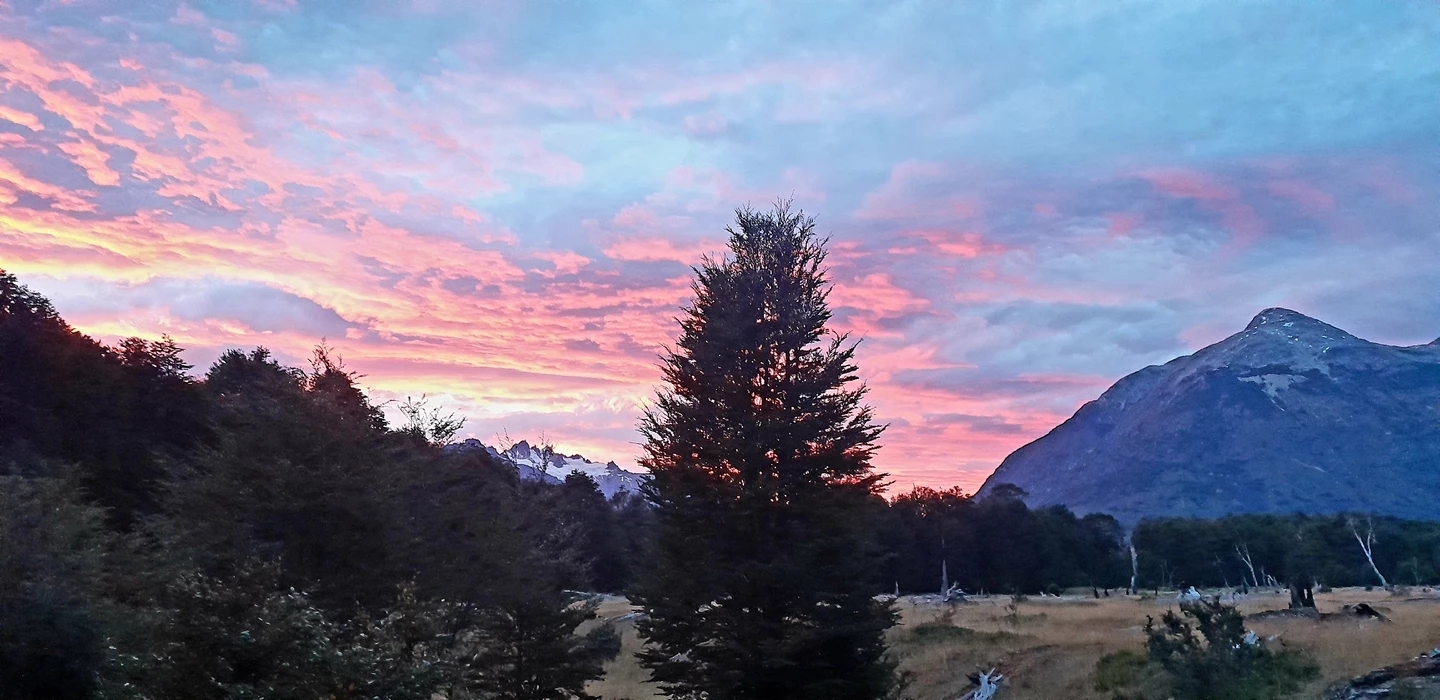
I soon loaded everything back onto the packraft and continued paddling. Due to the clouds, it wasn't quite as cold today as it had been in the previous days.
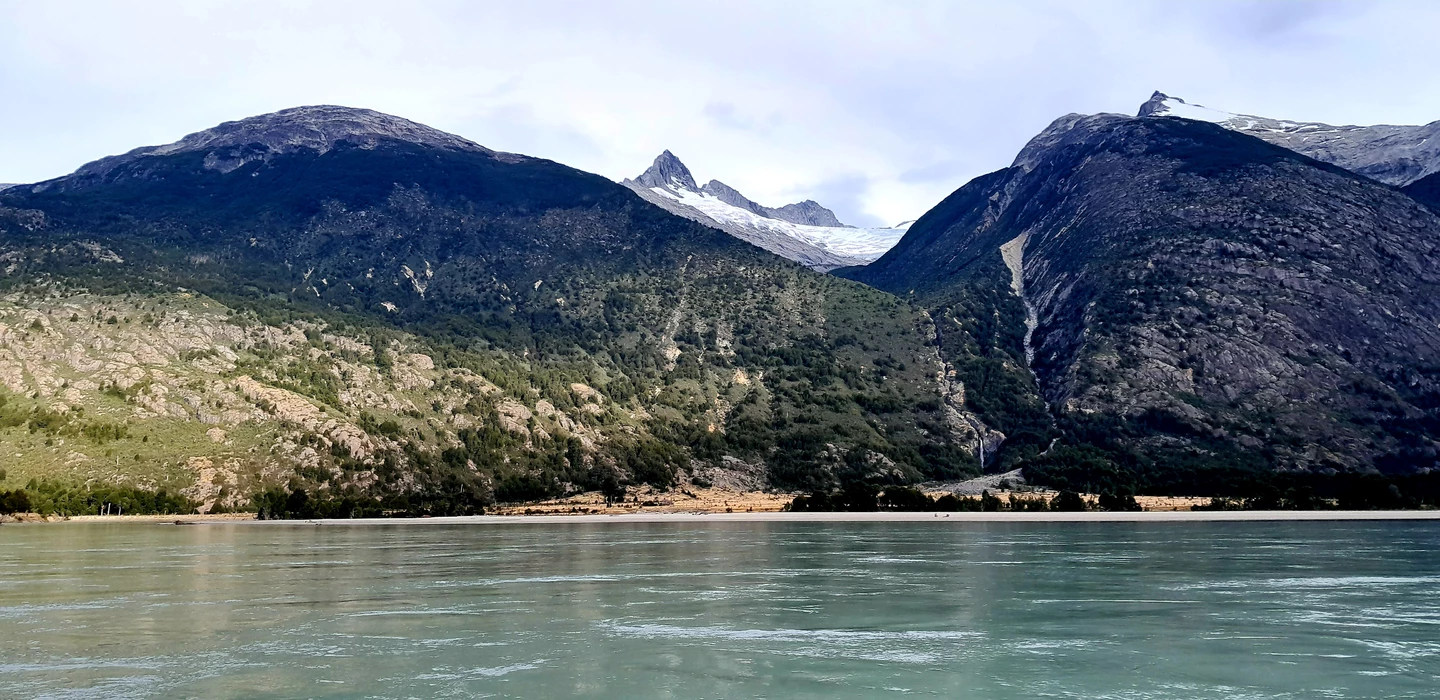
After 10 kilometers I reached El Salto. At this point the entire river passes through a bottleneck and is considered impassable. On the left there is a path leading to Paso San Carlos. I got out a little earlier and first inspected the path on foot.
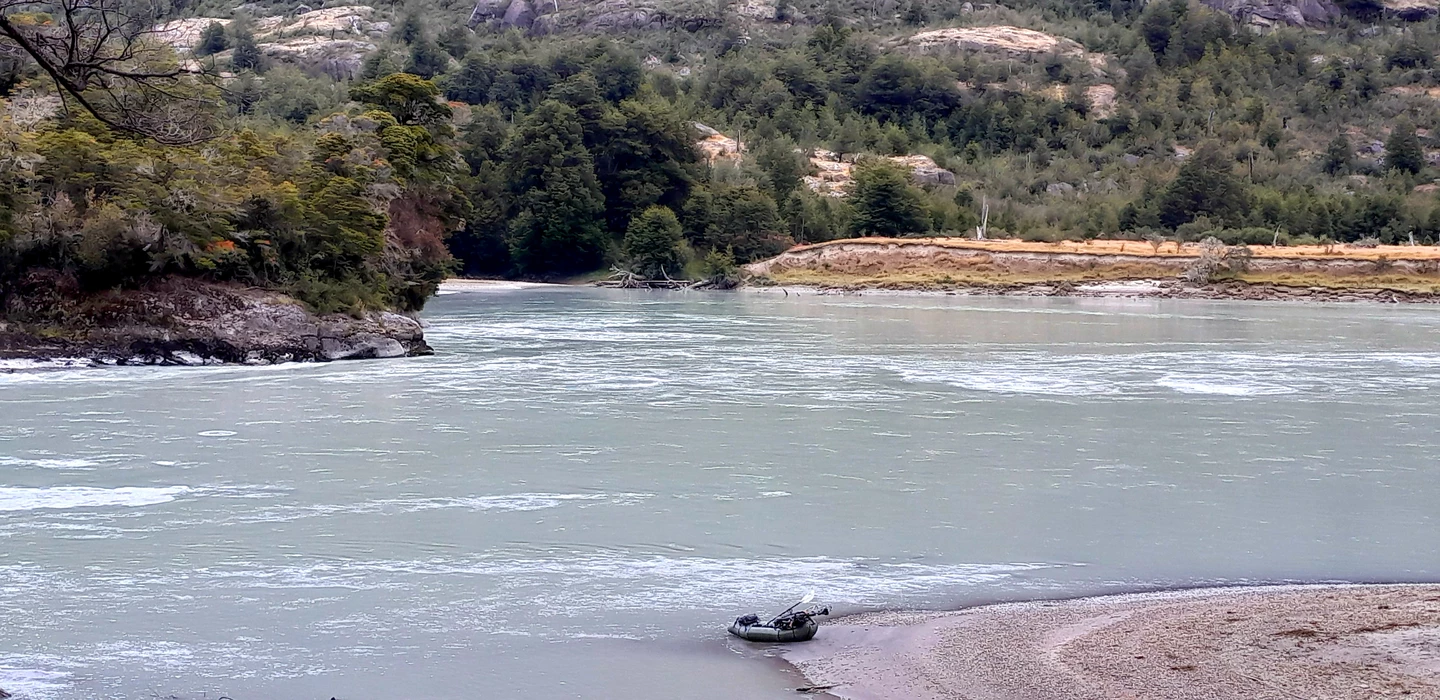
The path gave the impression of a single trail and I decided to load everything onto the bike. I hoped this would save me a little time.
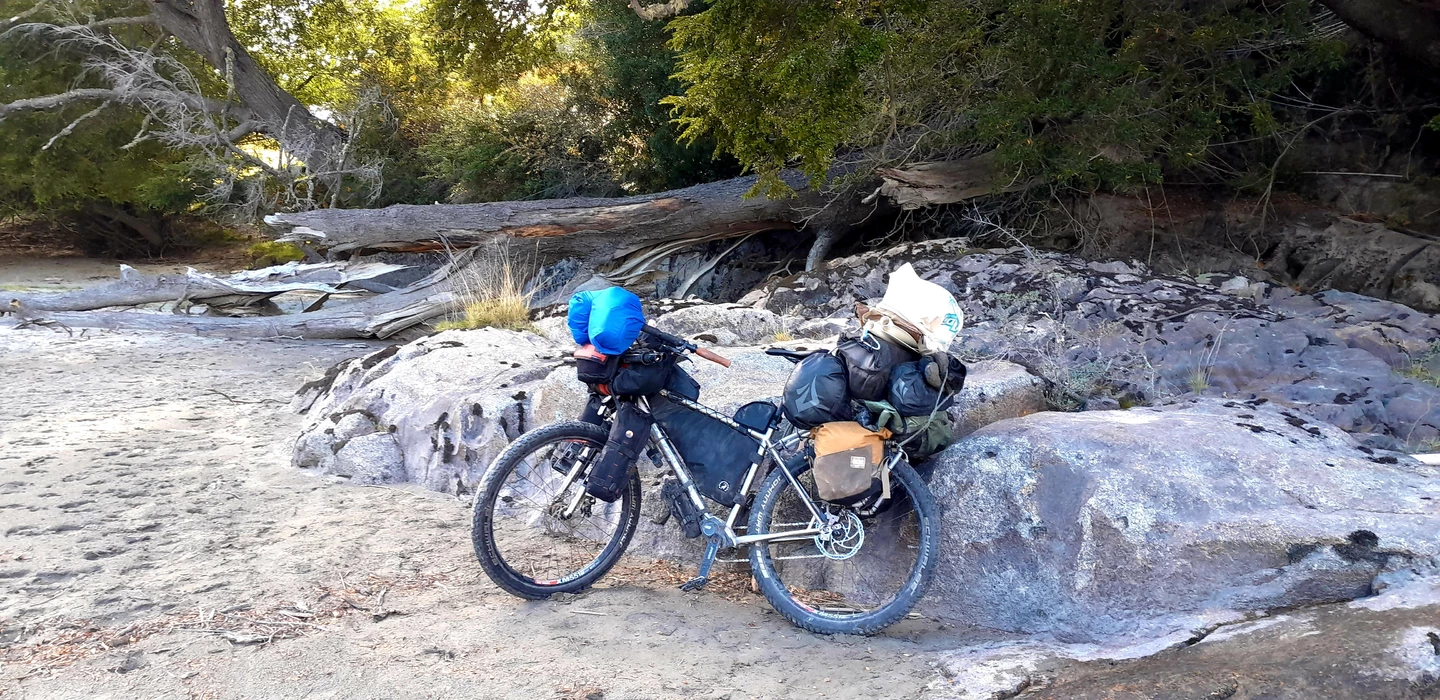
Things went pretty well for the first kilometer and I was even able to cycle a few times. However, the path is designed more for horses and not for cycling.
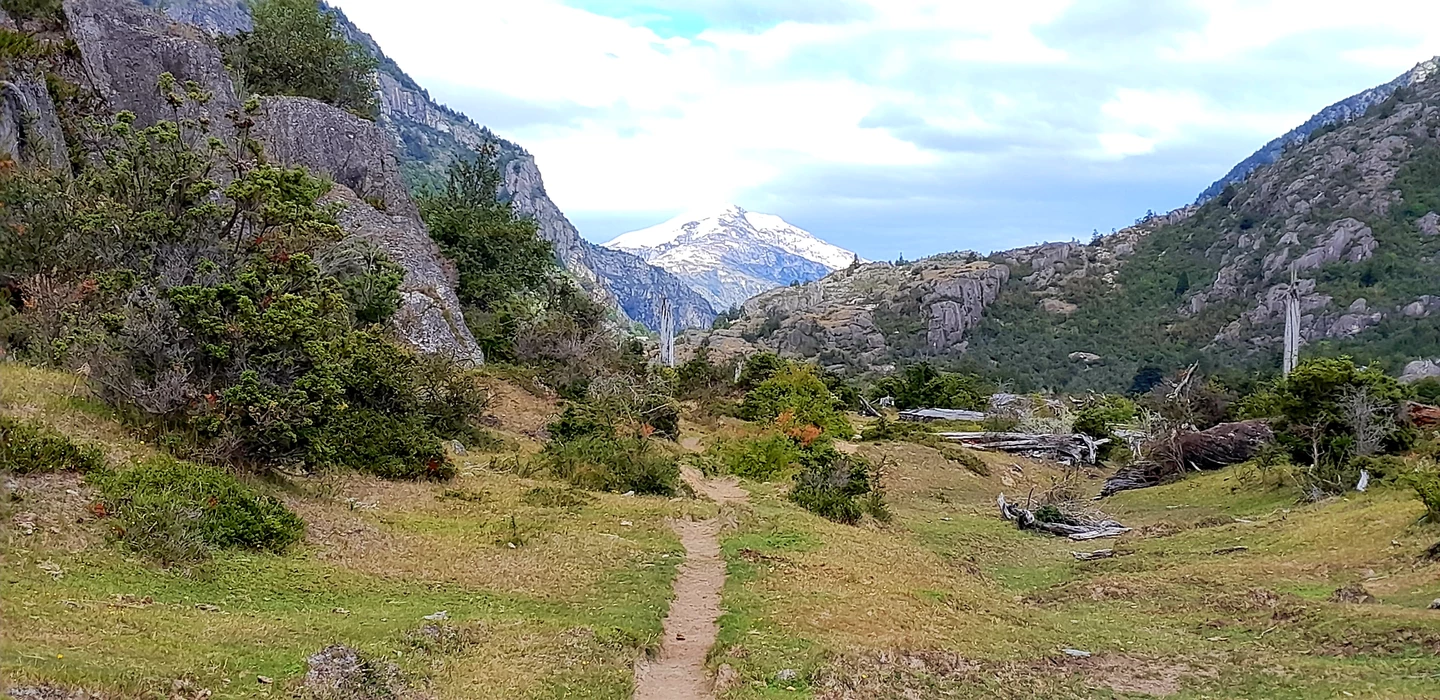
I then had to leave half of my luggage behind at a stream to overcome the incline. Shortly afterwards, a gaucho came towards me on a horse and accompanied by two dogs. He told me that there were 2 people further ahead with a kayak.
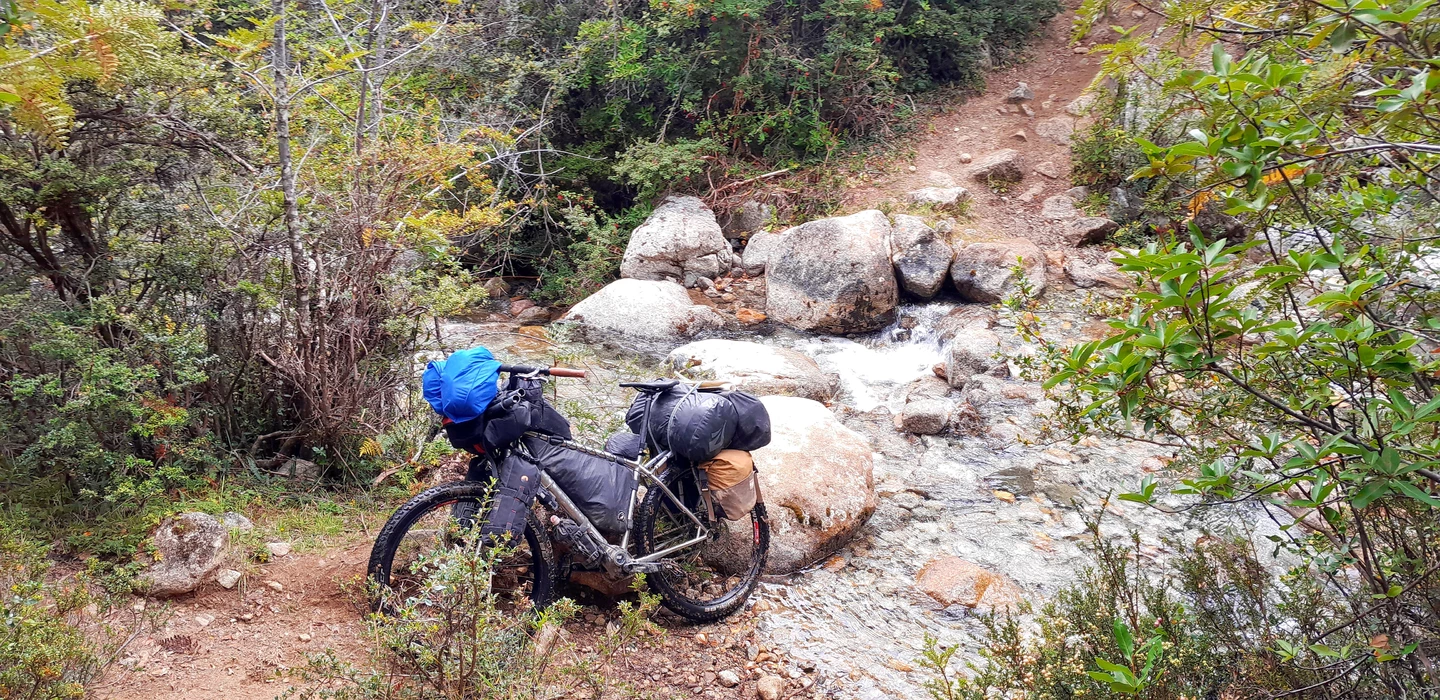
Shortly before the embarkation point I met them both. Andrea and his wife Anne Maria come from the north of Brazil and are traveling on the Rio Baker in their sea kayak.
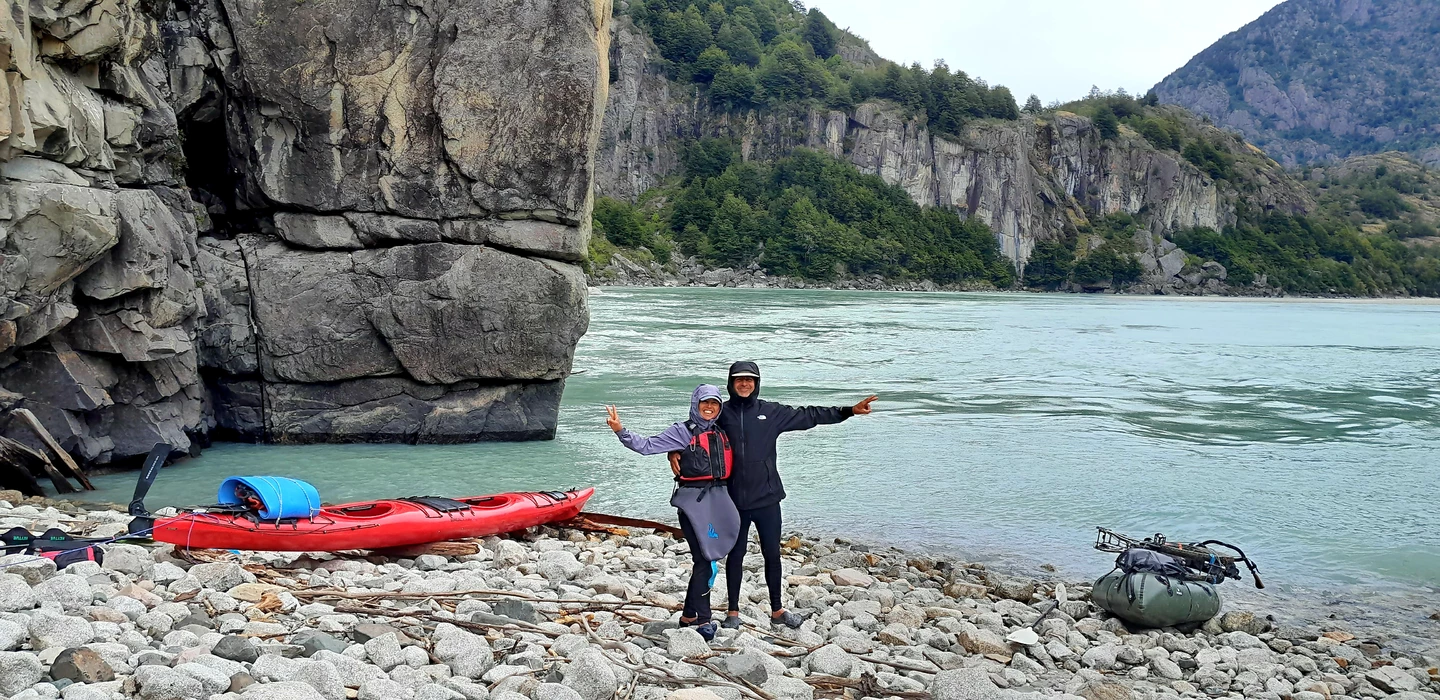
Just like me, they needed about 4 hours to carry the area yesterday. At the end it went a few meters over a rock wall down to the river. They waited for me and we continued paddling together.
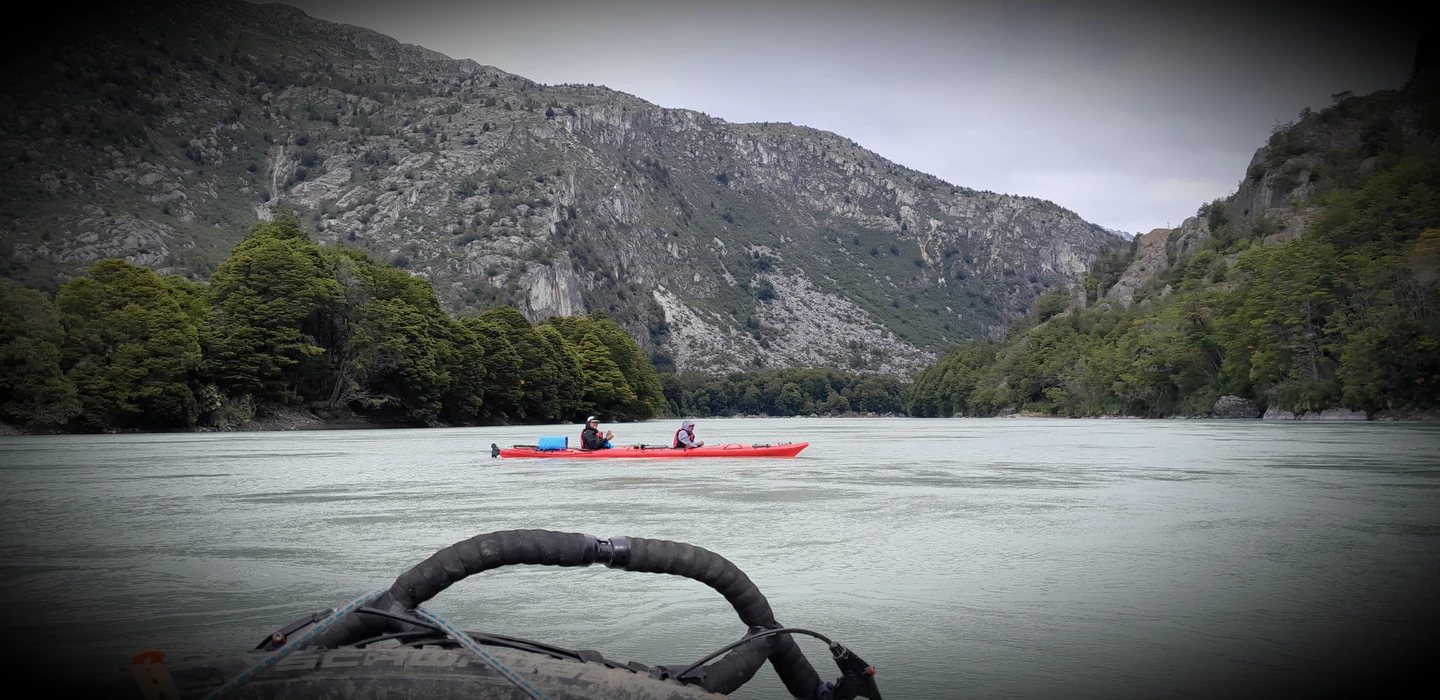
With their sea kayak they moved much faster than I did. With my packraft I had no chance of following them.

Despite the bad weather, we had a good view of the Northern Patagonian Ice Field (total area of 4,200 km²). The ice field, together with the Southern Patagonian Ice Field, which is about three times larger, is a relic of the Patagonian Ice Sheet. This covered large parts of the southern Andes 18,000 years ago (last glacial period).
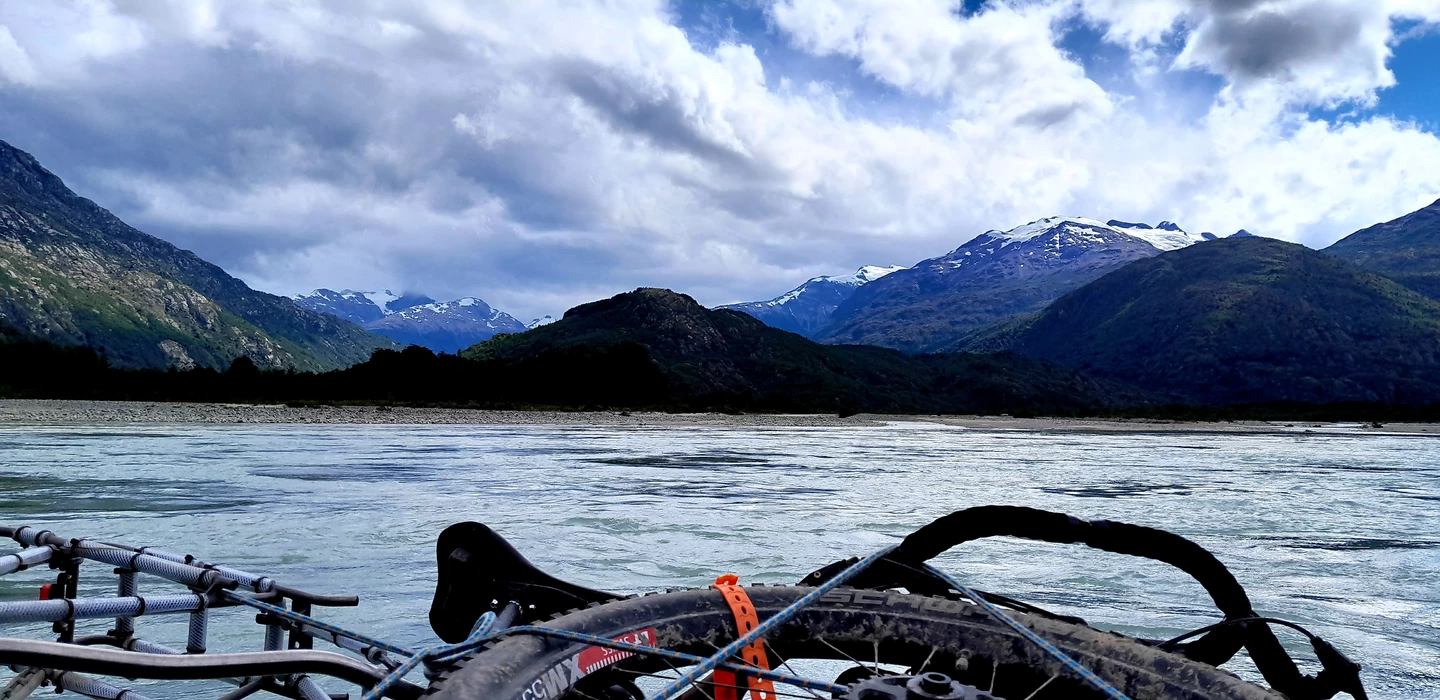
Soon it started to rain. Andrea got a contact through a friend near Lake Vargas. We turned off the main river into a small canal in Caleta Puerto Nuevo. It was much less windy here and there was a really peaceful atmosphere.
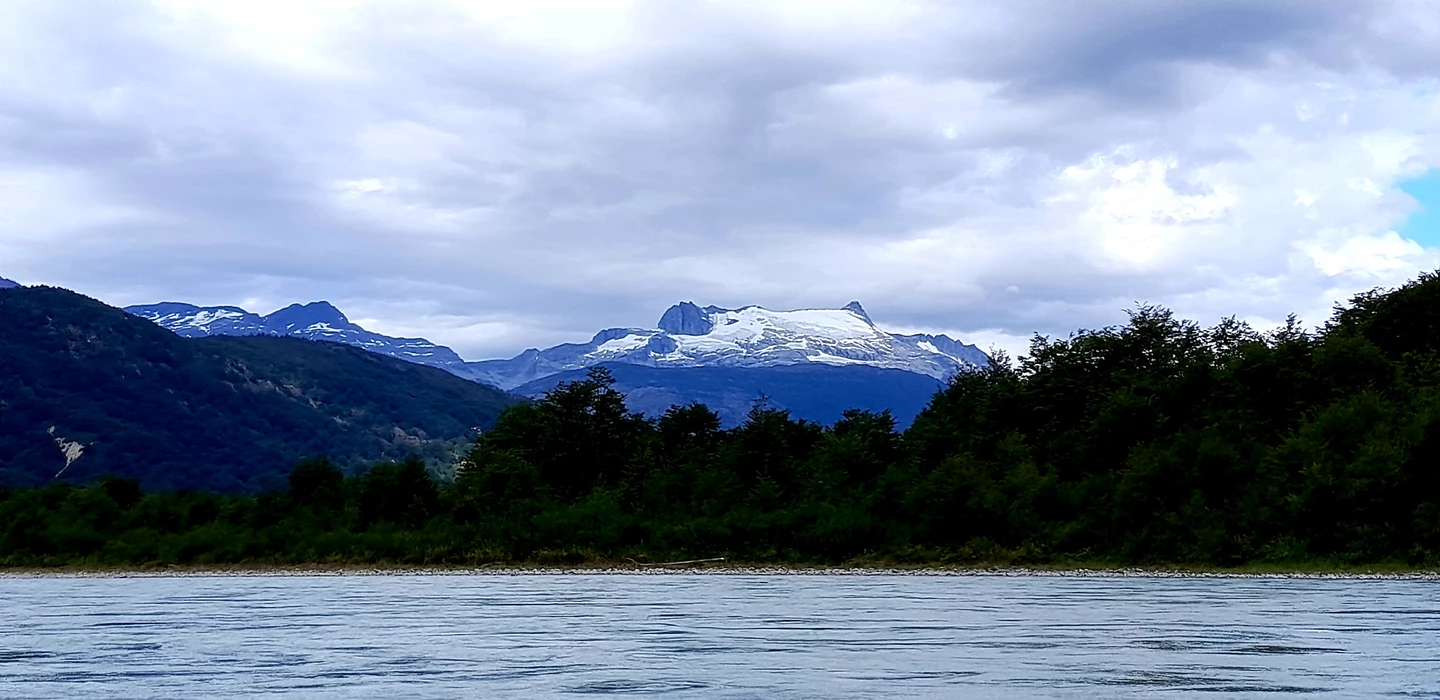
Towards the evening we reached Luis and his wife's house, where we were allowed to spend the night in a room on their farm. What a relief to have a roof over your head in this weather.

The two live here in a very remote area without electricity or running water. They feed themselves almost entirely with vegetables, fruits and herbs from their large garden. In the evening we were invited to a delicious dinner.

It rained and stormed outside most of the night. We took our time in the morning. I had to properly repair my hole in the packraft as the emergency repair hadn't held up in the cold water. We then had breakfast together with Luis.

It wasn't until around midday that we were ready to continue our journey. We were really lucky with the weather today. Although it was quite cold, there was almost no wind and it only rained briefly a few times.
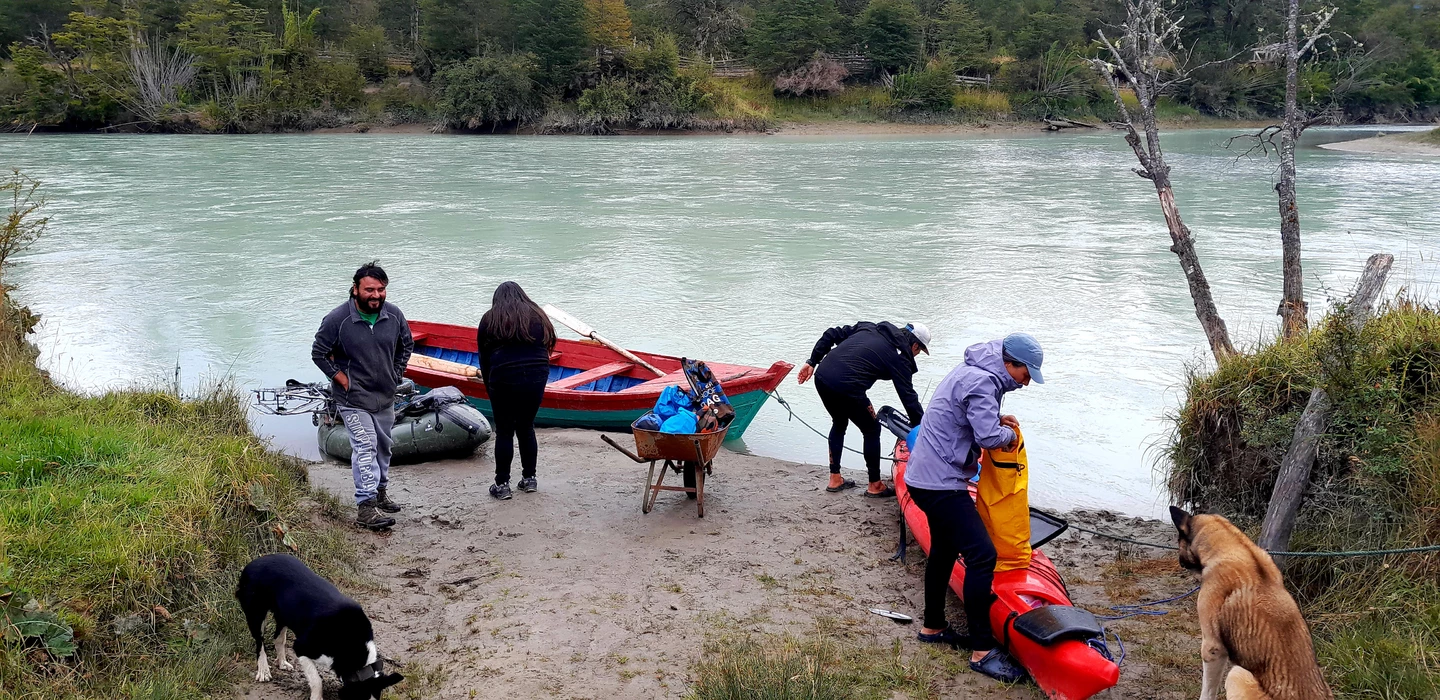
After saying goodbye to our great hosts, we first paddled out of the canal back onto the main river.
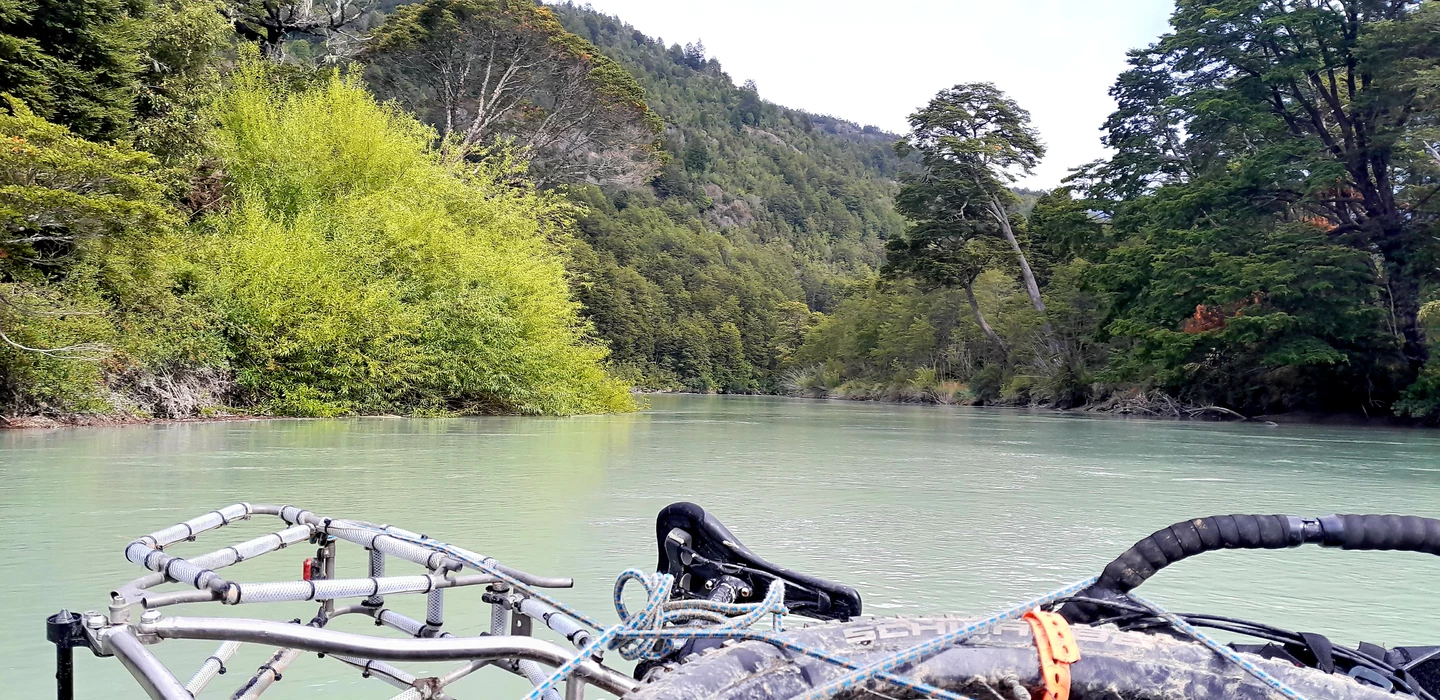
Most mountain peaks and glaciers were not visible today due to heavy cloud cover. We still had to overcome one last small class 2 rapid at the beginning, but it went well.
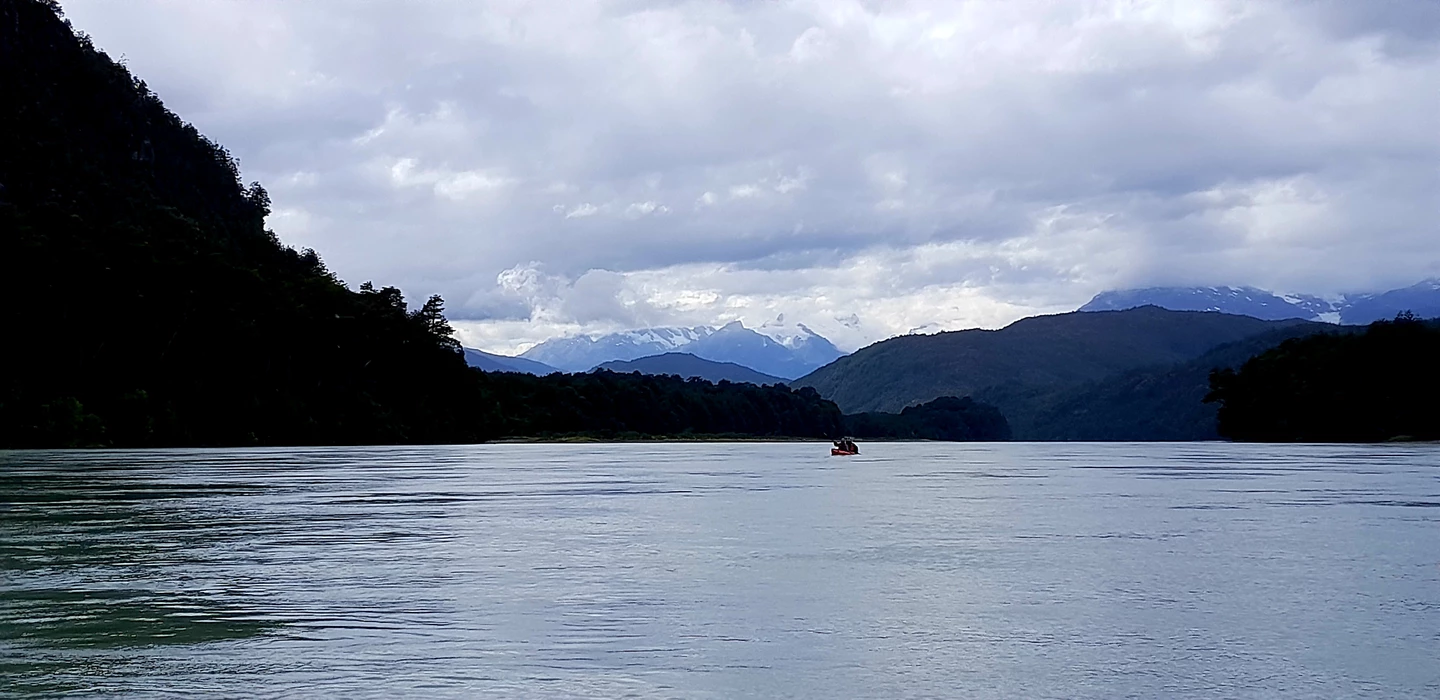
The repairs to my packraft this morning held up really well and I was almost able to follow along with the sea kayak. The Carretera Austral leads directly along the river here.

After about 2 hours of driving we had to stretch our legs for a bit. Thanks to the strong current we made very good progress. Only the cold wasn't so pleasant.

If you consider that the two Patagonian ice fields are only the remains of the original ice sheet, it is only when you look at them that you realize how big the whole thing once was.
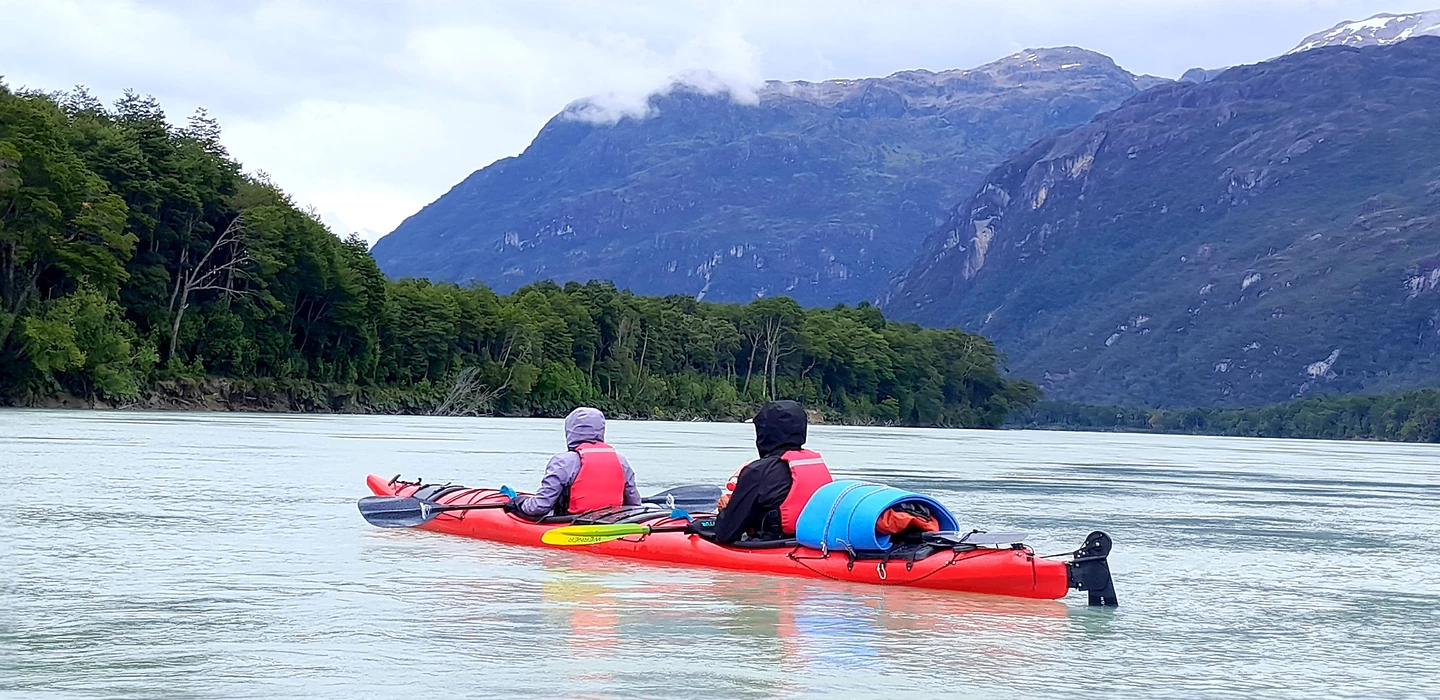
At around 3:00 p.m. we were still about 20 kilometers from Caleta Tortel and decided to take a quick break for food on the shore.

As we continued our journey, individual mountains kept coming out of the clouds. Unfortunately, there are only a few rivers in the world like the Rio Baker that flow freely over such long stretches (without a hydroelectric power station).

I felt a little like a tiny drop of water in a huge river in these last few kilometers. In moments like these you realize how small we humans actually are in relation to nature.
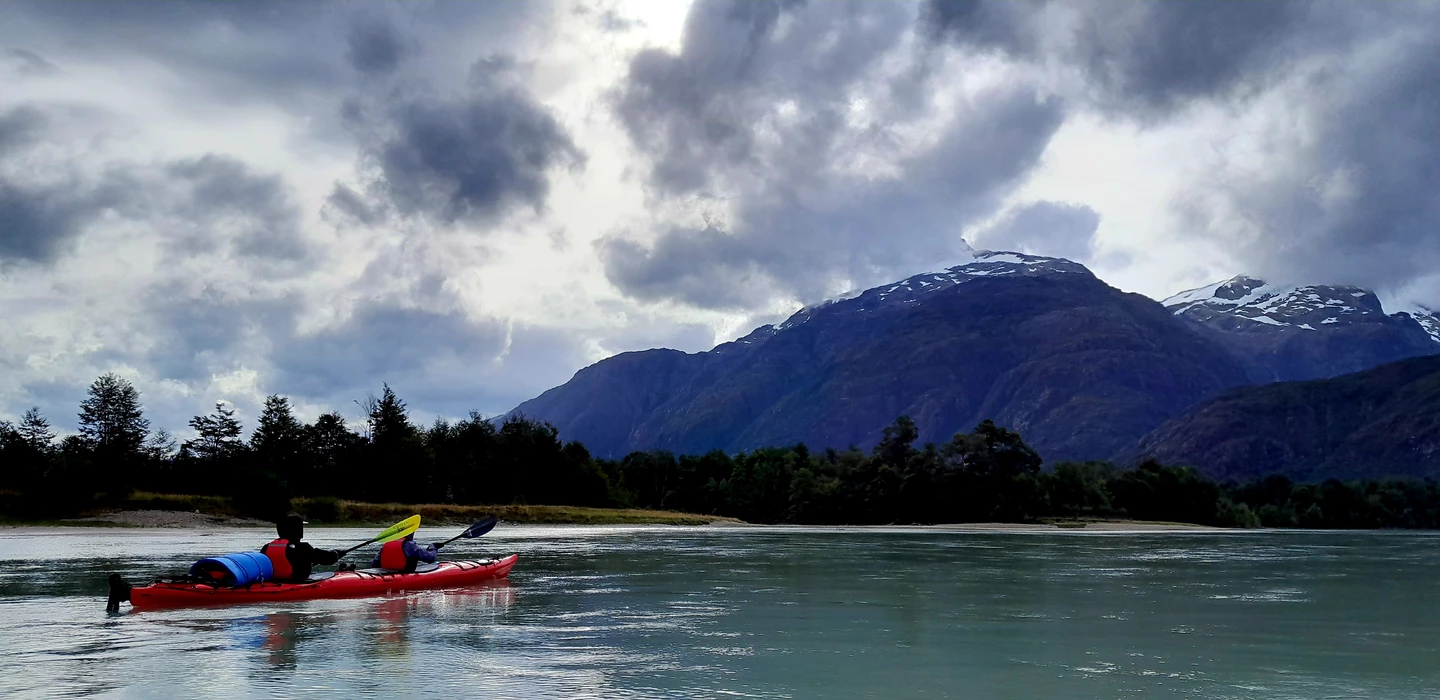
Shortly before the Rio Baker flows into the Pacific Ocean, we turned into a side canal that leads to the Aerodromo Enrique Mayer Soto airfield.
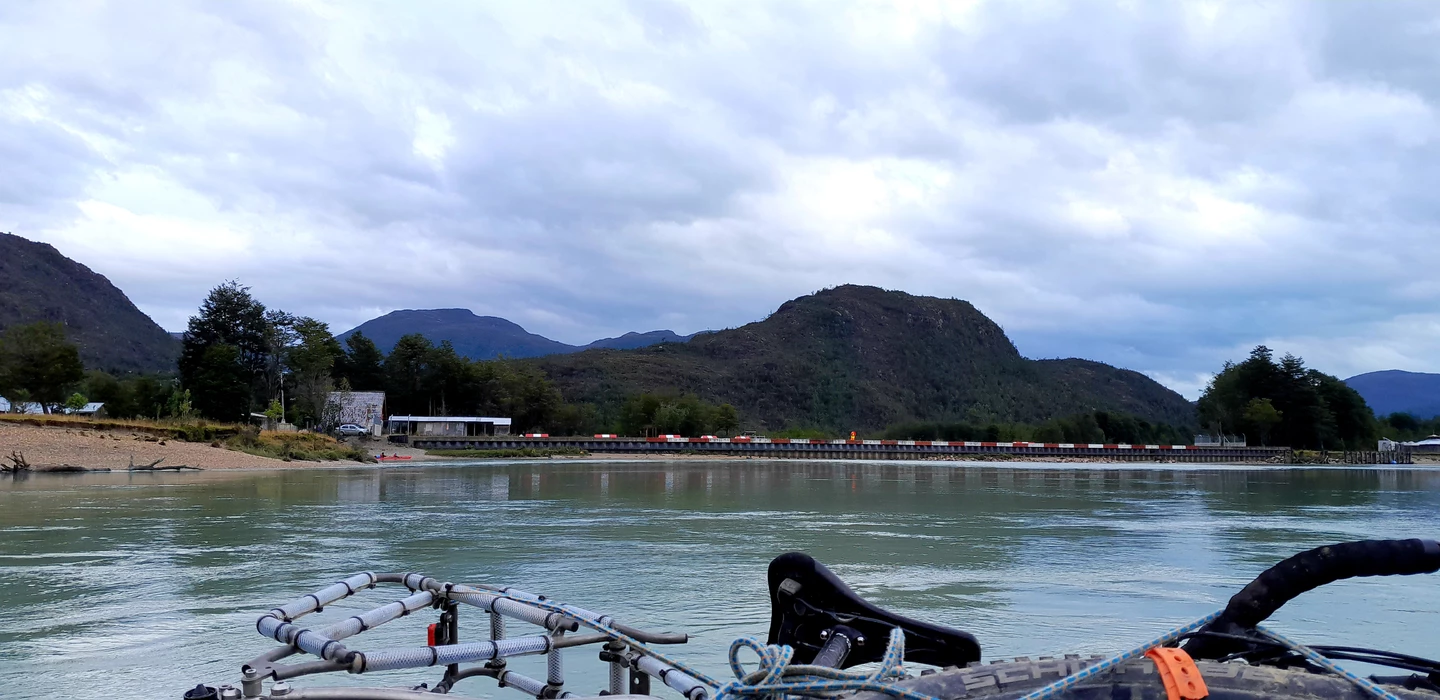
Andrea left his car here. We got out and started loading all of our things into the vehicle. The sun gave us a few warming rays.

After everything was stowed away, Andrea drove ahead in the car and I followed him on the bike to the end of the street. We parked the car there and started looking for accommodation.

We found a hostel not far from the parking lot as darkness fell. After a warm shower, I went to a restaurant where I ate a delicious fish to round off this great adventure.

Caleta Tortel is a lumber town with an intricate walkway system built by the town's inhabitants which run several kilometres around the cove (Caleta).

Without these walkways , the only way to communicate and travel between houses would be by boat, given the density of the vegetation and the steepness of the hills around the cove. The walkway system has become part of the town's culture and a local tourist attraction.
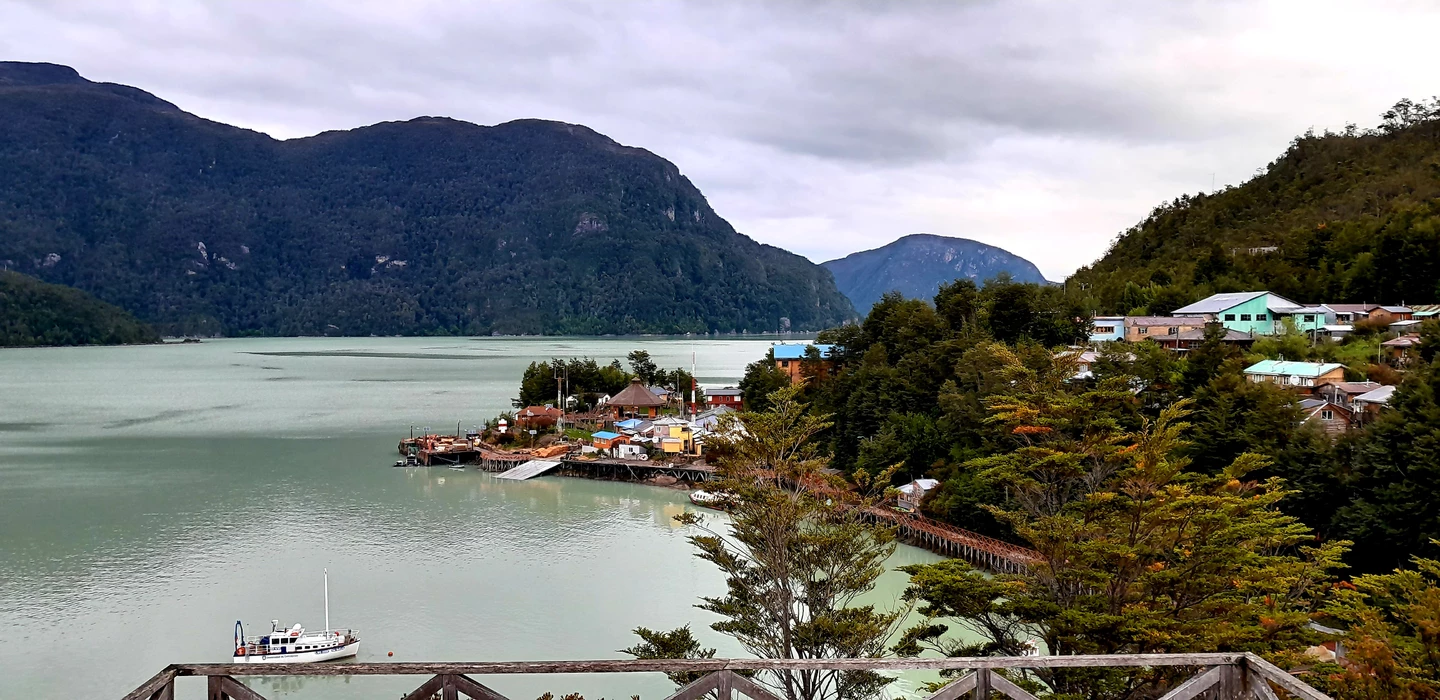
First I tried to get a ticket for the ferry to Puerto Natales the next day. However, the office was closed. So I started carrying my bike and then my luggage down the many steps.
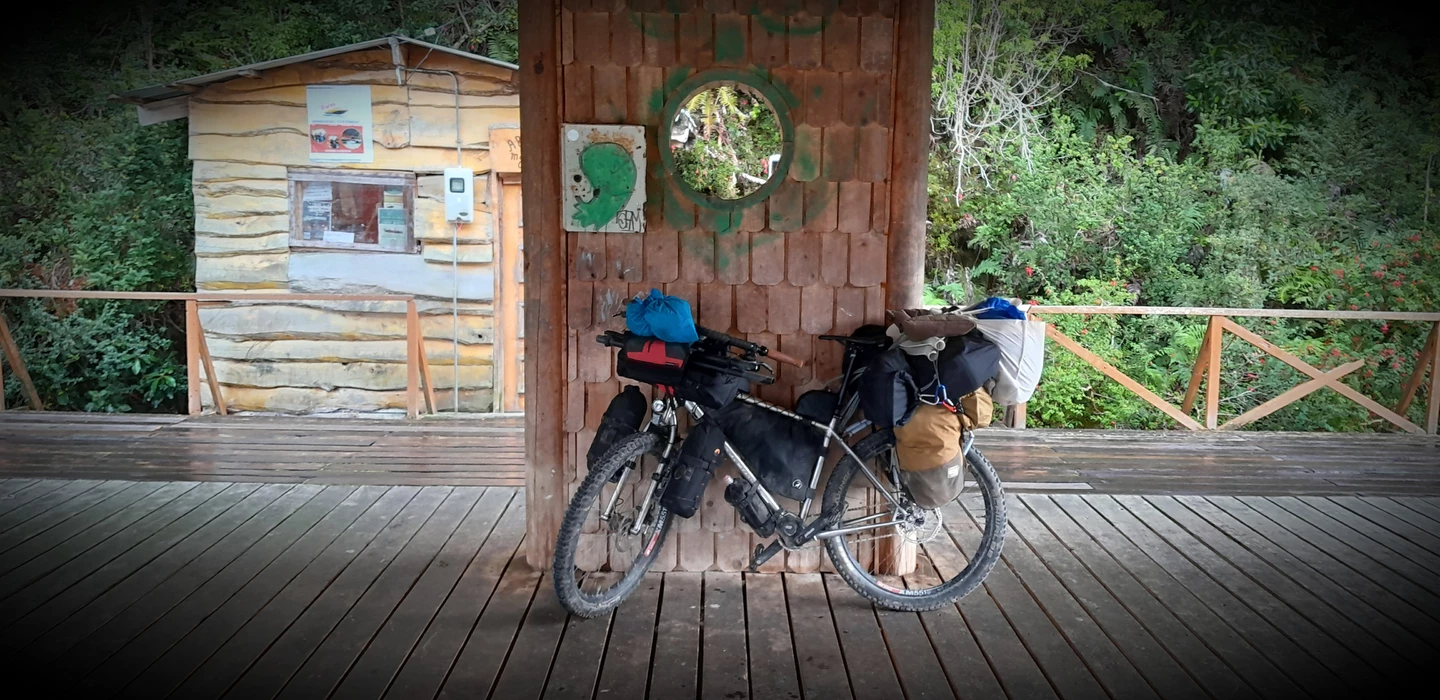
Andrea and Anne Maria helped me with that. Afterwards I unfortunately had to say goodbye to them again. They want to head north to warmer areas. Thank you for the great time!
During the whole event, Joe spoke to me. He also travels by bike, is originally from England and also wants to take the ferry to Puerto Natales.
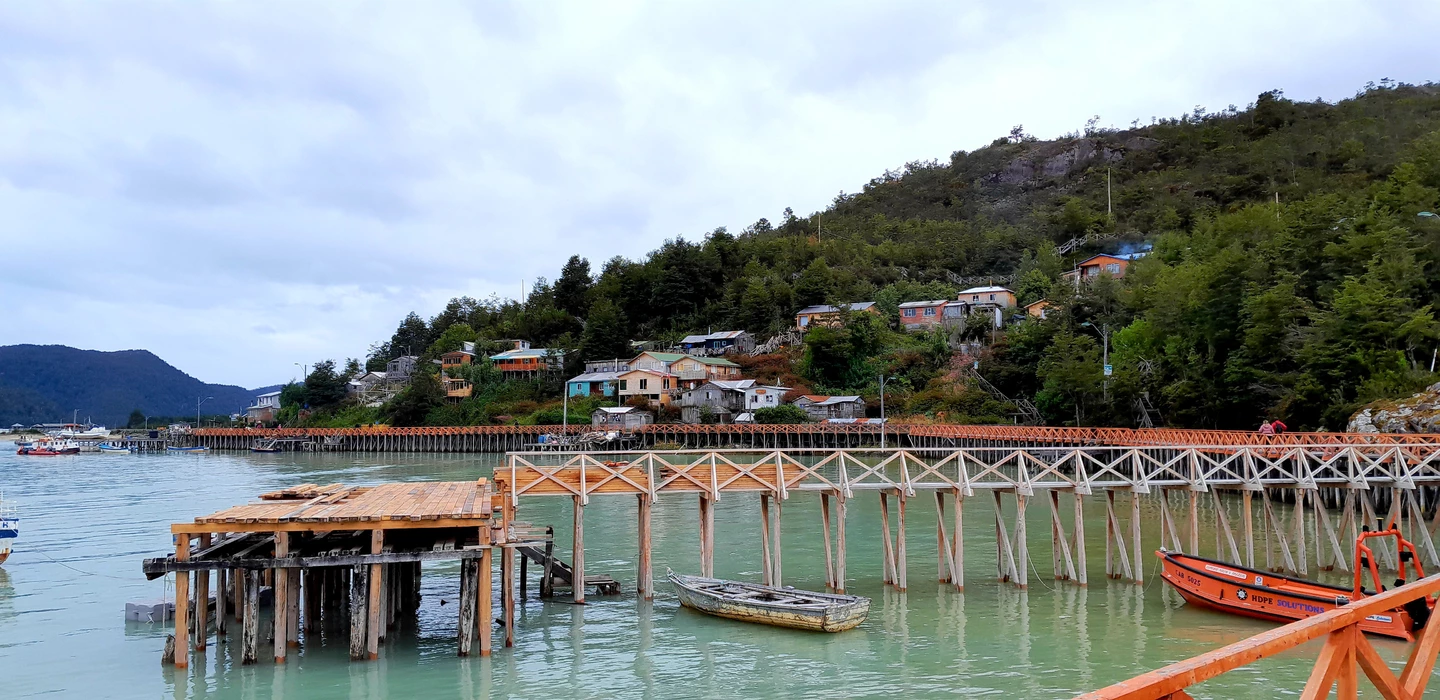
I then started looking for accommodation for the next few days. Almost at the other end of the town I found a suitable place to sleep in the Hospedaje Albita.

Albita has spent her whole life here in Tortel and knows all the people in charge of the ferry in town. She contacted them to make sure I still got a ticket.

After putting all my things in my room I made my way to Sendero Cerro Vijia. This path leads around the entire peninsula.
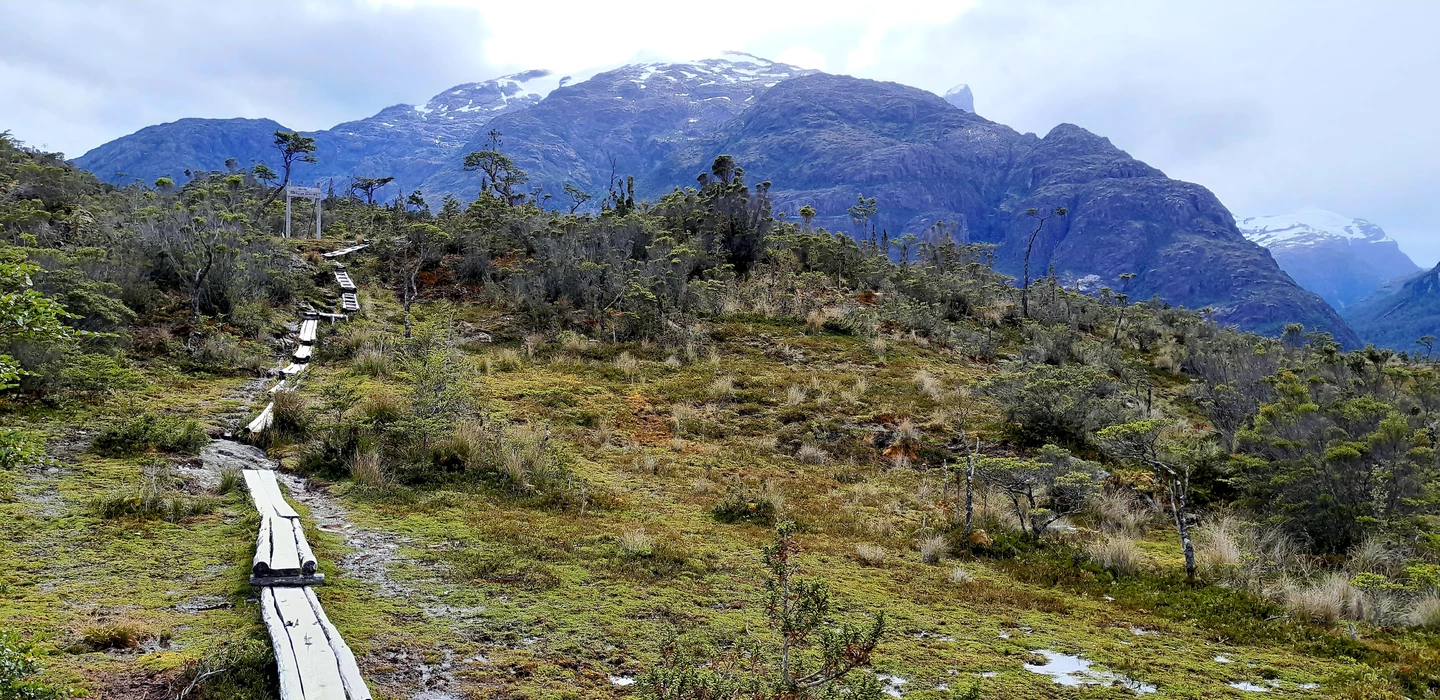
From above you have a beautiful view of the Rio Baker confluence with the various islands in it. Among other things, the Isla de las Muertes.

The island served as a cemetery for a group of workers from the Baker Company who died there under strange circumstances at the beginning of the 20th century. Today the island is considered a cultural heritage site.
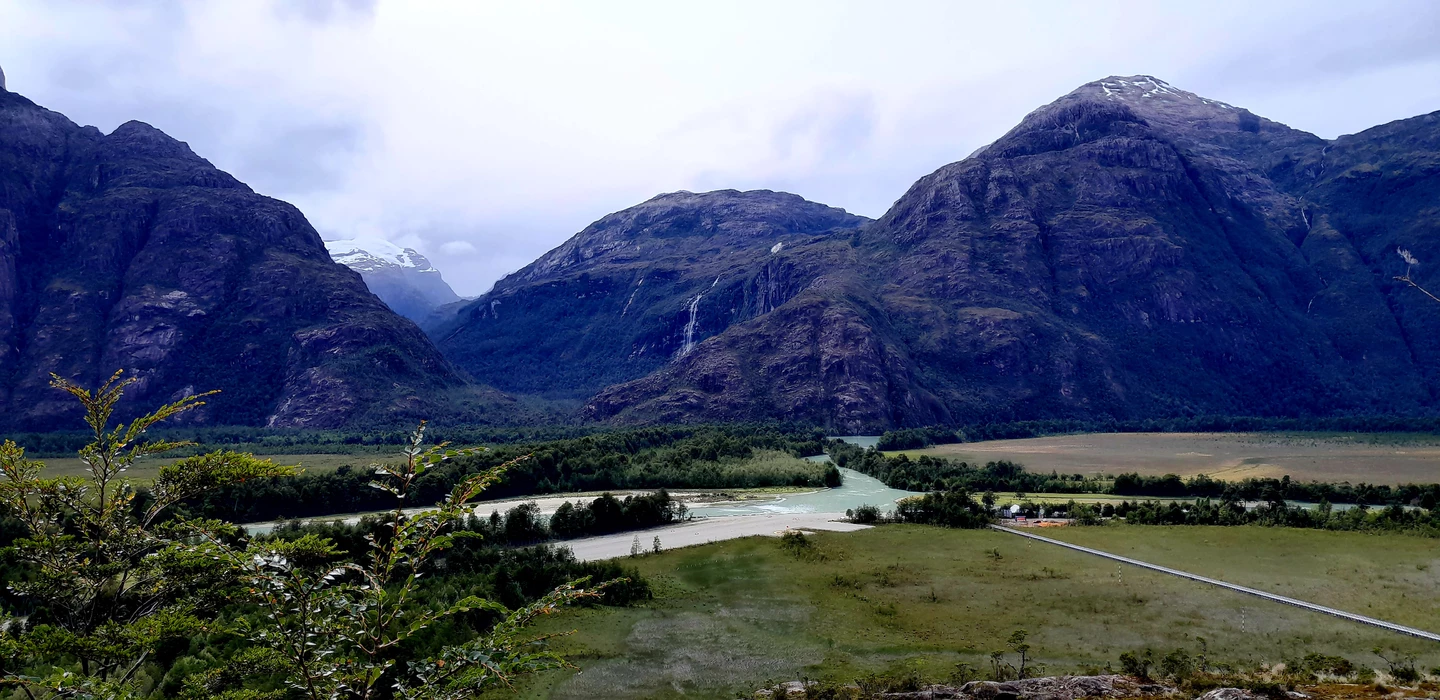
The path is not very well maintained in some places and is quite boggy. Despite the bad weather, the round trip was worth it.
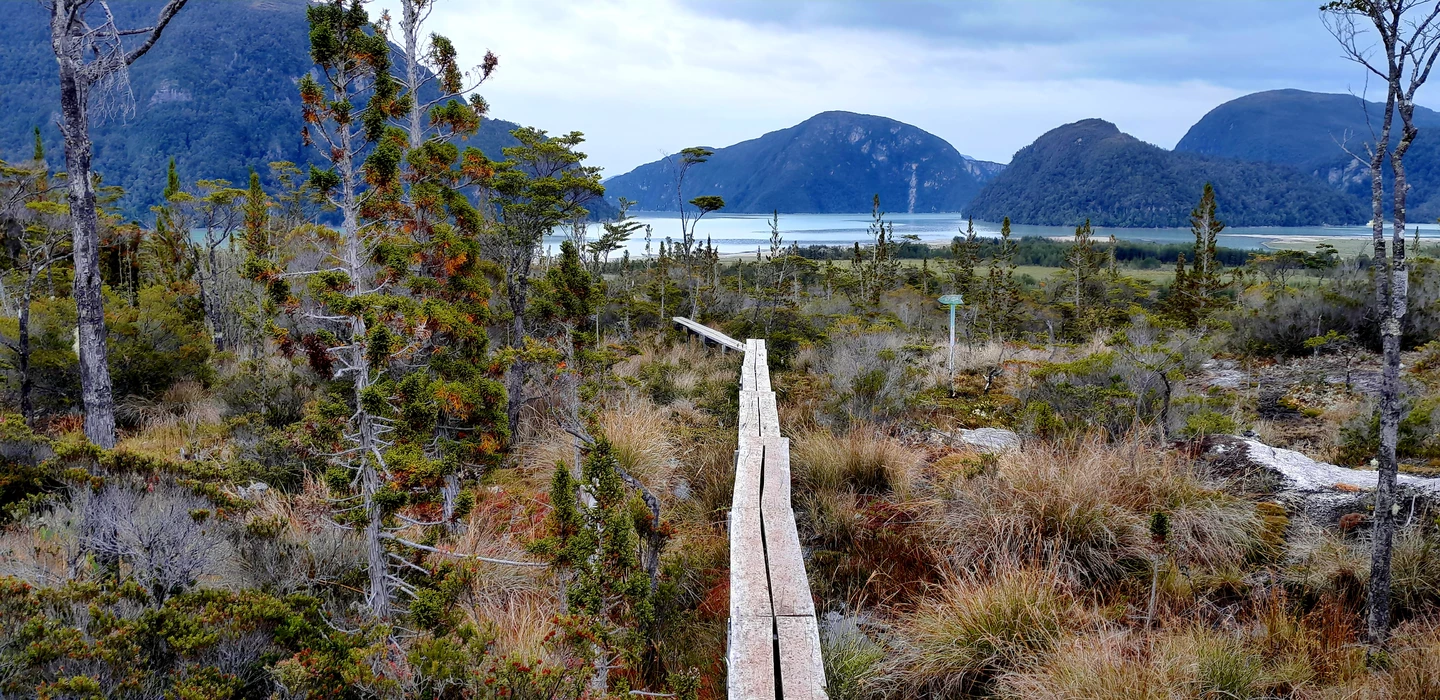
The next day I was actually able to buy my ticket for the ferry. The weather remained consistently bad and the snow line got quite low.
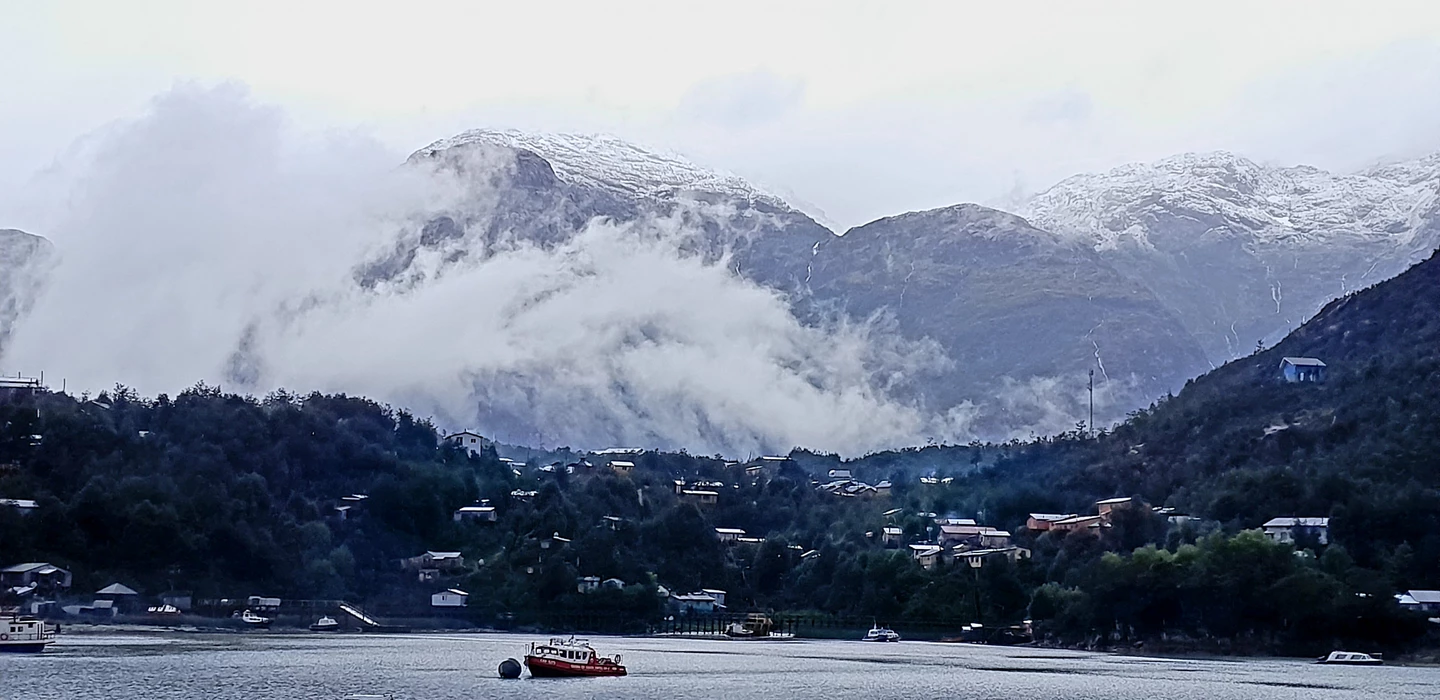
Luckily I had a roof over my head and Albita made a delicious breakfast with homemade rolls and jam every morning.
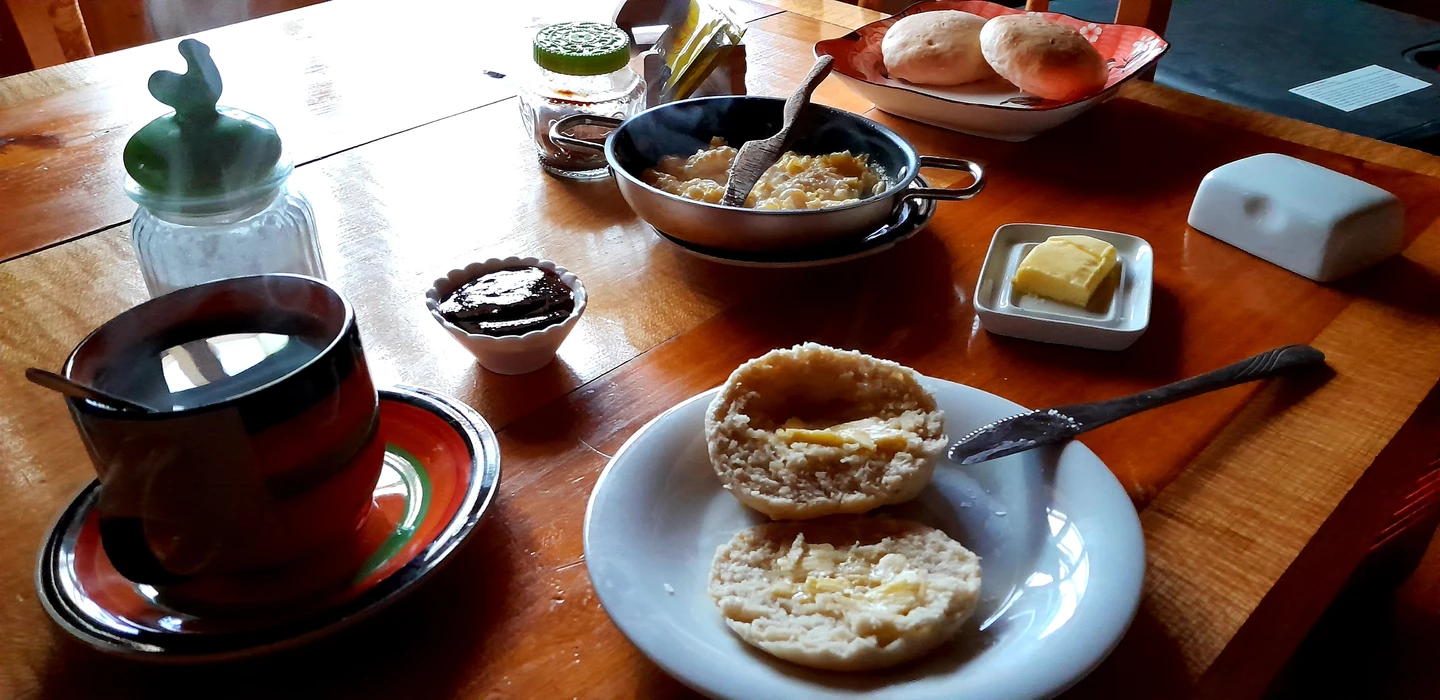
My stomach still hadn't fully recovered. In Cochrane I got some anti-diarrheal medication from a pharmacy and slowly it got better.
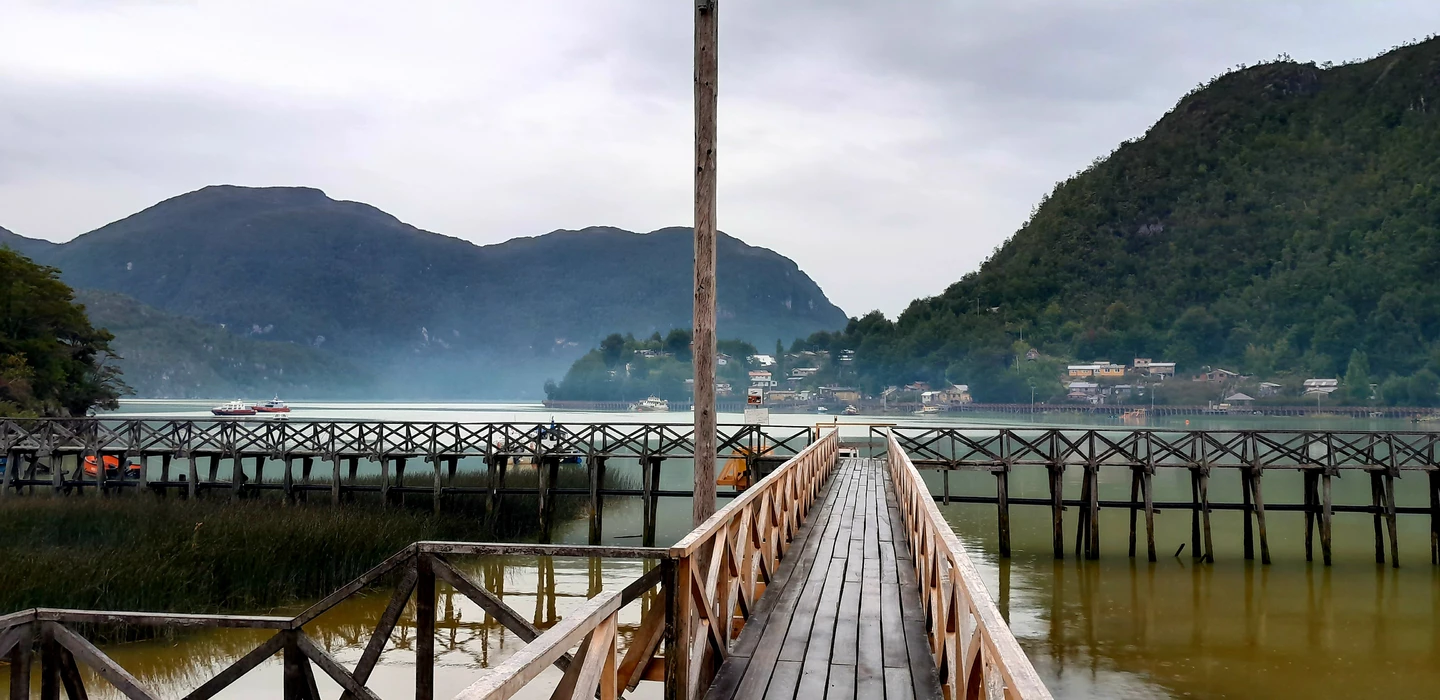
The ferry only runs once a week, on a Saturday. I still had 2 days left before departure. I mainly spent this time walking through Tortel.

I got to know other cyclists who also go on the ferry. The Carretera Austral ends in Villa O' Higgins and from there progressing is quite difficult due to the current weather conditions. That's why some people have decided to take the ferry as an alternative.

On Saturday evening there were 18 of us cyclists at the harbor. It's a nice feeling to be out and about with so many other like-minded people. The ferry was only loaded around midnight and the journey started with a delay of 2 hours.

I couldn't sleep particularly well on the ferry. That's why I was already on the deck at sunrise in the morning and admired the beautiful landscape. Despite the bad weather, you could see a lot of the surrounding area.
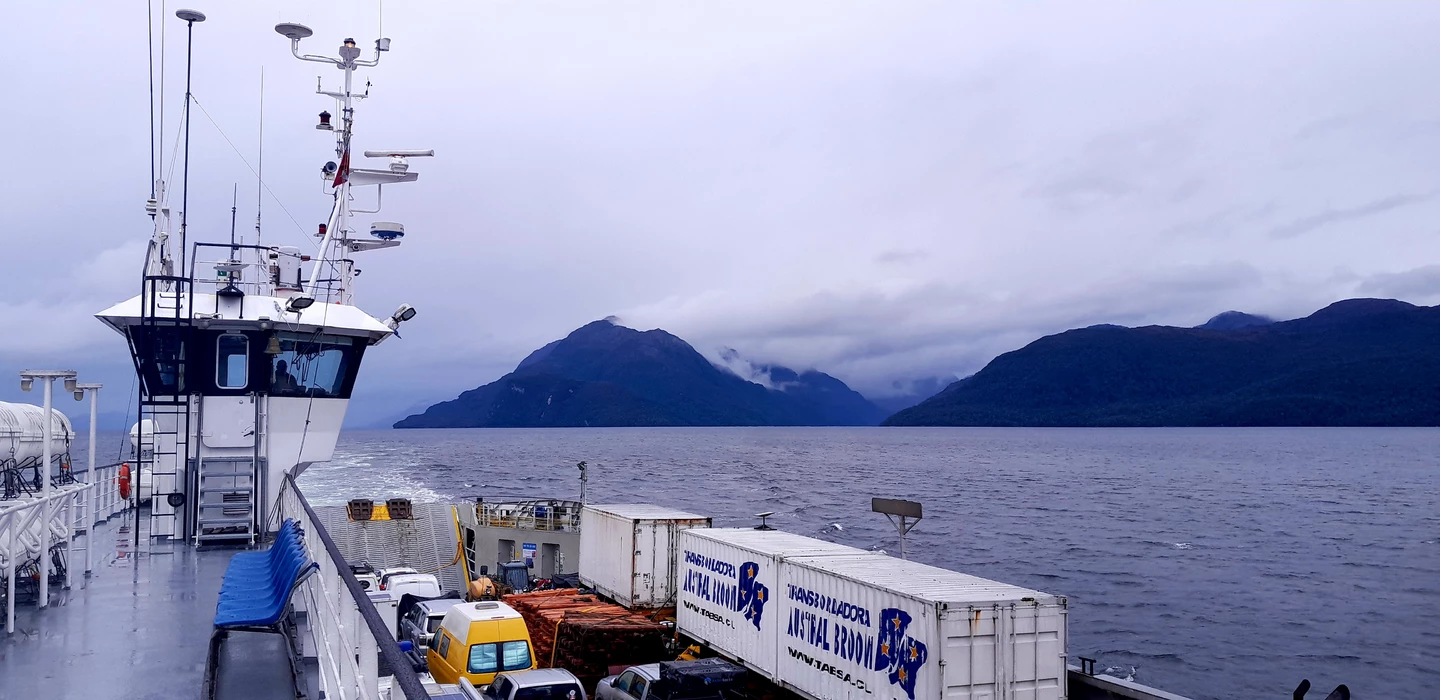
We passed a shipwreck in the Messier Canal. The Captain Leonidas (originally: Molda) was built in Bremen in 1937 and ran aground here on April 7, 1968. The cargo ship was carrying sugar and came from Santos, Brazil.

The ship sits on the top of a submerged mountain, the Bajo Cotopaxi. The holes in the side walls come from the Chilean Army, who used the ship for target practice. The government has mounted a light and reflector on the wreck's masts, which act as a lighthouse for shipping traffic in the area.
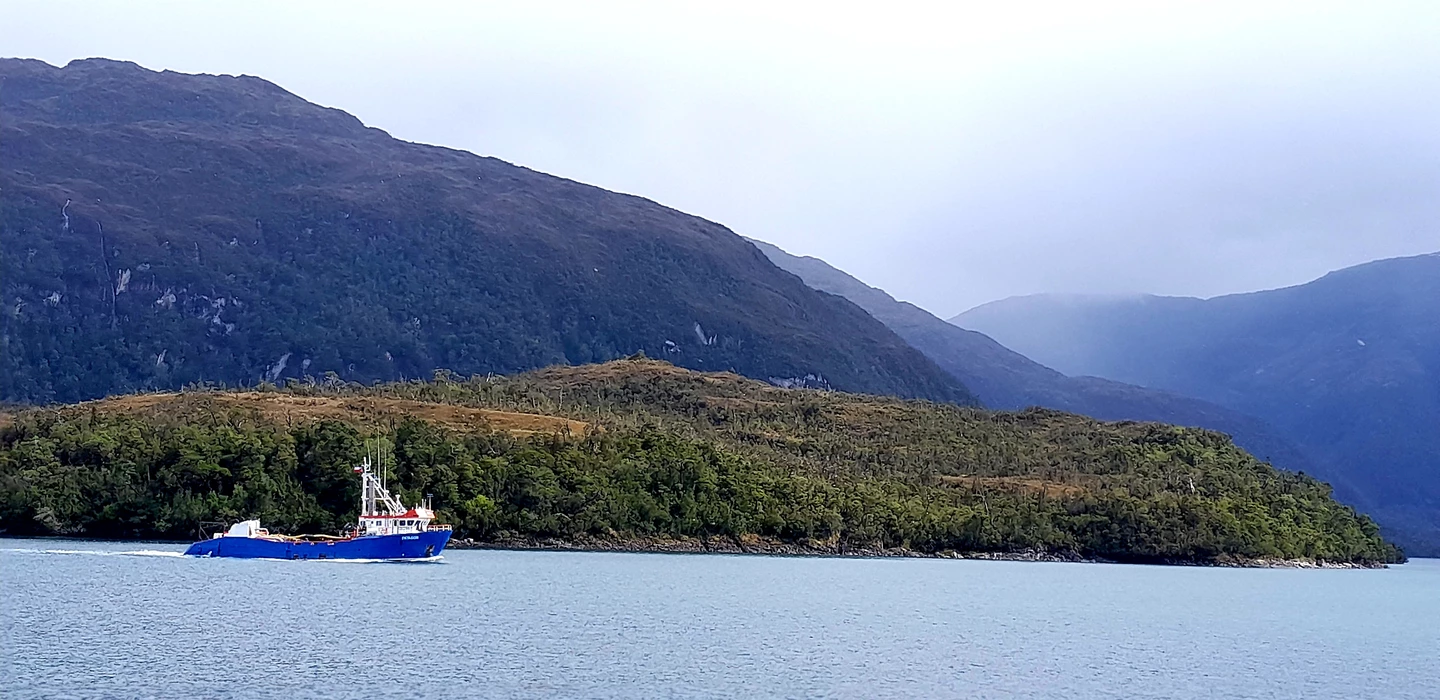
I found the view of the Southern Patagonian Ice Field really impressive. Individual mountain peaks and glaciers repeatedly appeared from the clouds.

The Southern Patagonian Ice Field (Campo de Hielo Sur) is the largest glacial area in the Southern Hemisphere outside Antarctica. The length of the glacier area in north - south direction is 350 km, the width is usually between 30 - 40 km and the area is approximately 18,000 km² (almost half of Switzerland). It is considered the largest freshwater reservoir in South America.
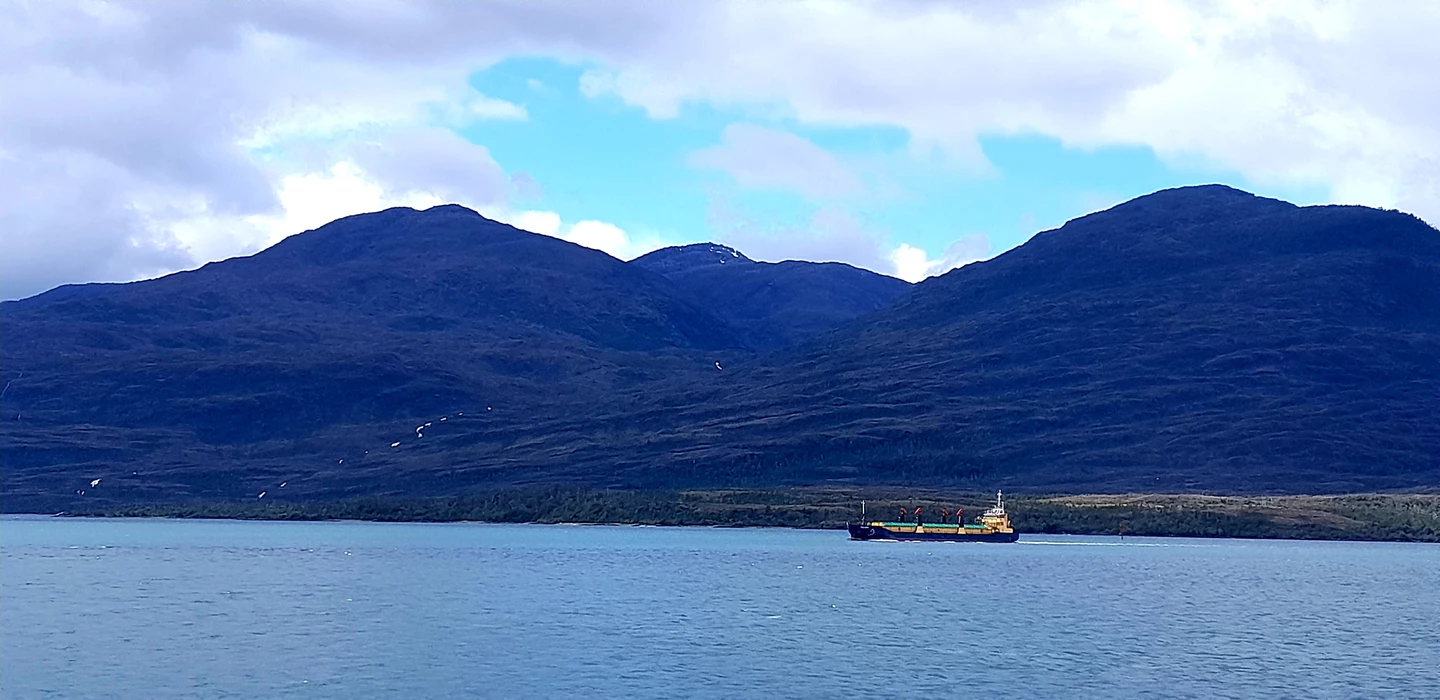
We reached Puerto Eden around midday. We were allowed to go ashore here briefly, but the harbor was cordoned off and we couldn't get into the town.
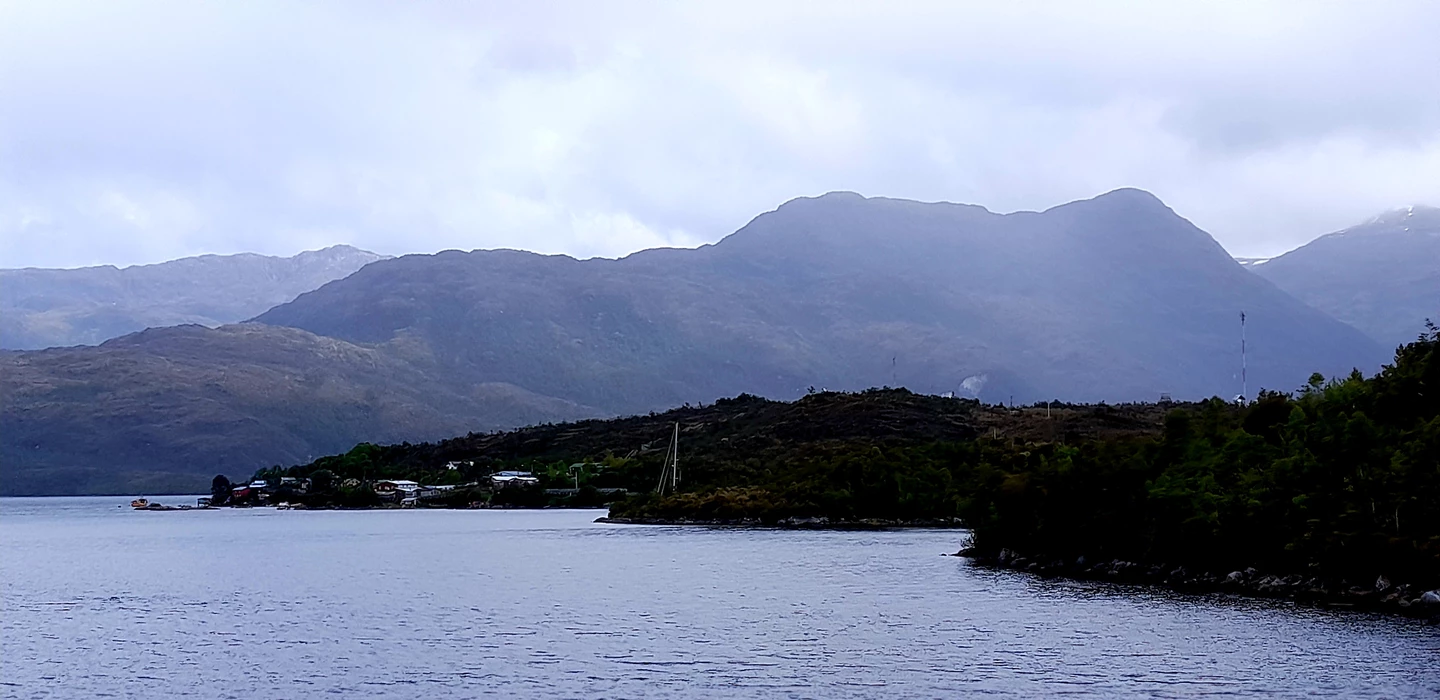
At least we were able to buy some empanadas here. A welcome change from the food on the ship. As we continued our journey we went more and more through the fjords, which I really liked.
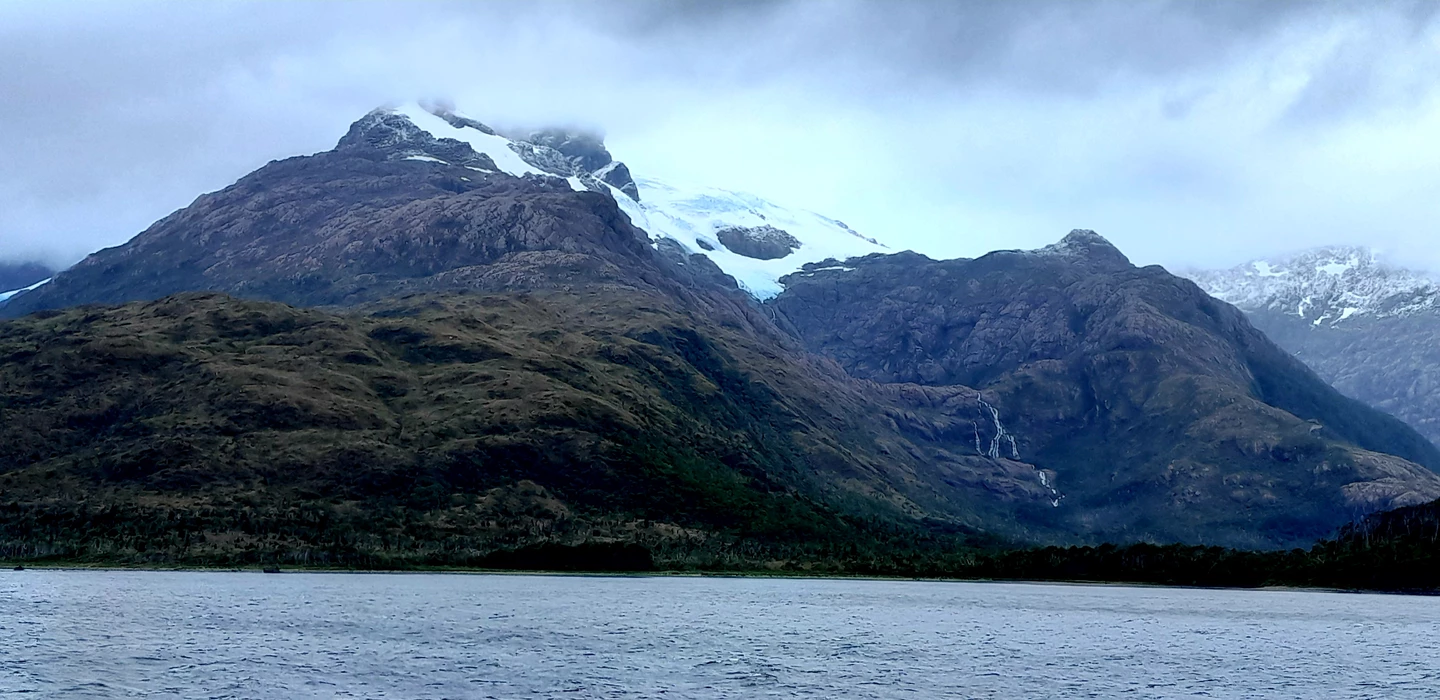
Fjords are created by valley glaciers that flow downwards from their source area through existing river valleys. The original valley becomes wider and deeper and takes on its typical shape as a U-valley.
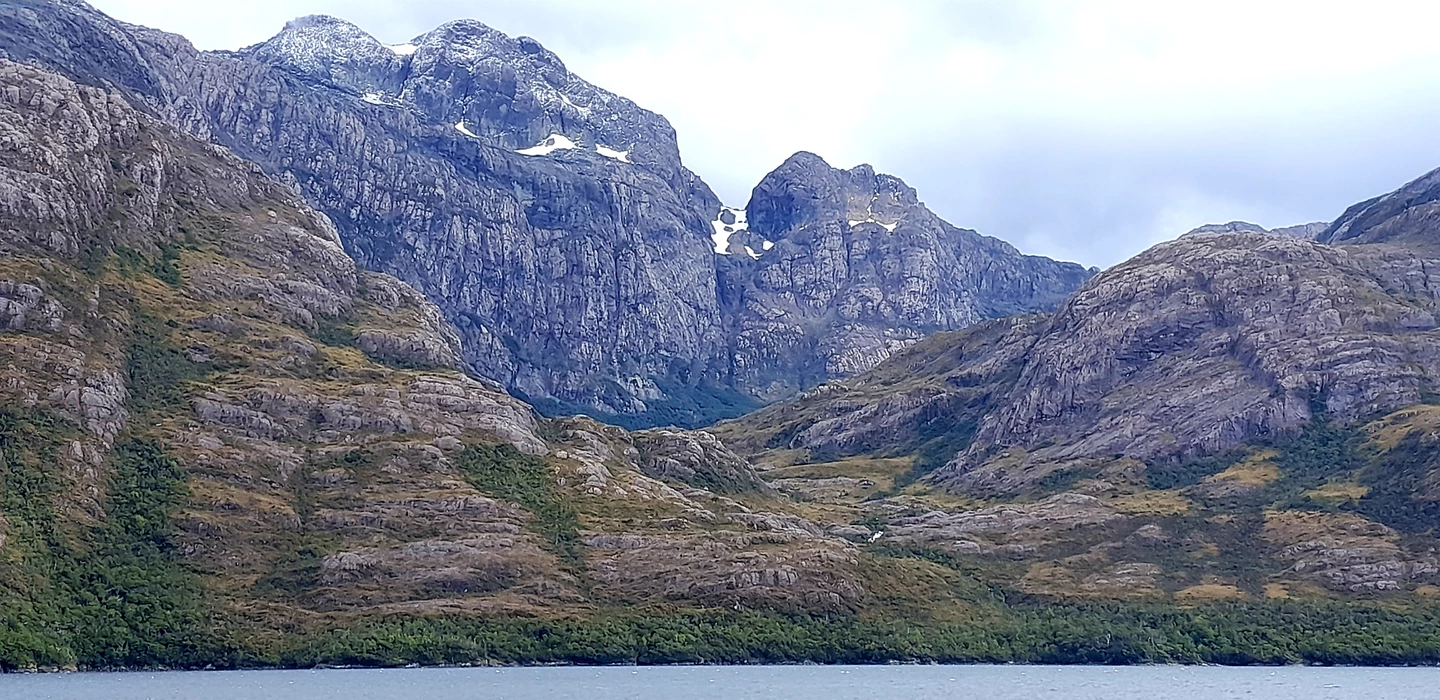
Fjords can be found wherever mountains near the coast were or still are heavily traveled. During the ride I also started talking to the other cyclists.
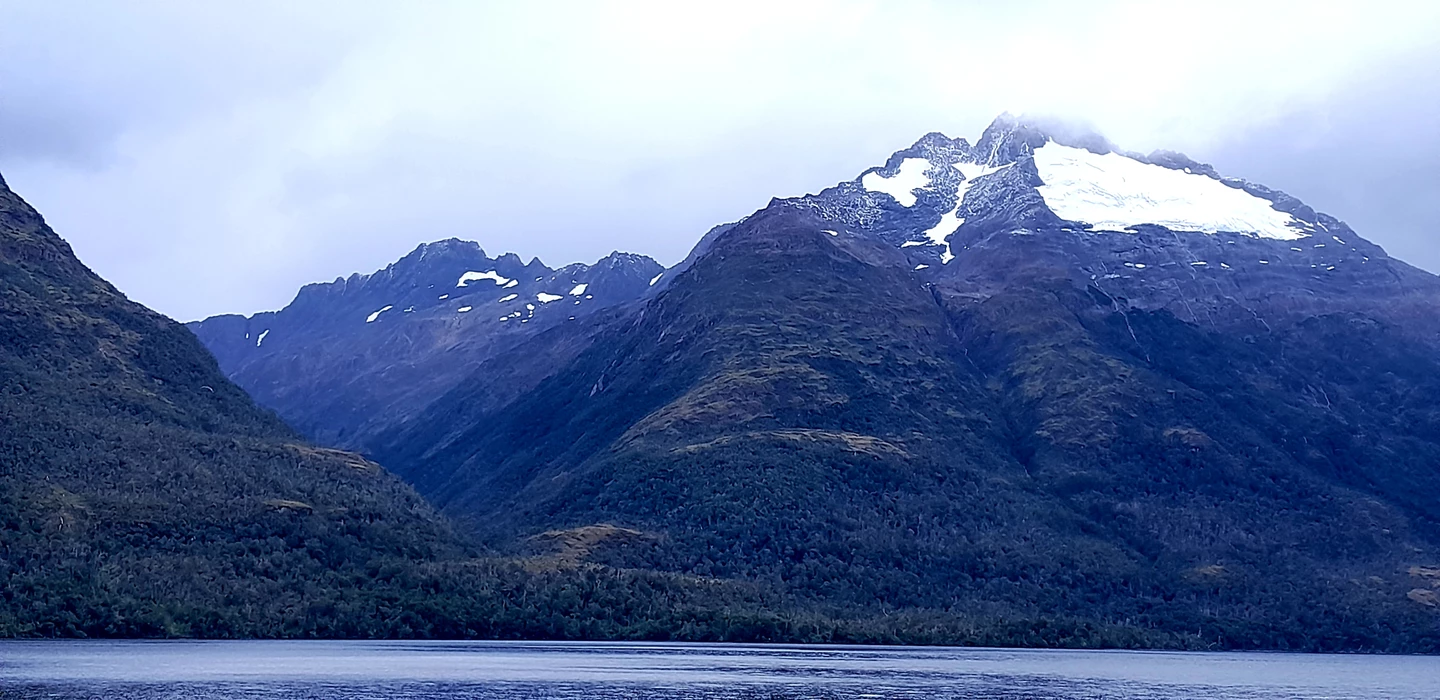
Traffic here in Chile was particularly the focus of our discussions. We all agreed that the local drivers were very reckless. You notice immediately when tourists overtake you.

They reduce the speed and overtake with enough distance, while the Chileans simply rush past you at full speed, which is extremely dangerous. After almost 45 hours of travel, we reached the port of Puerto Natales around evening on the second day.

Together with 2 cyclists from Innsbruck who were traveling with their dog, I cycled to Camping Guino. Patagonia has ended here and I am now looking forward to continuing my journey through Tierra del Fuego.